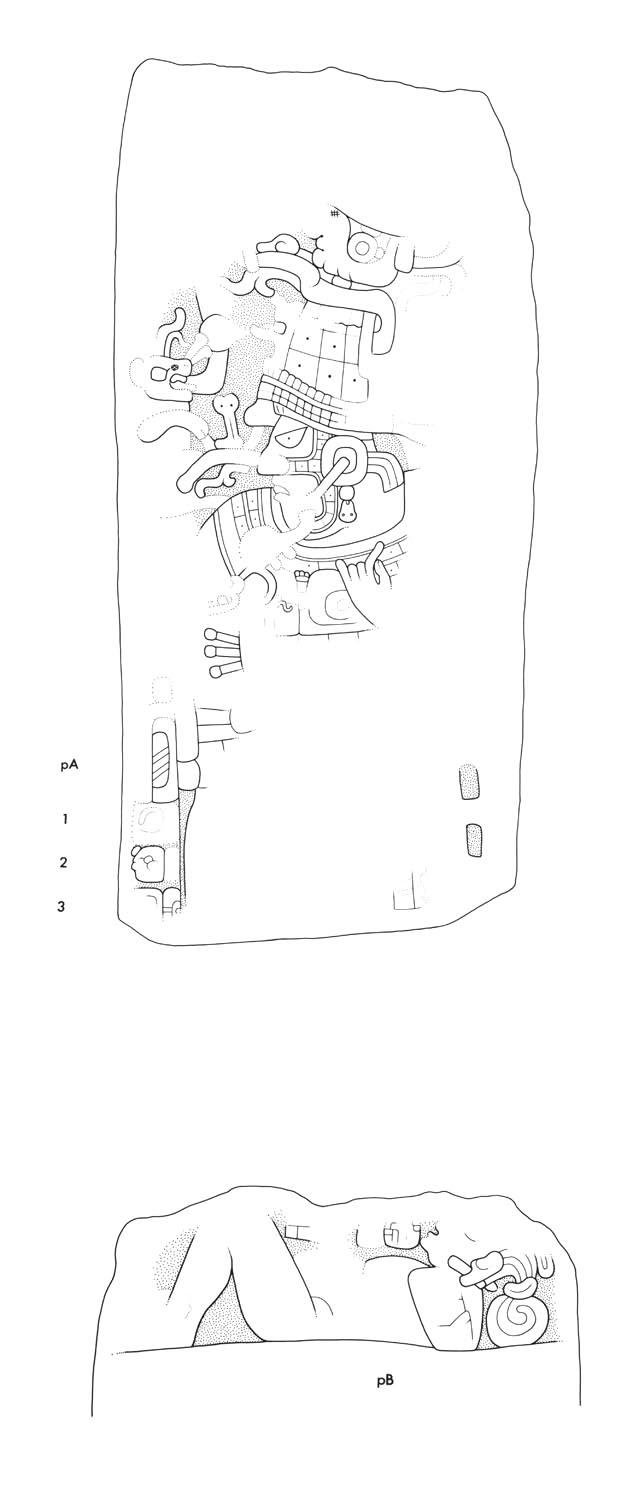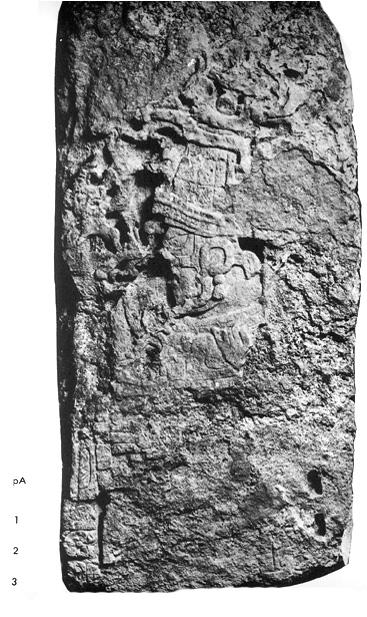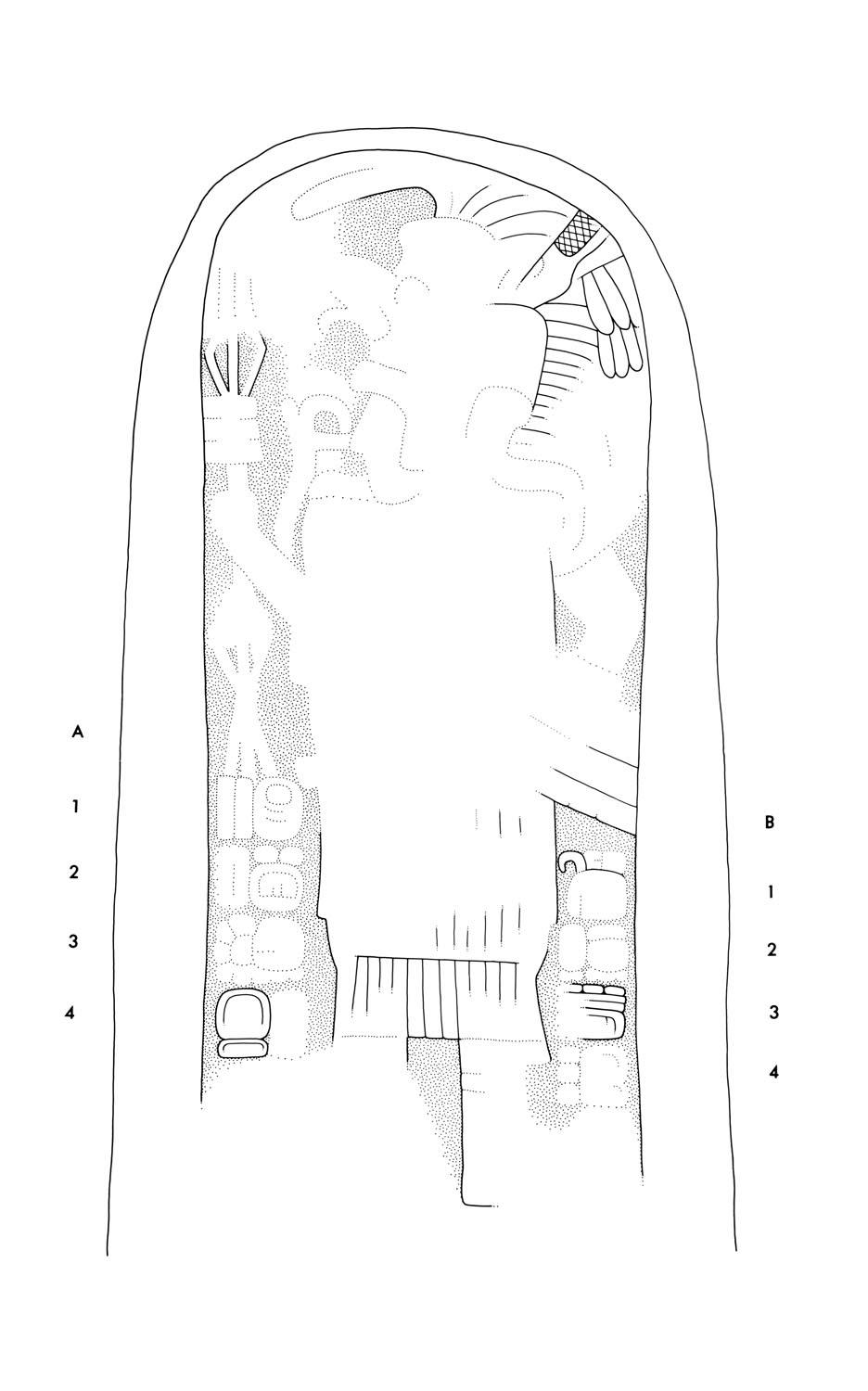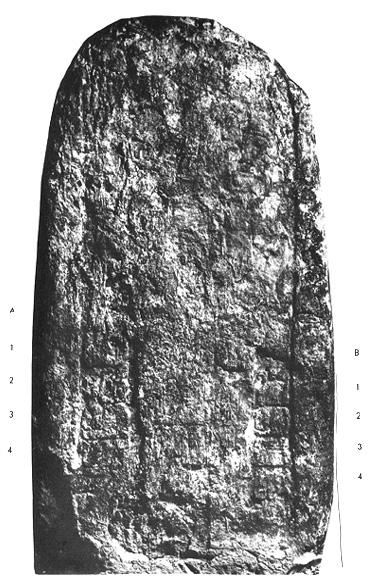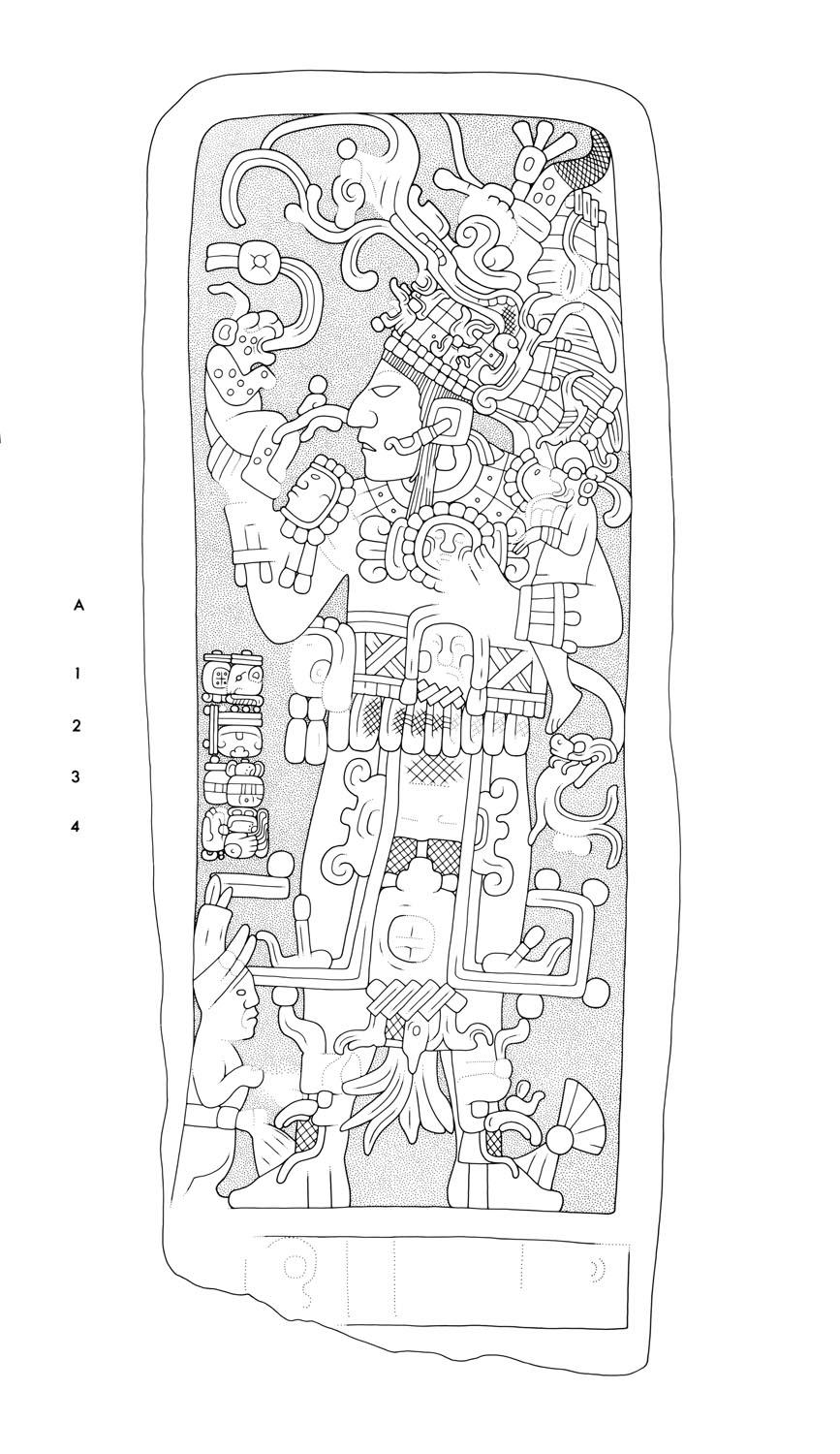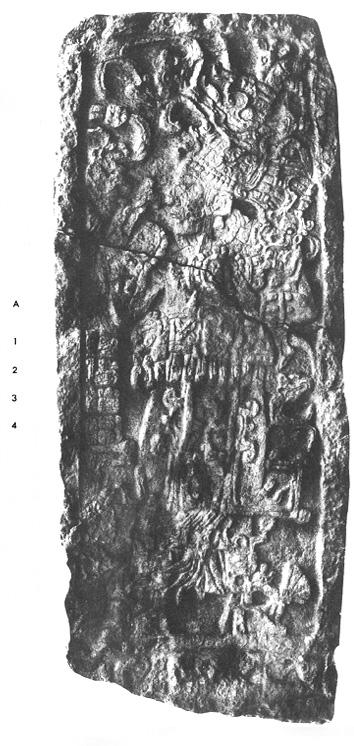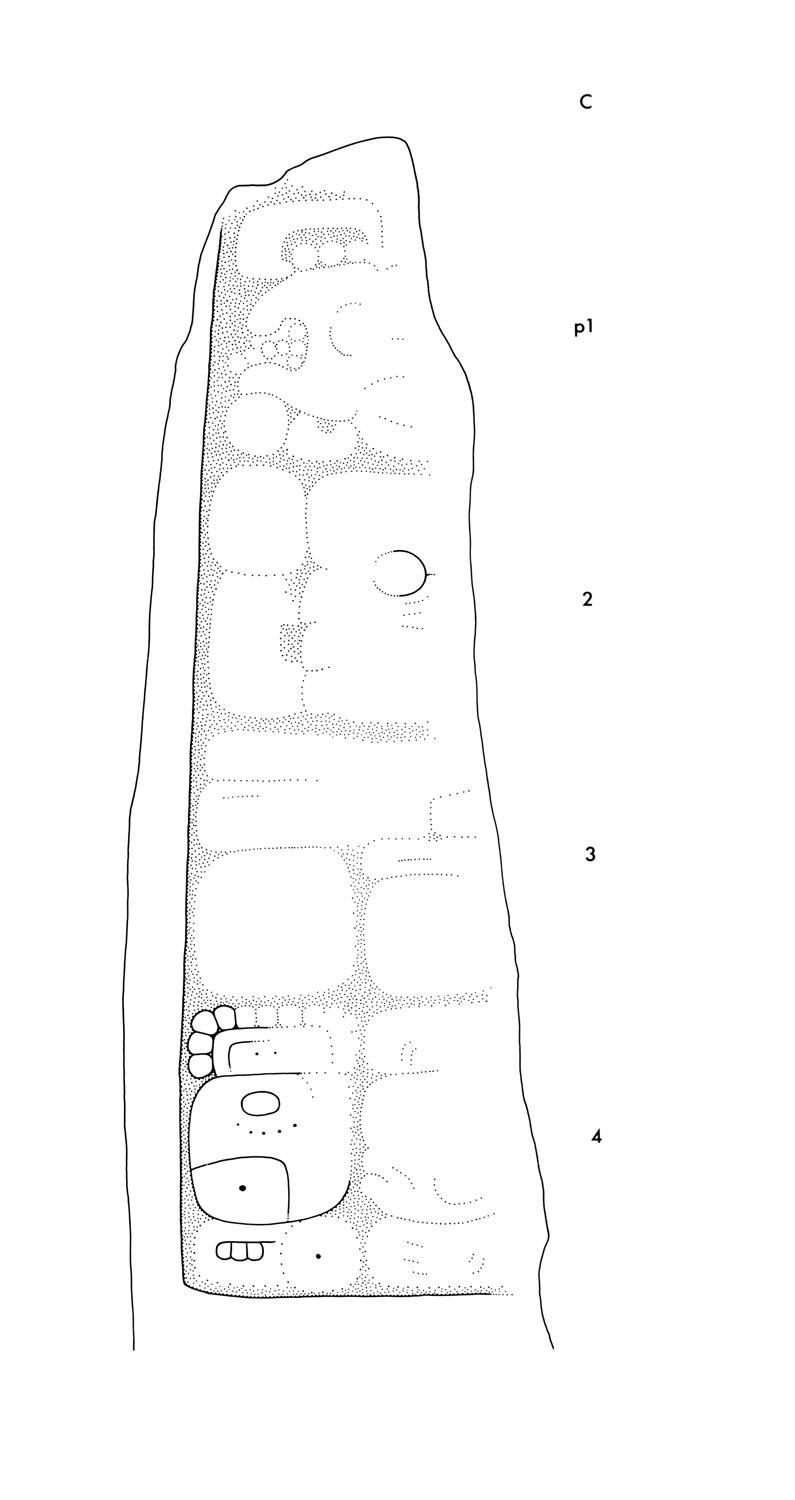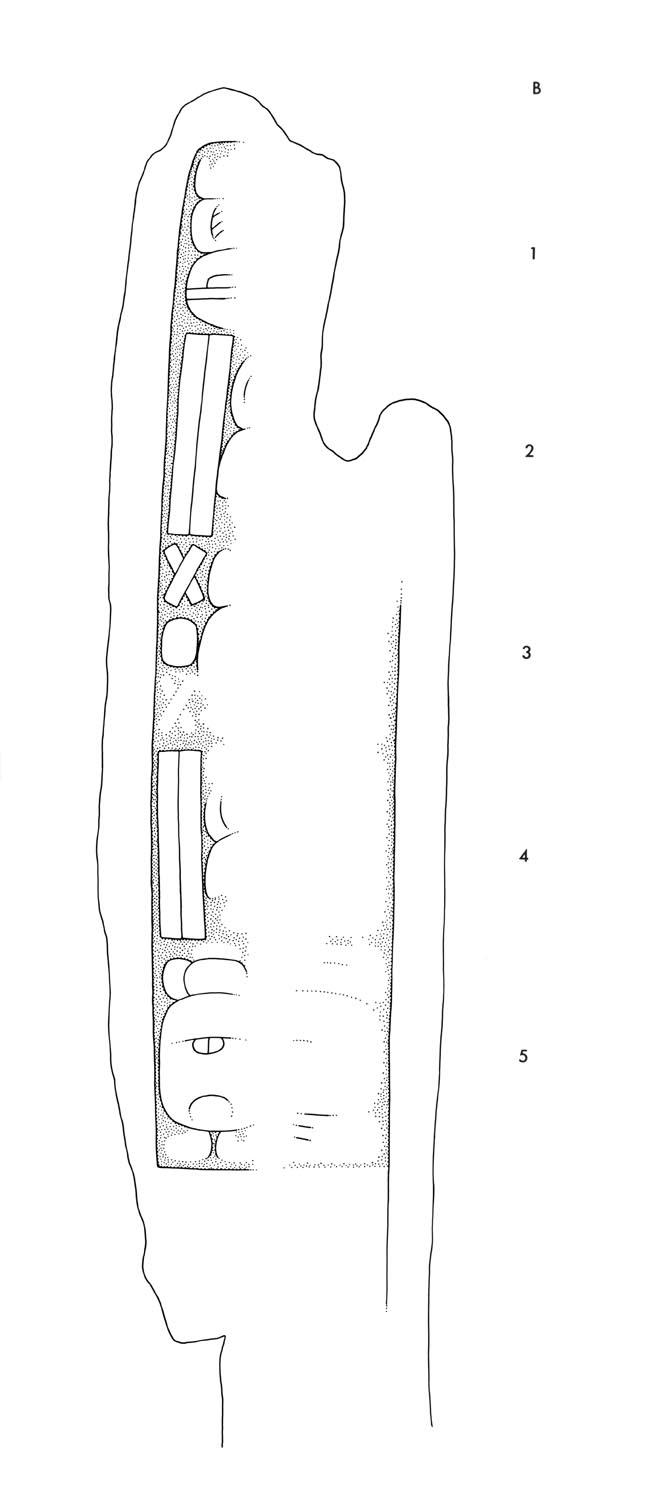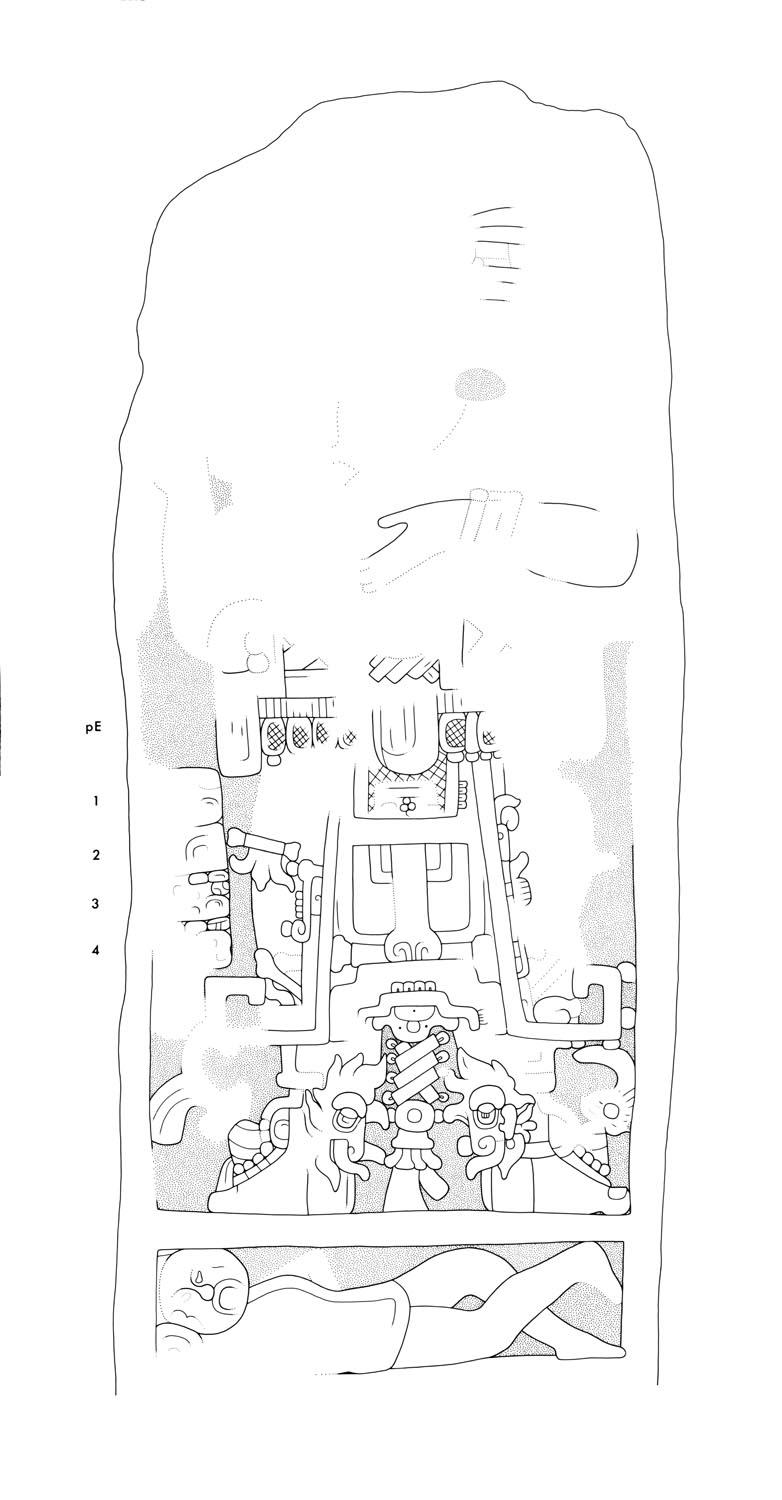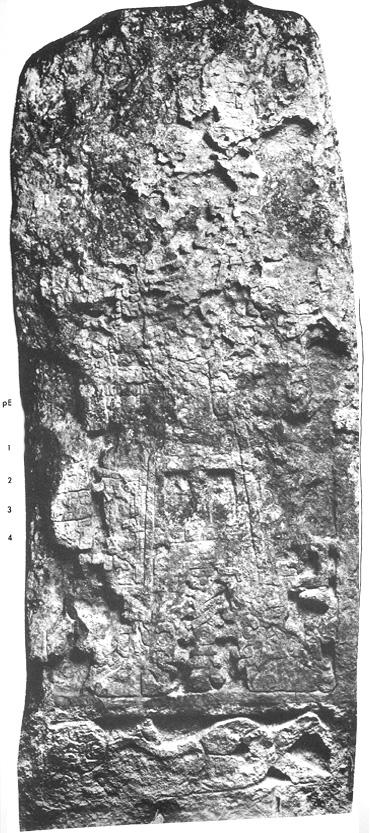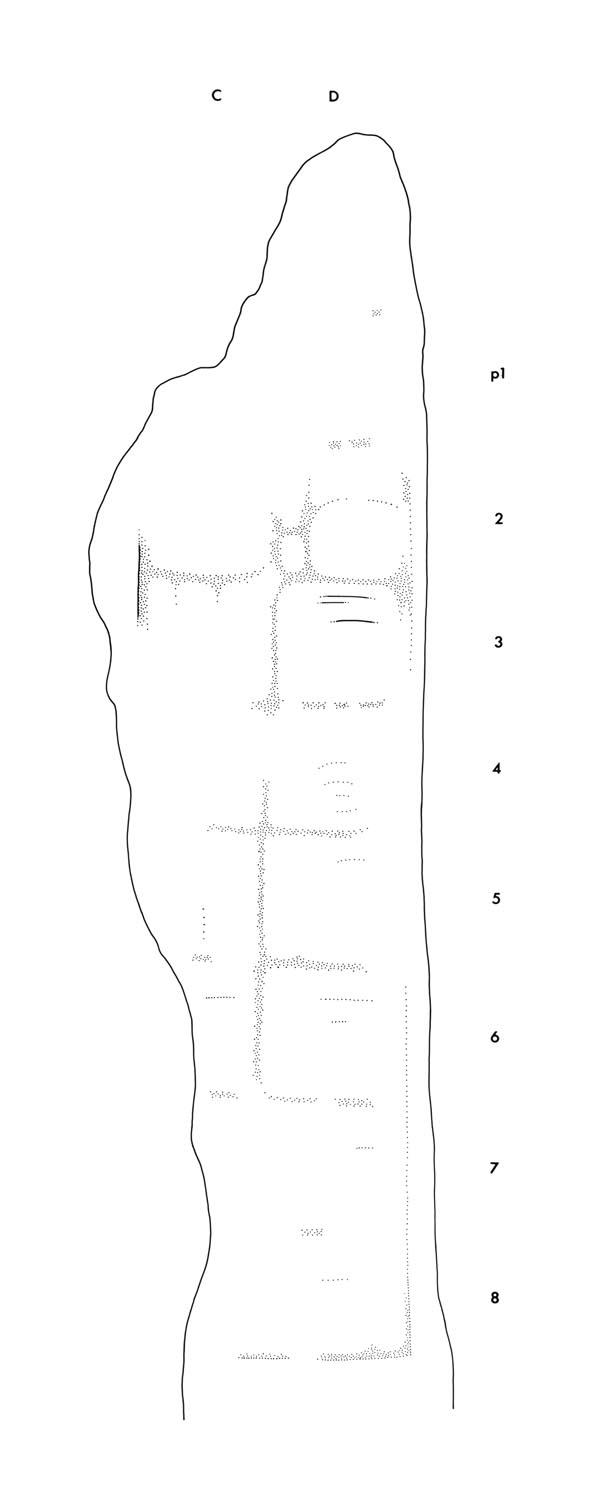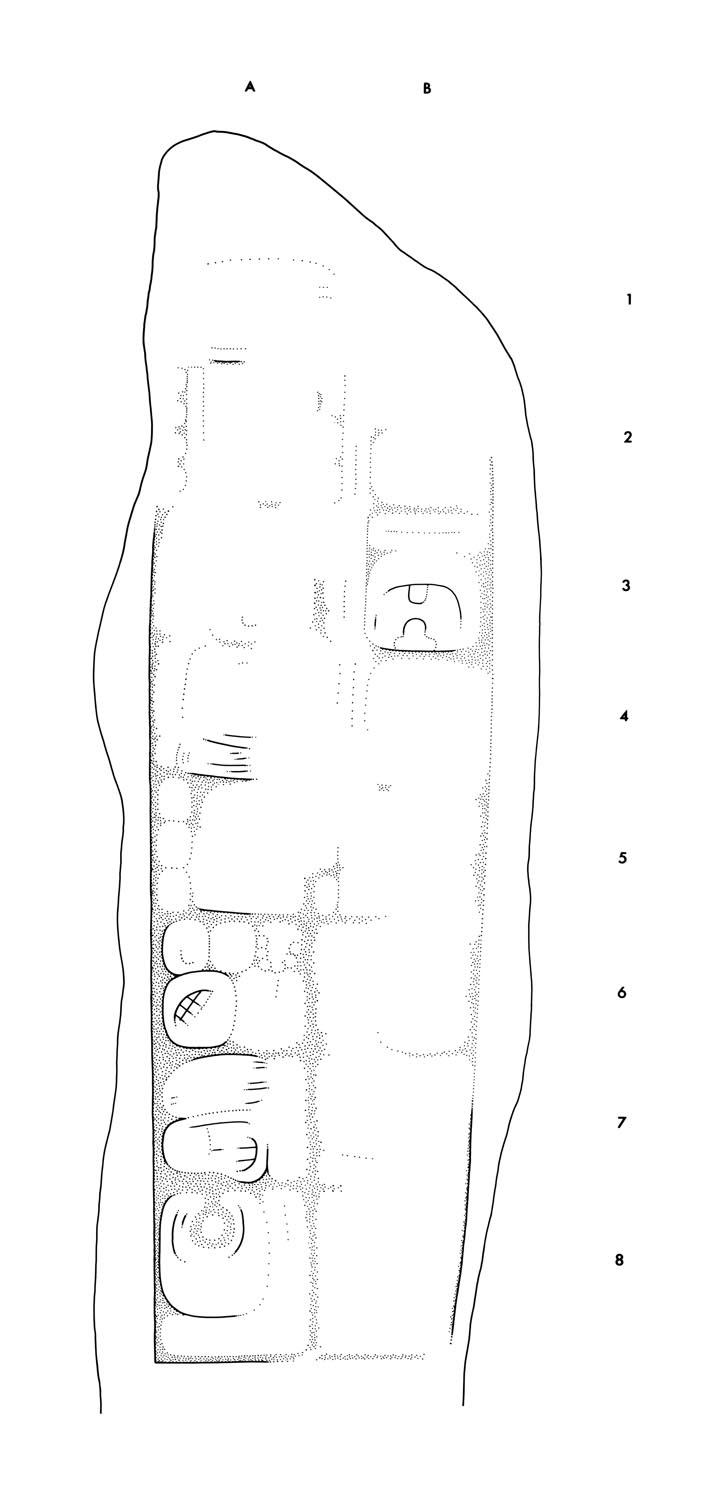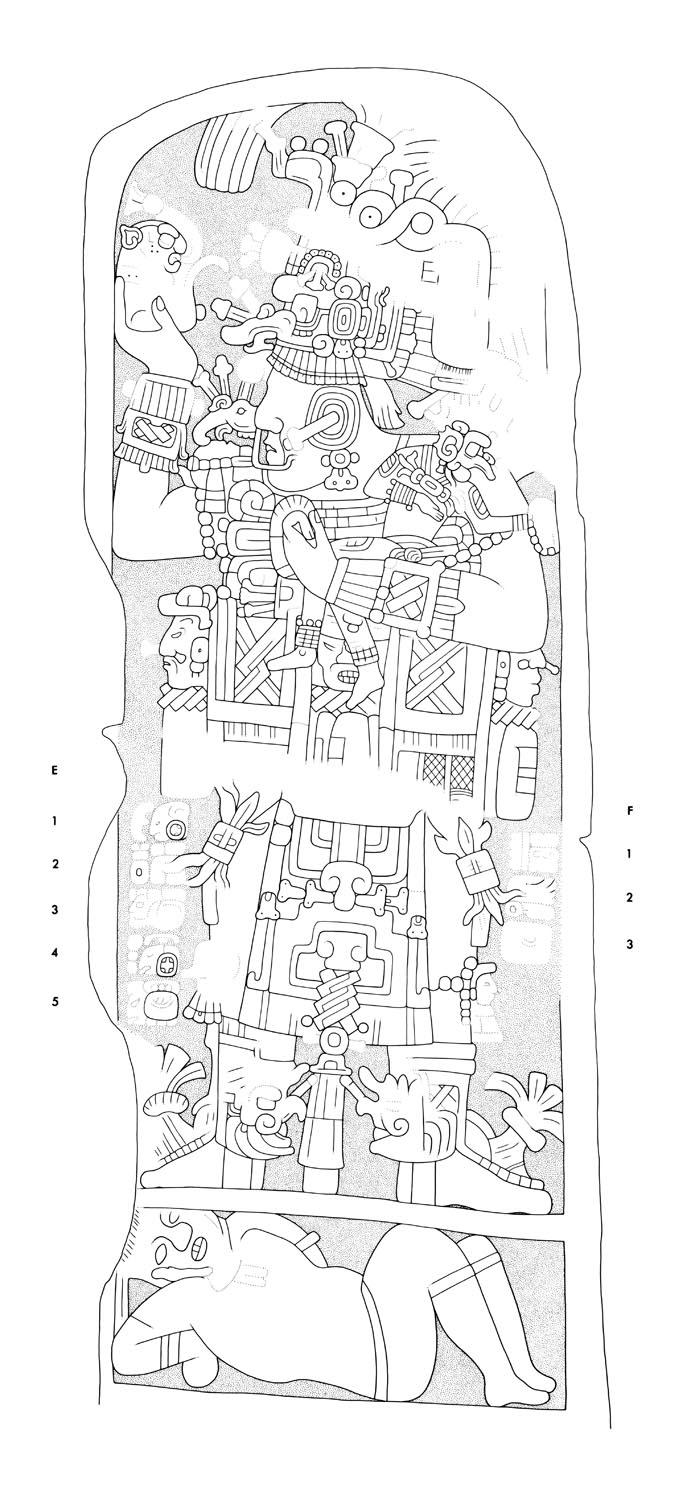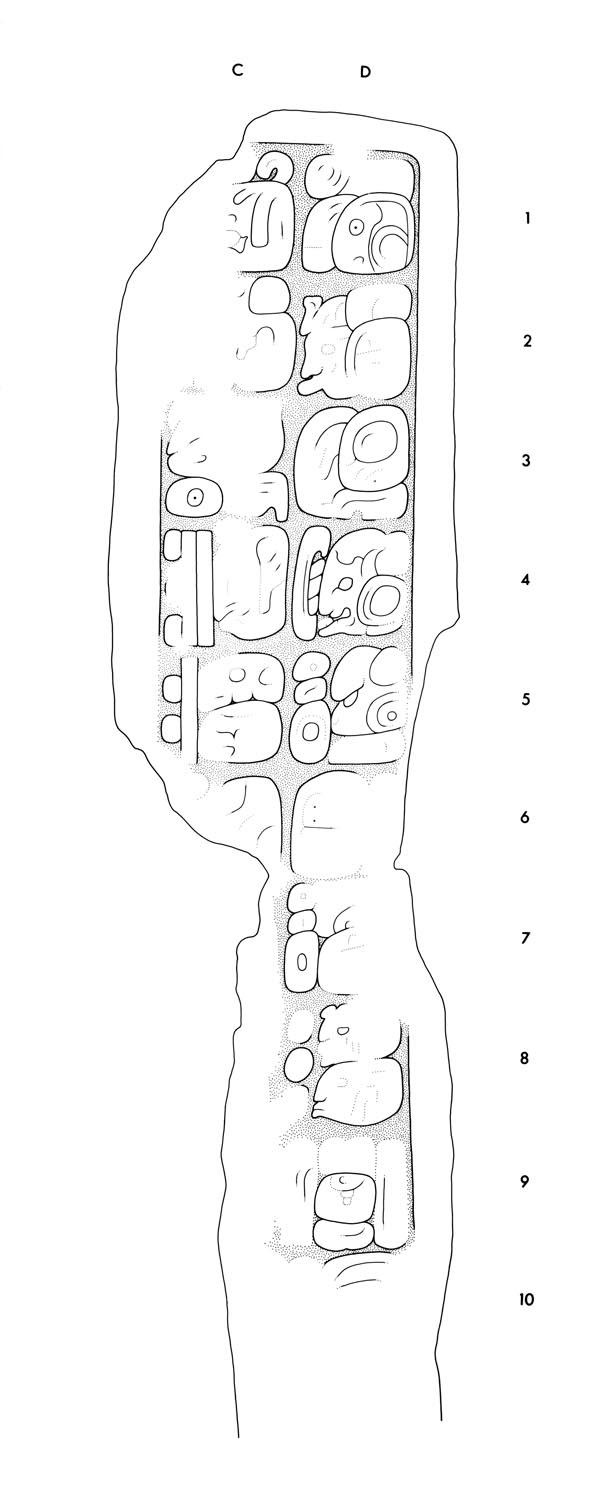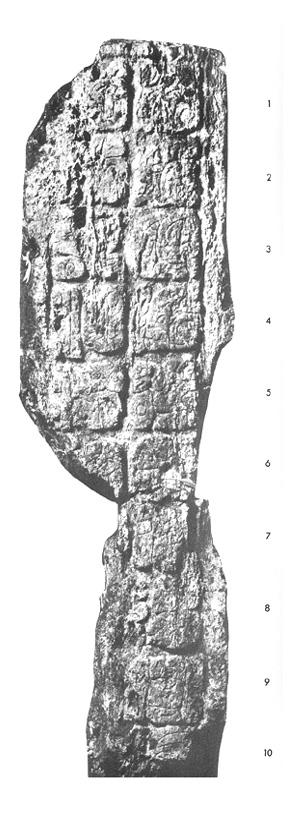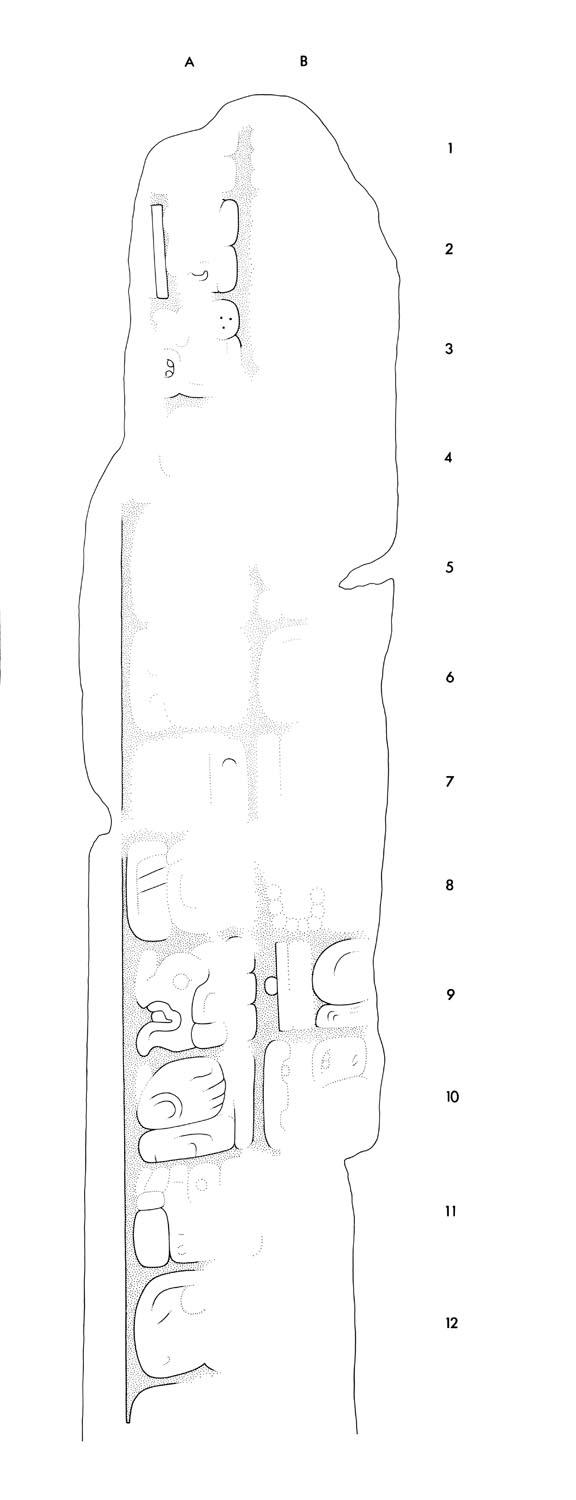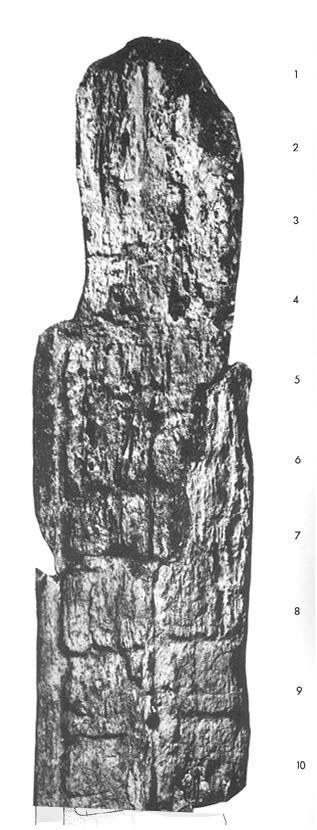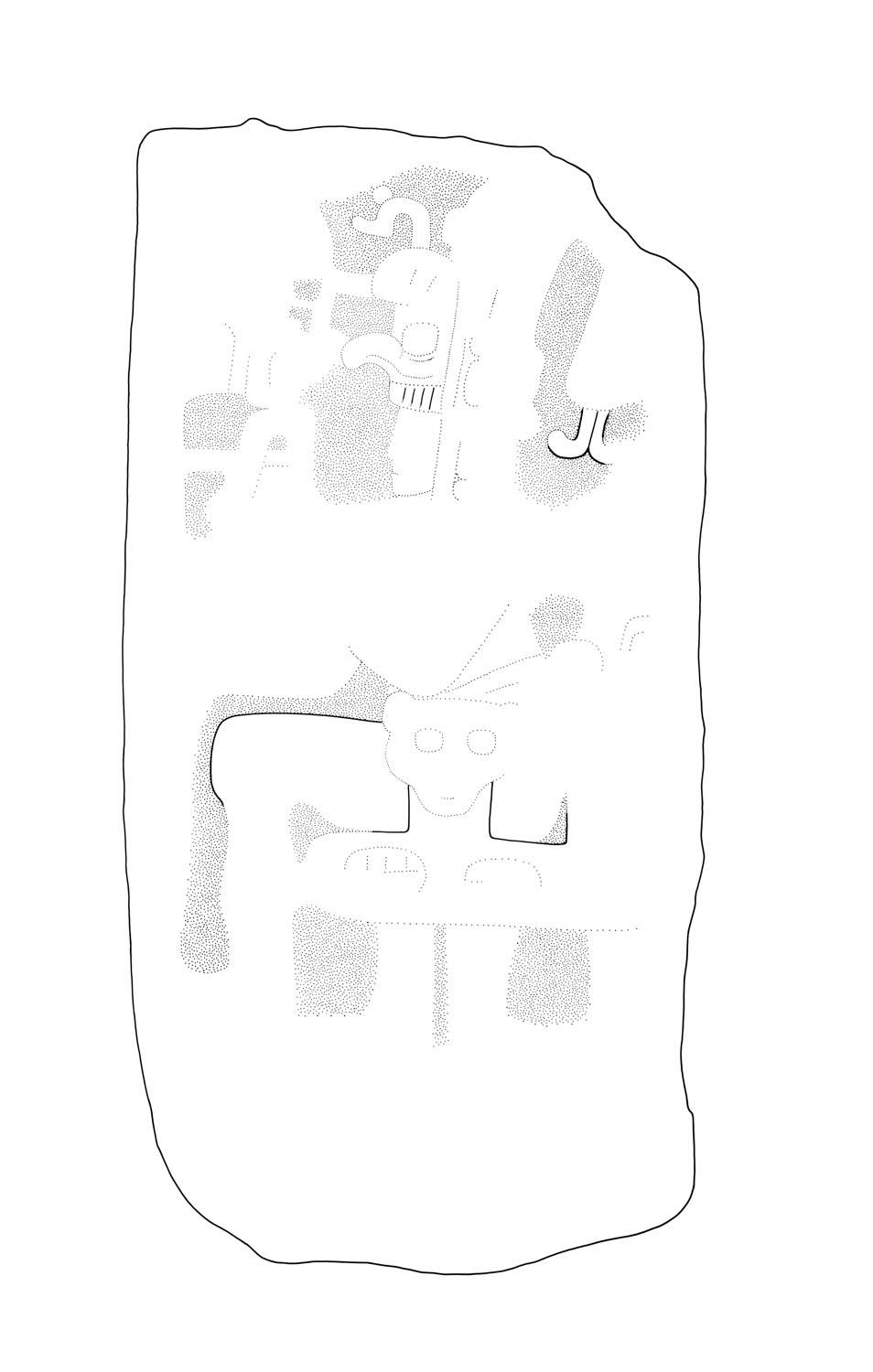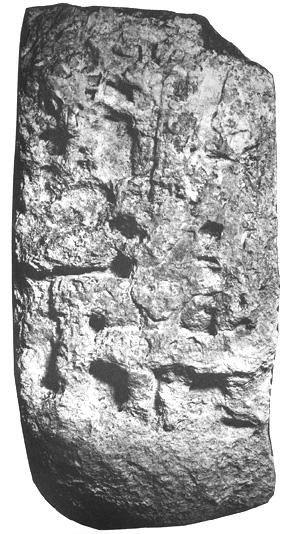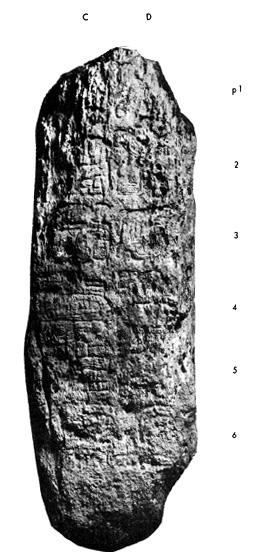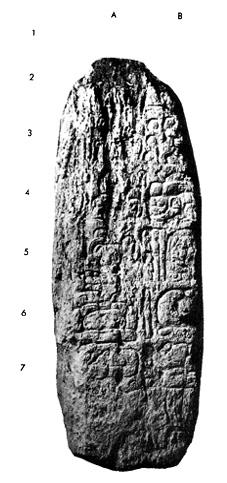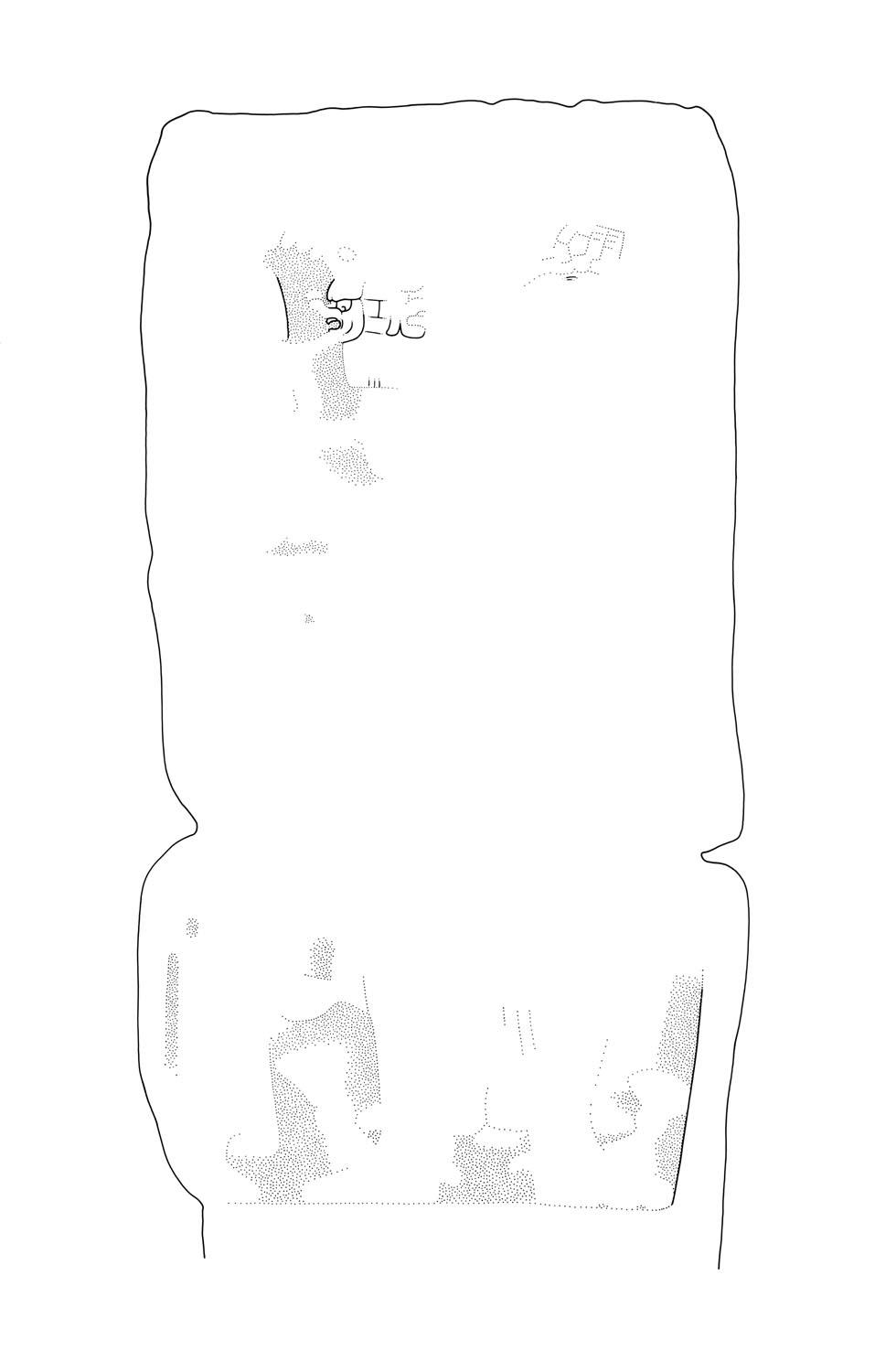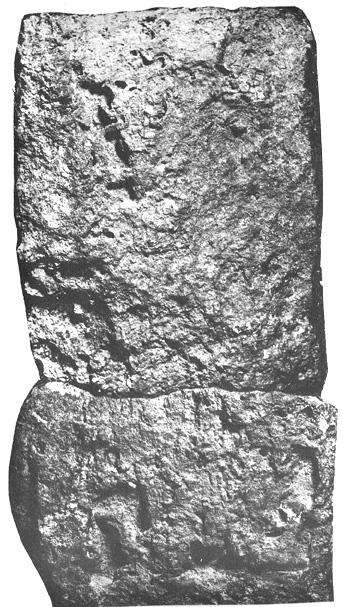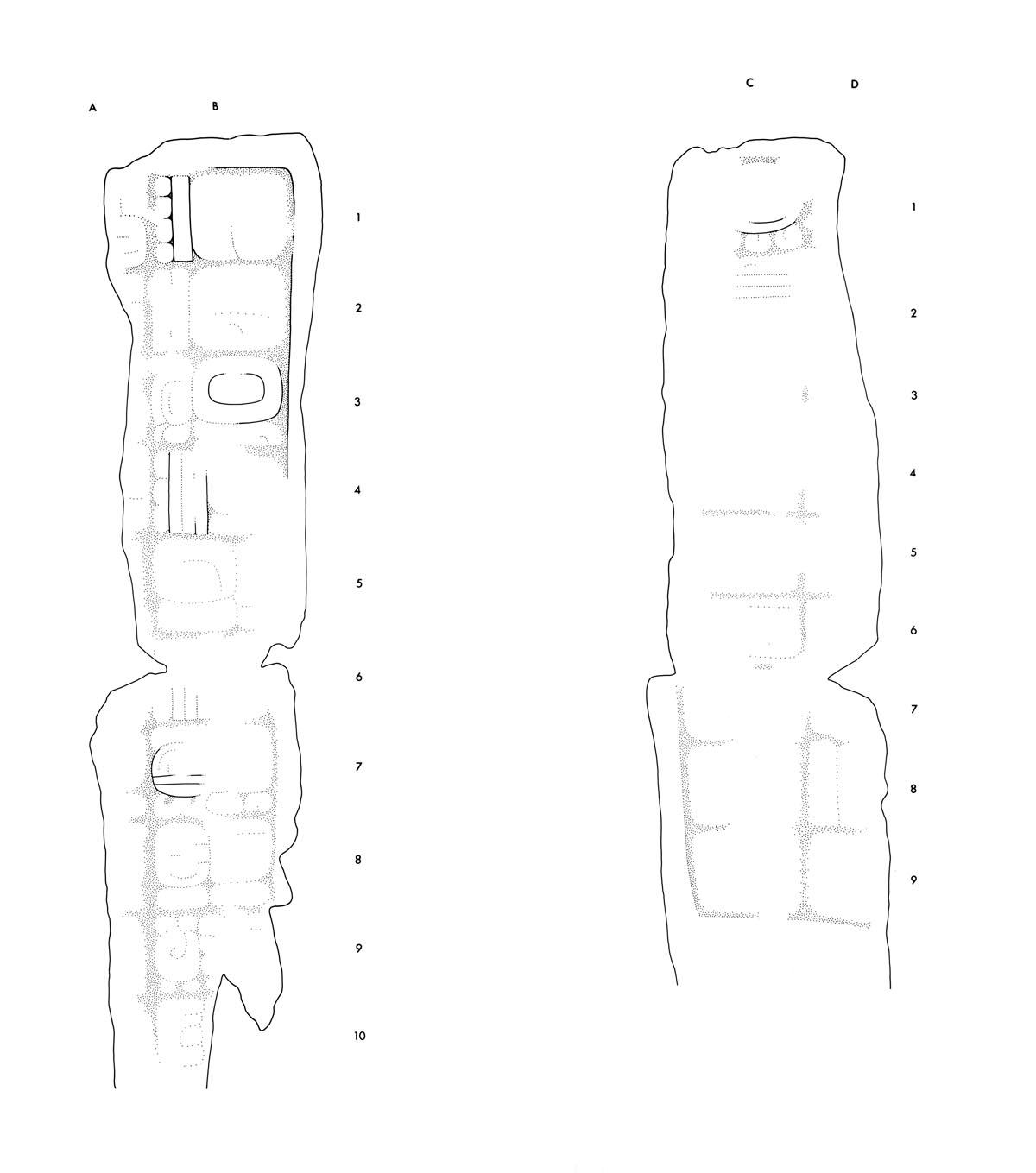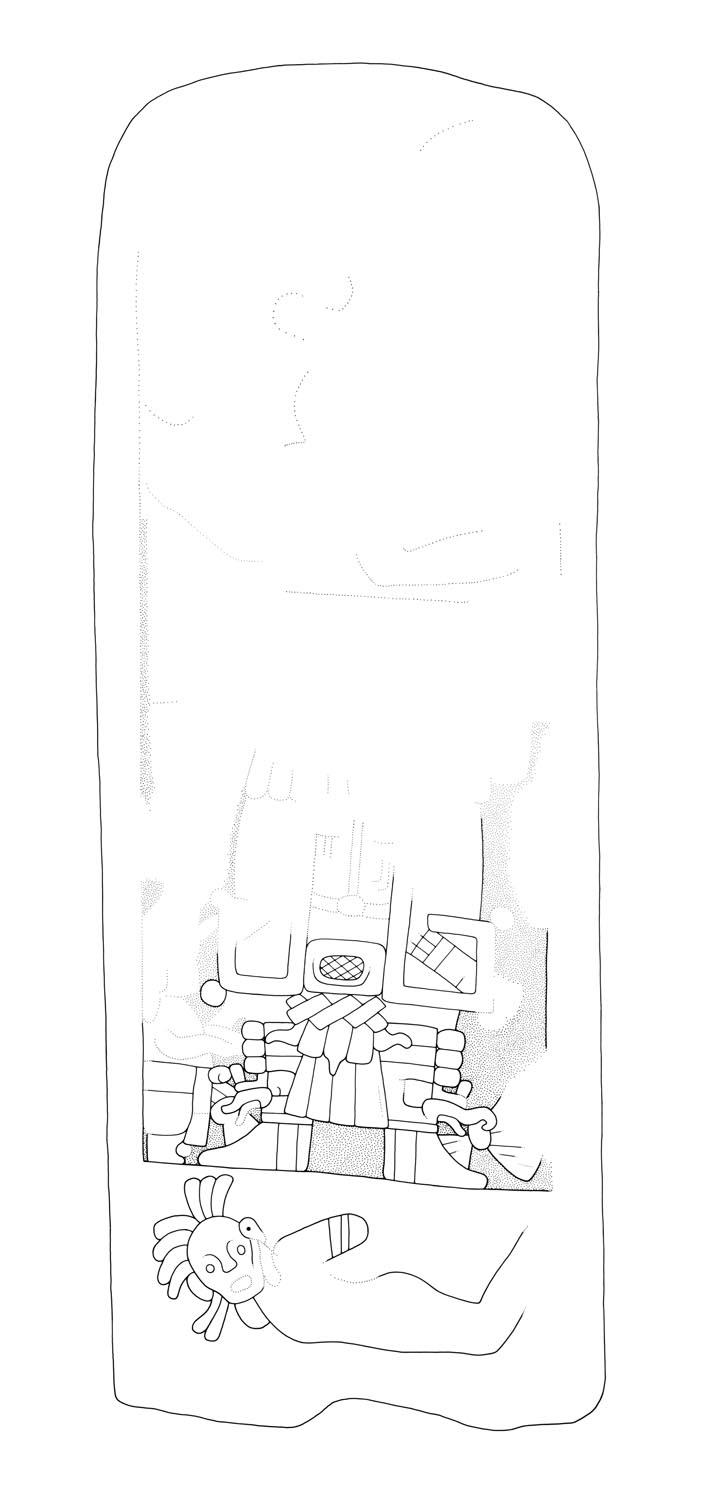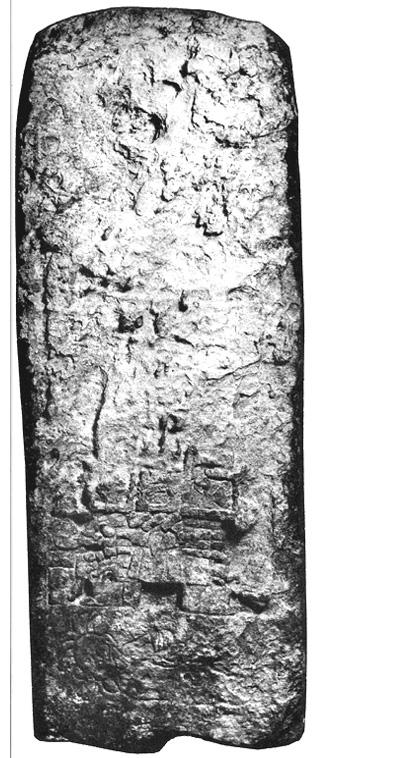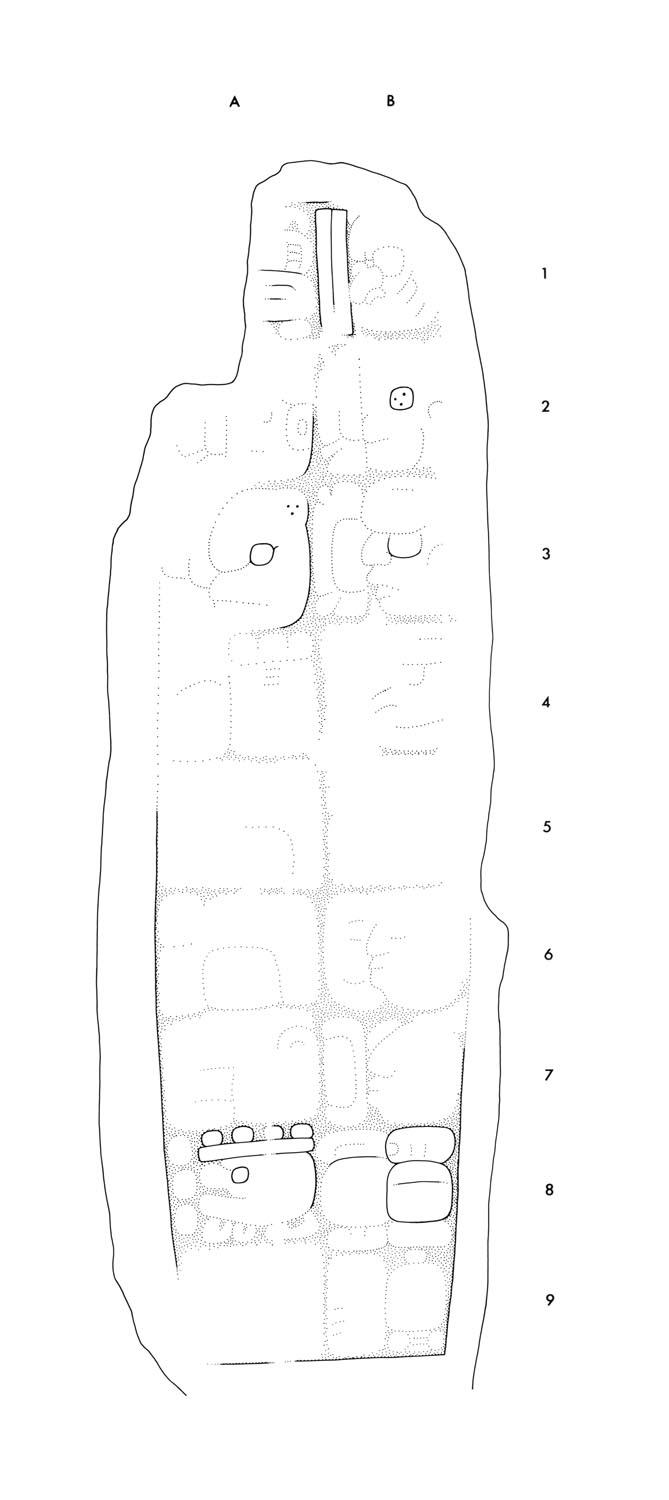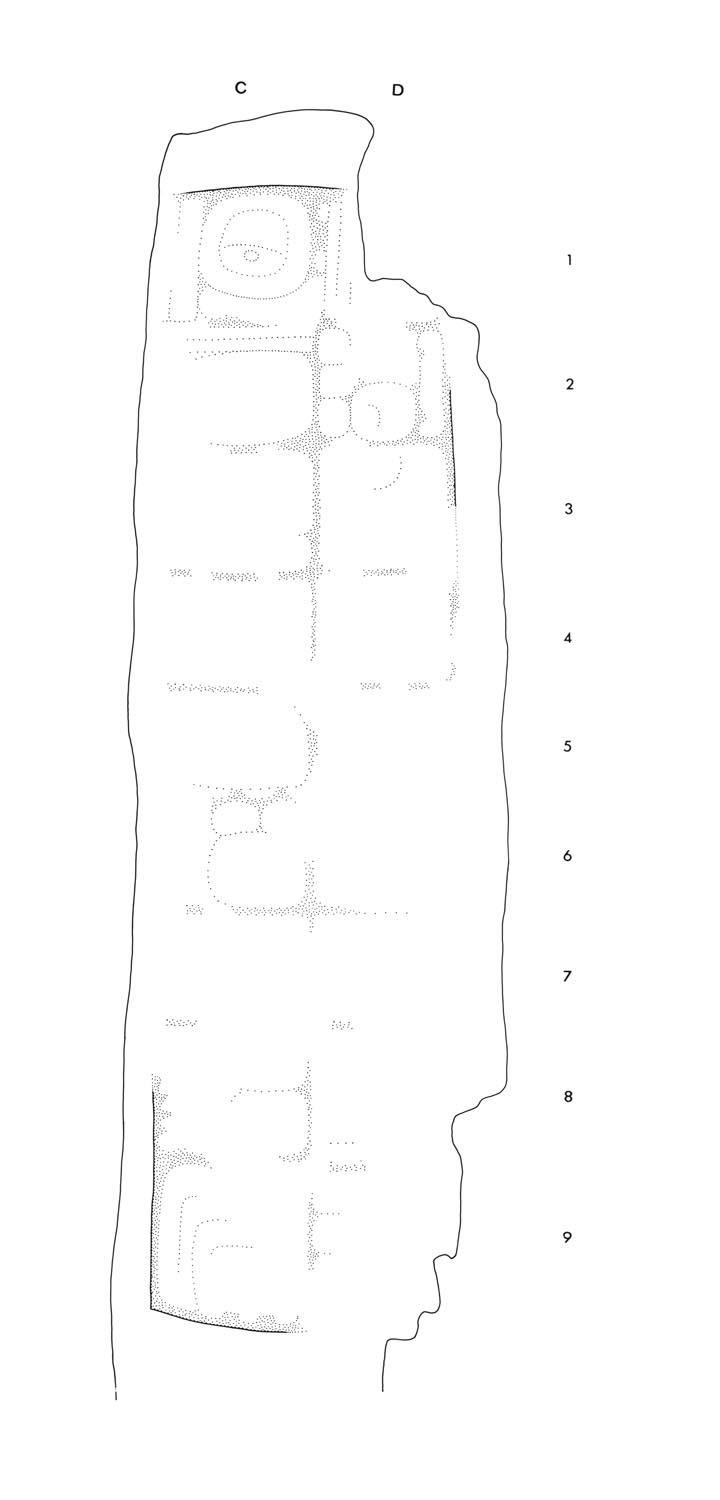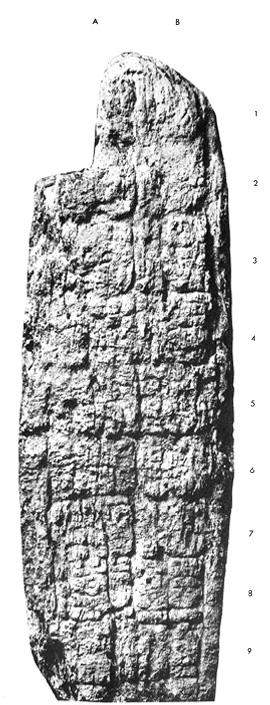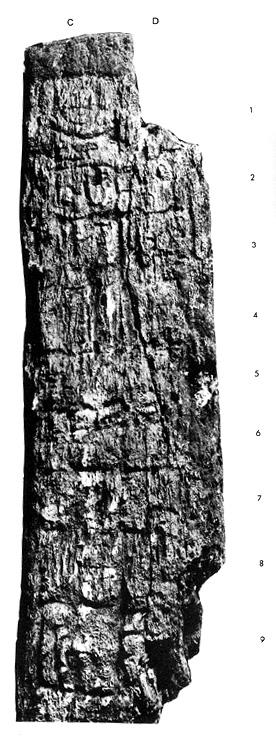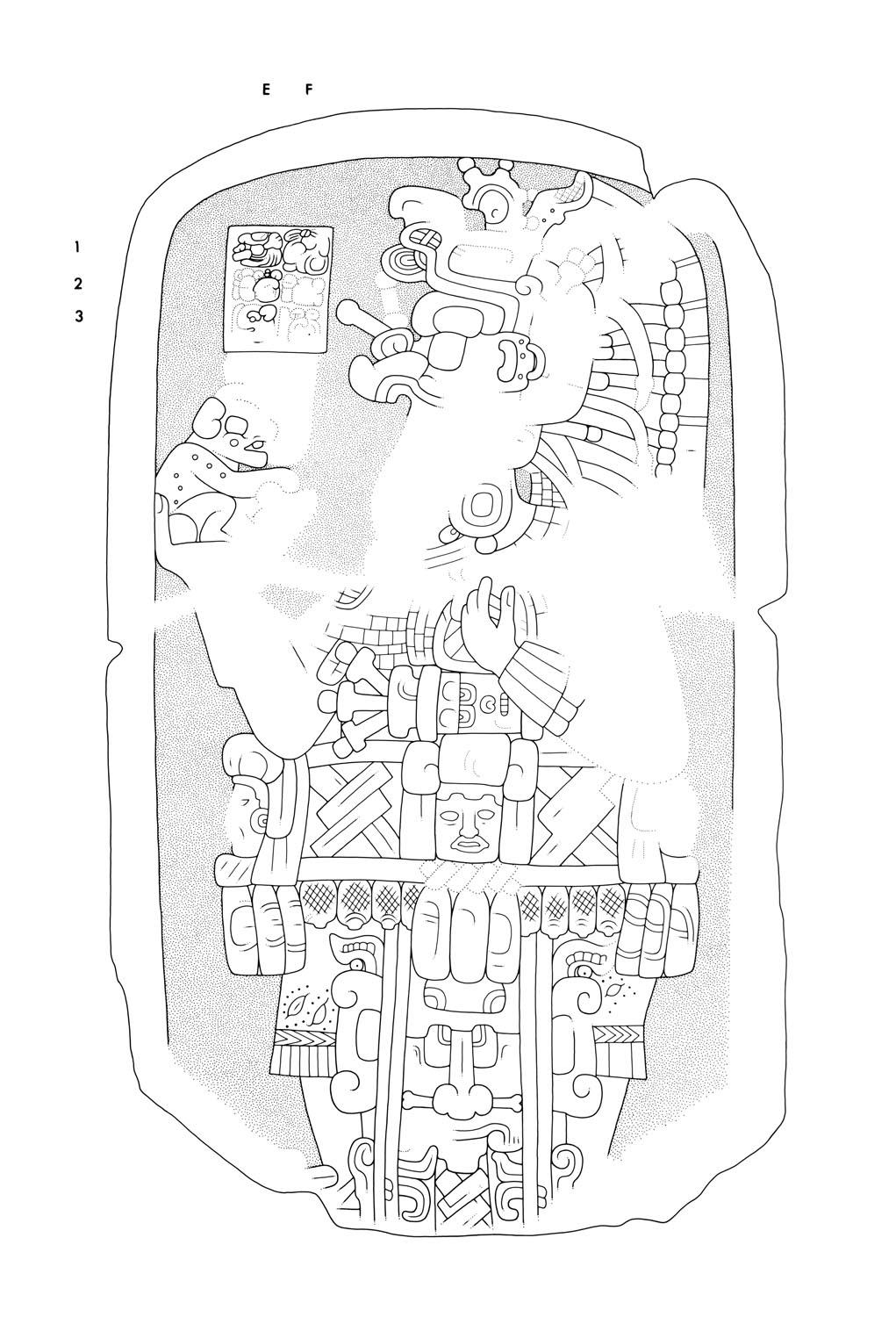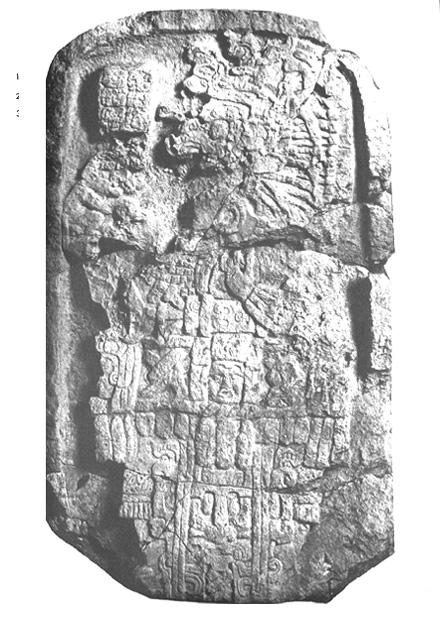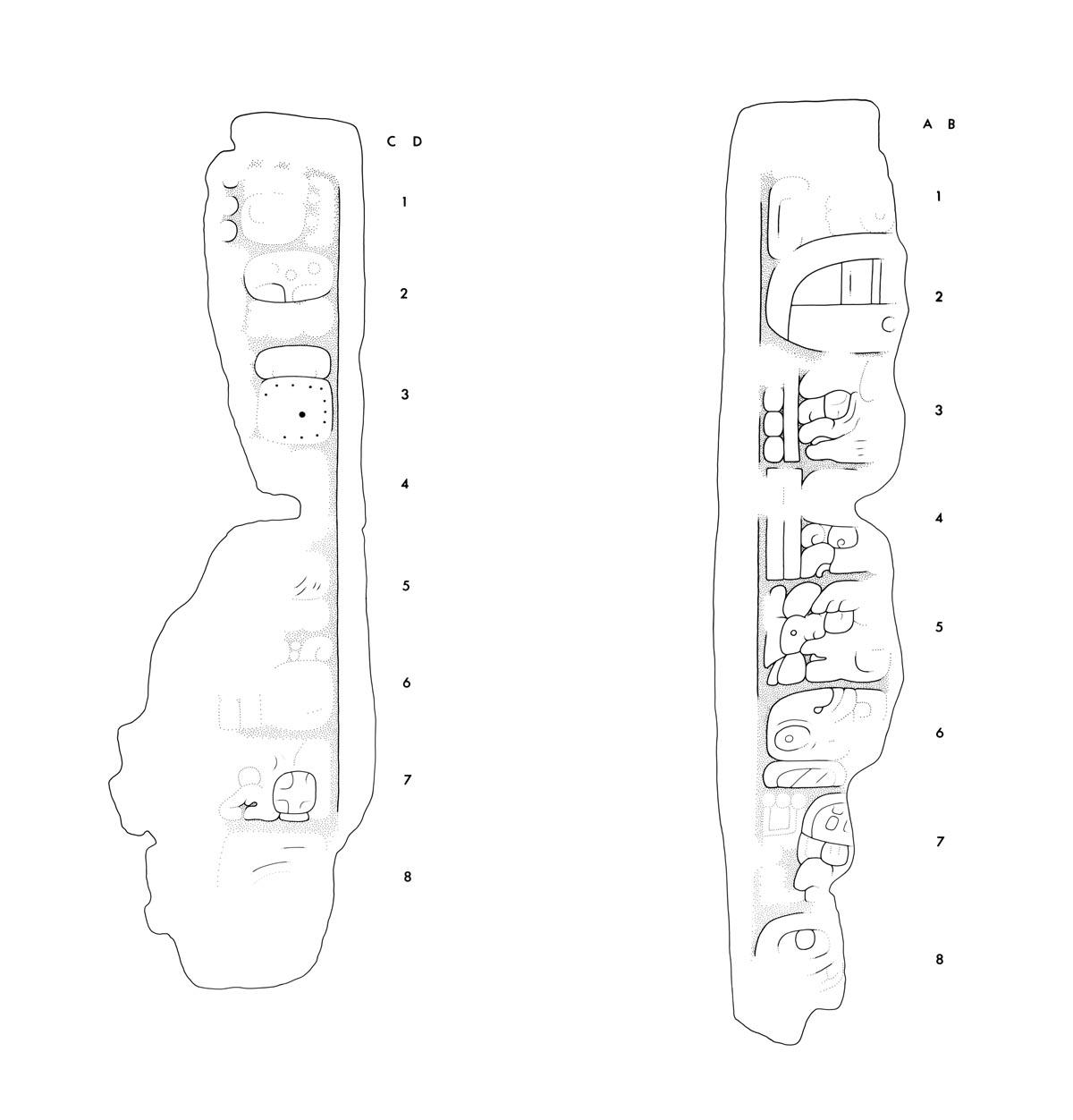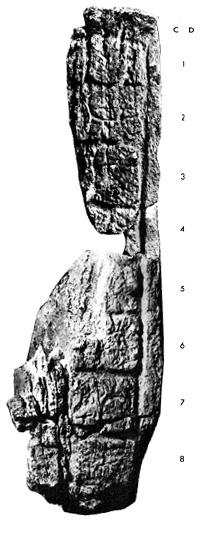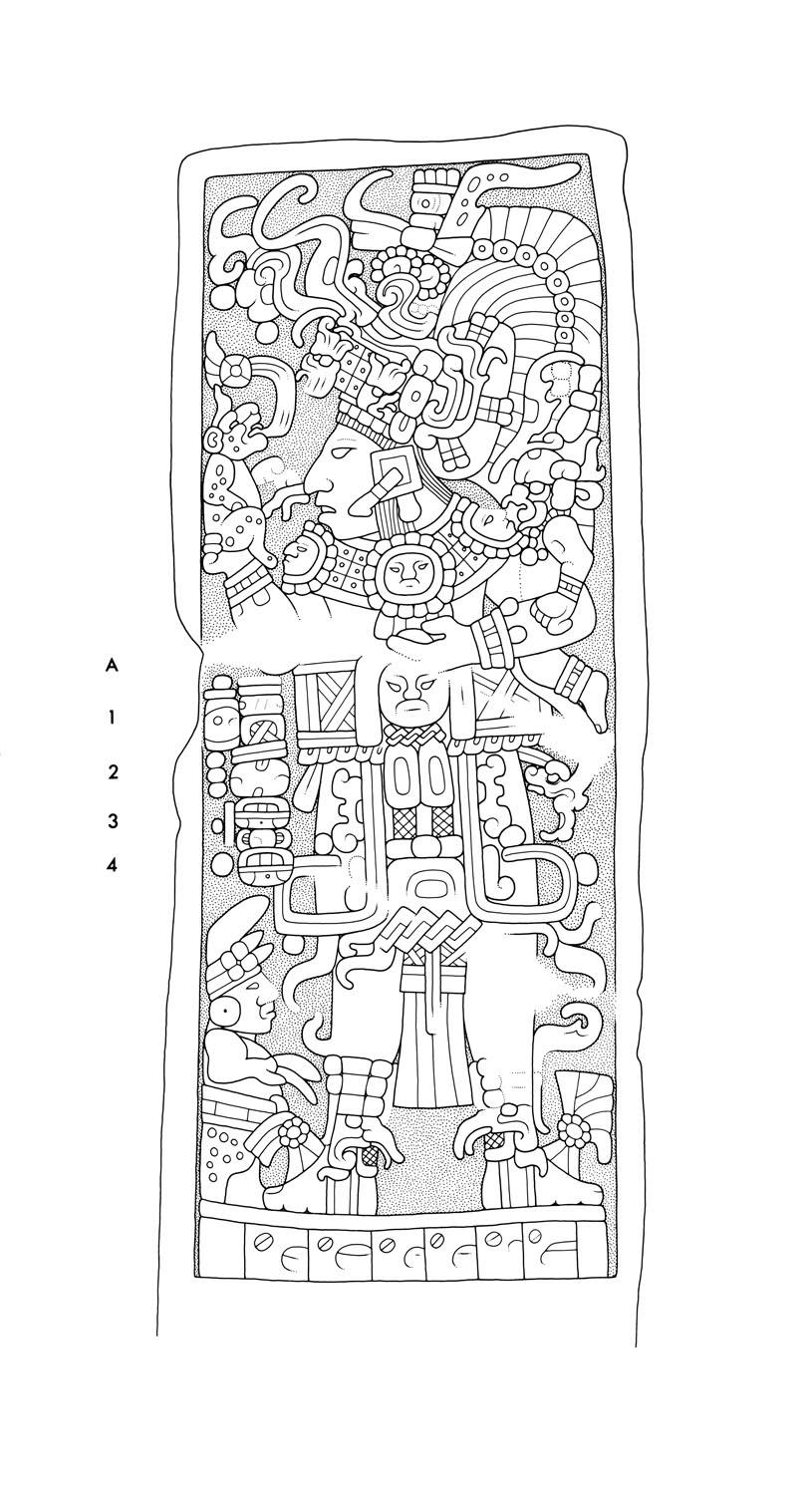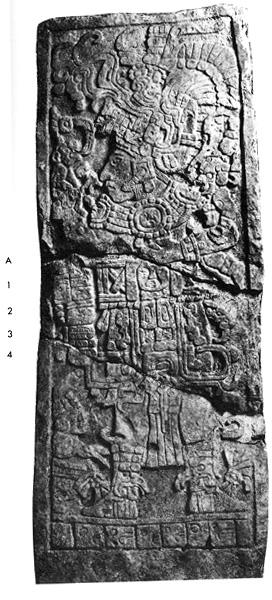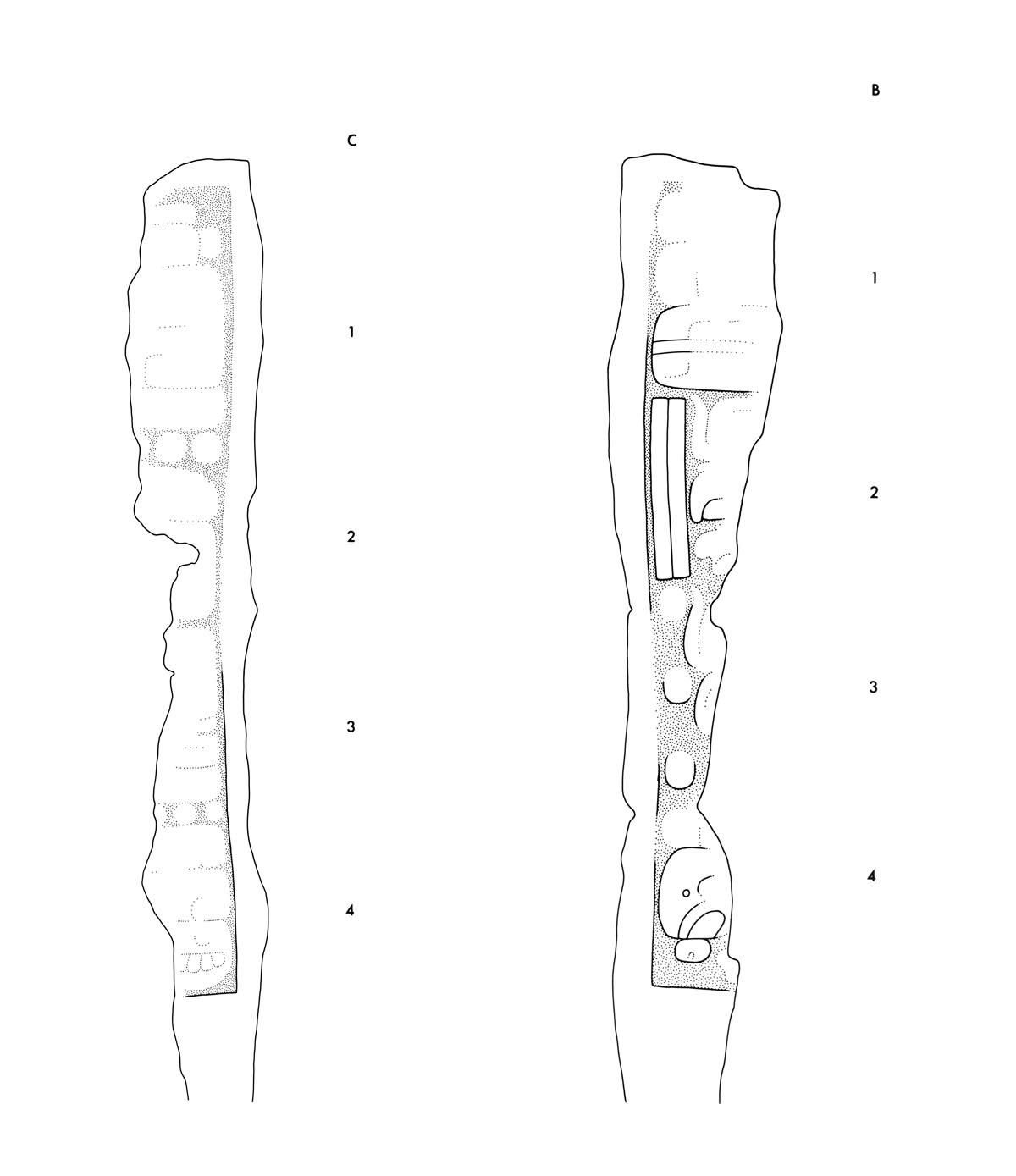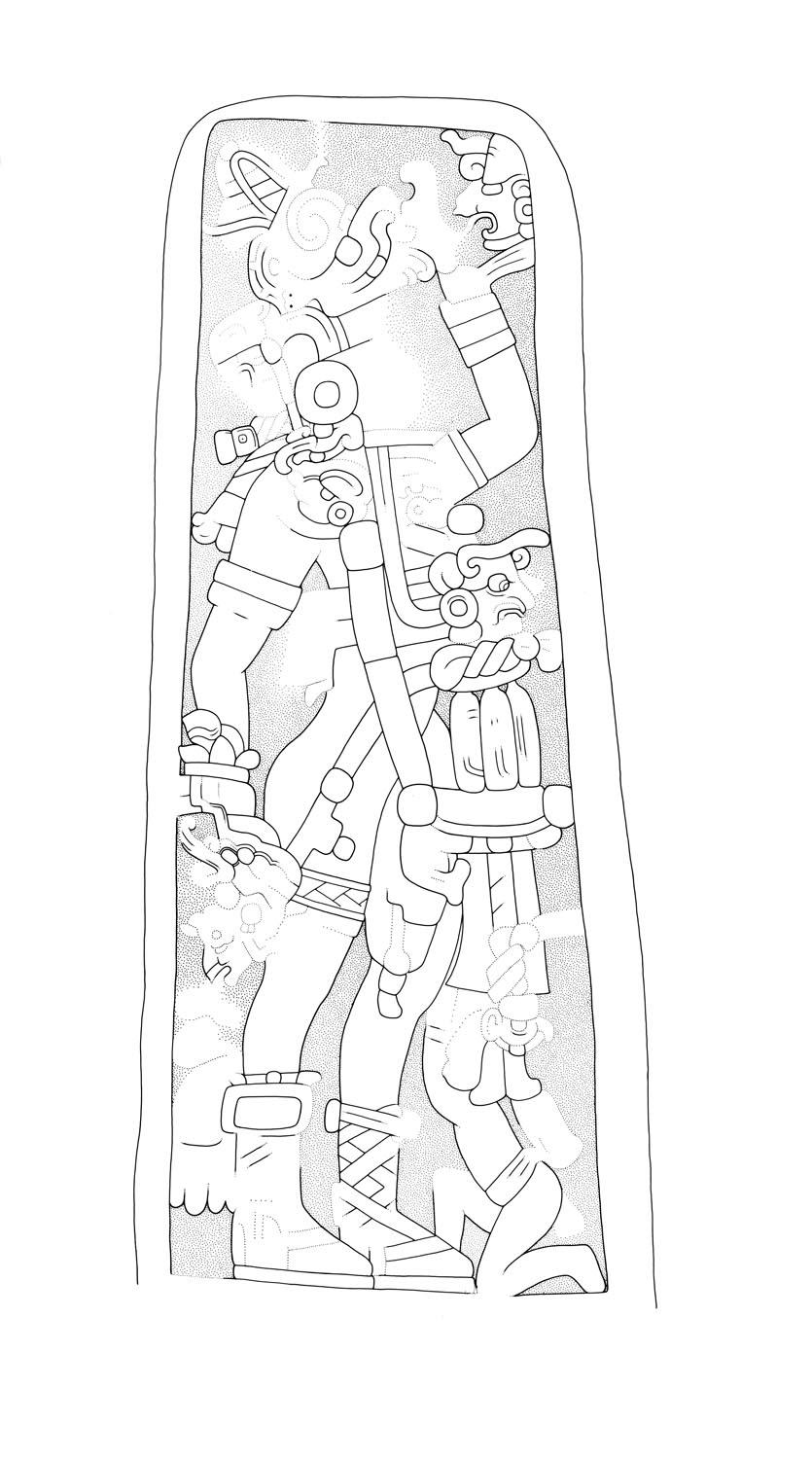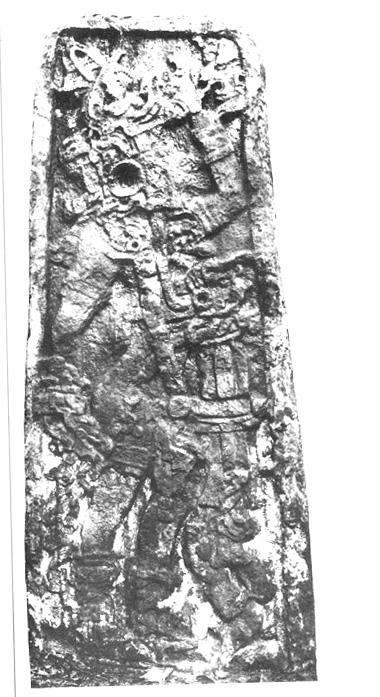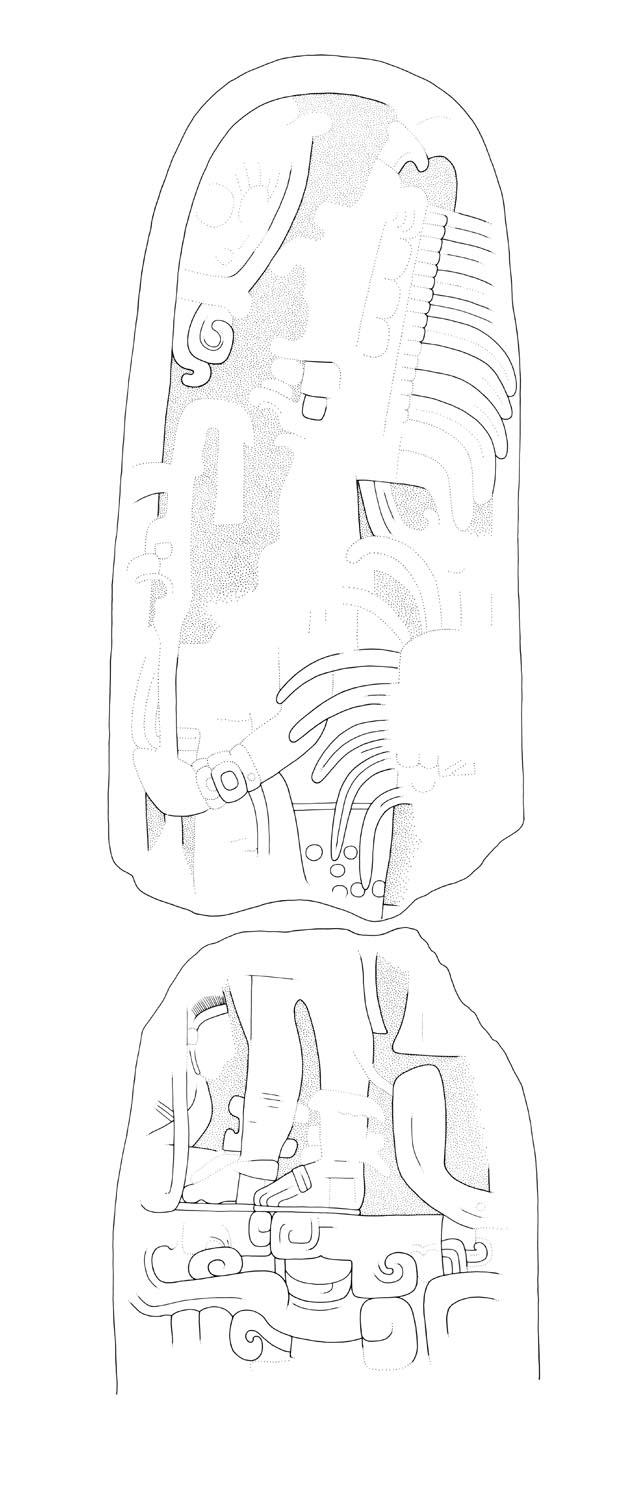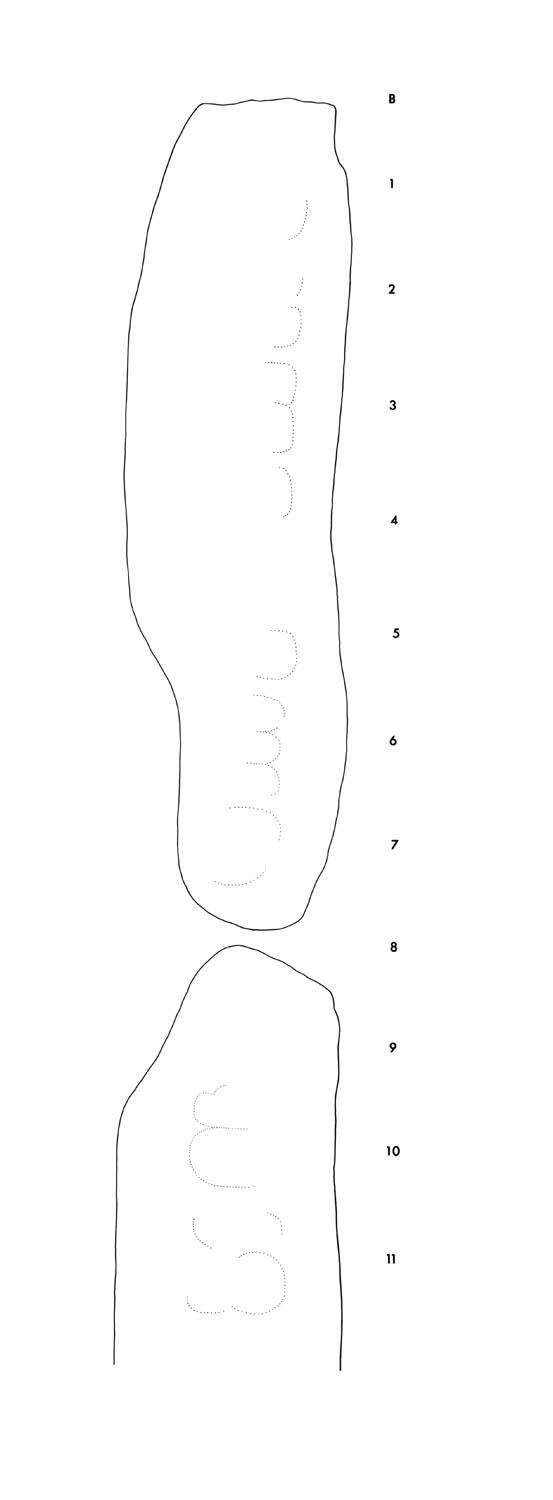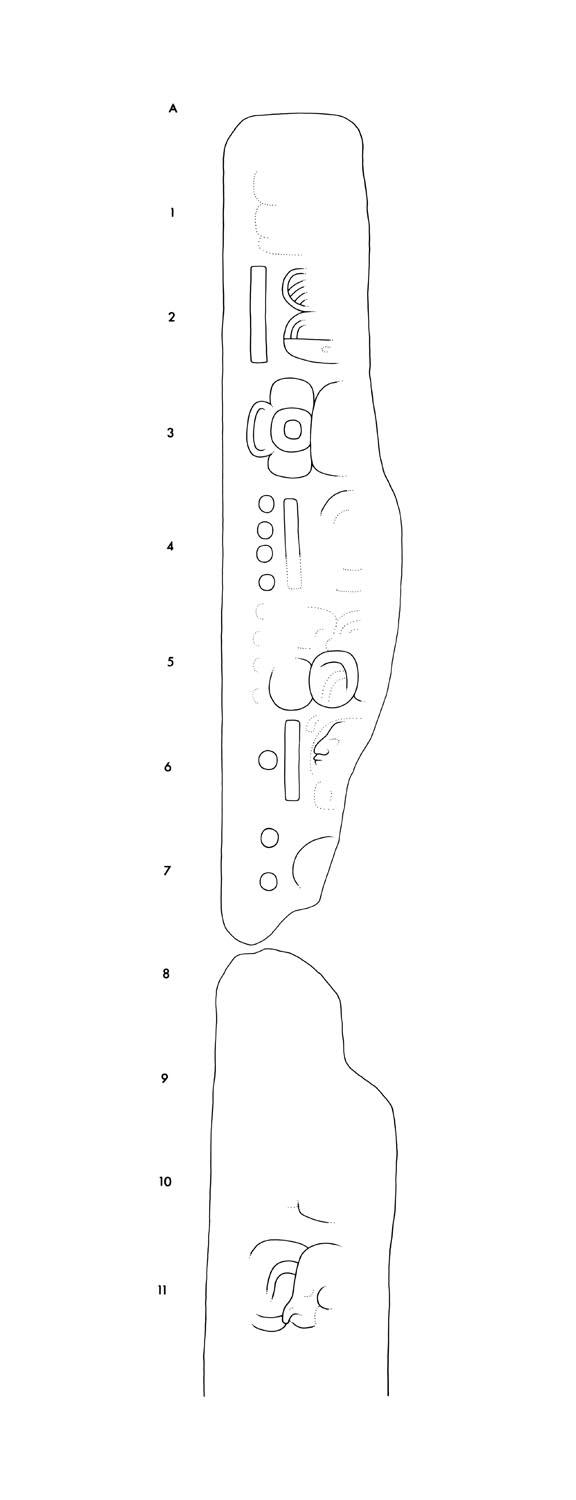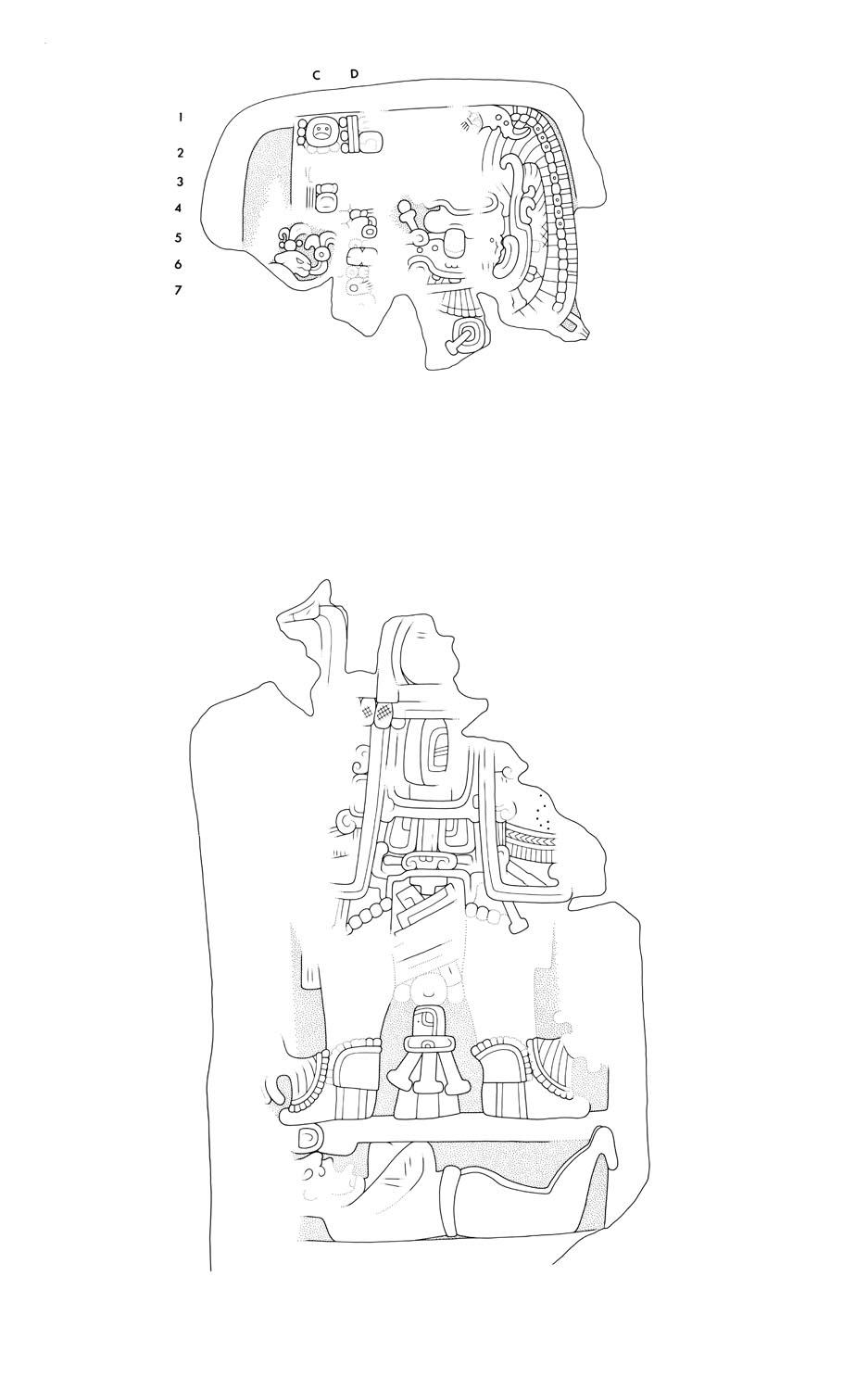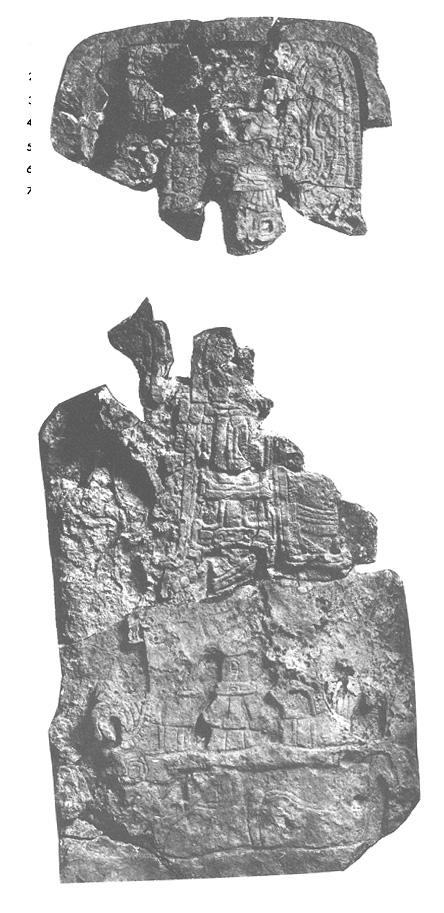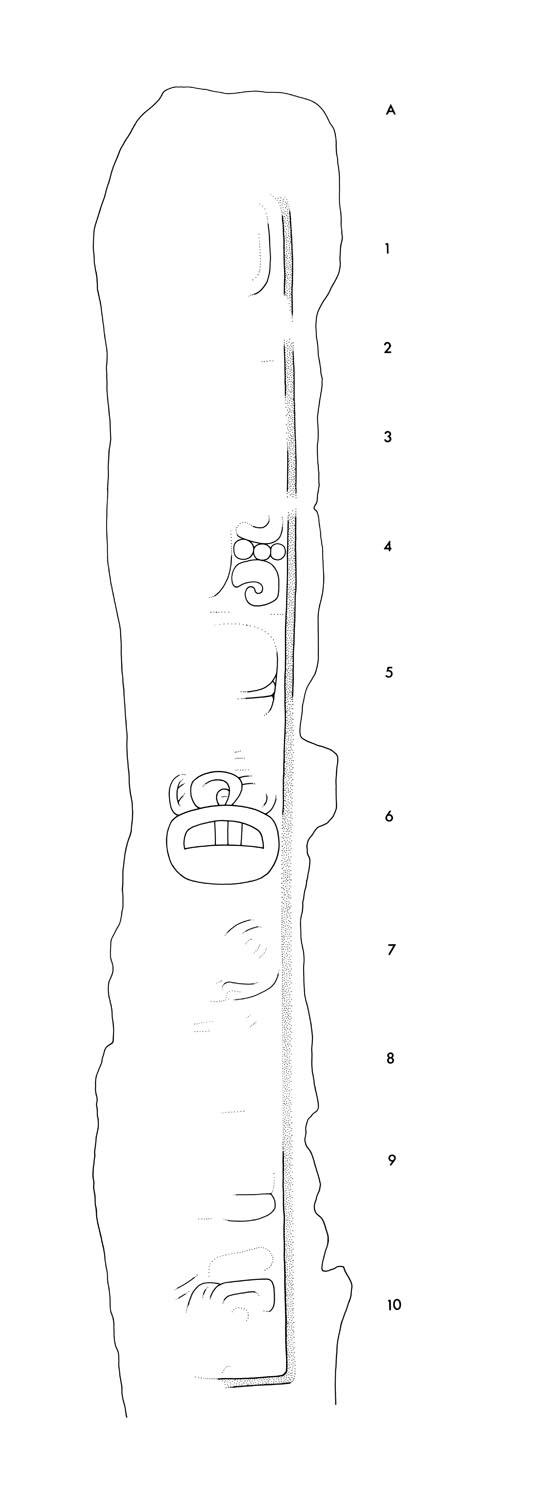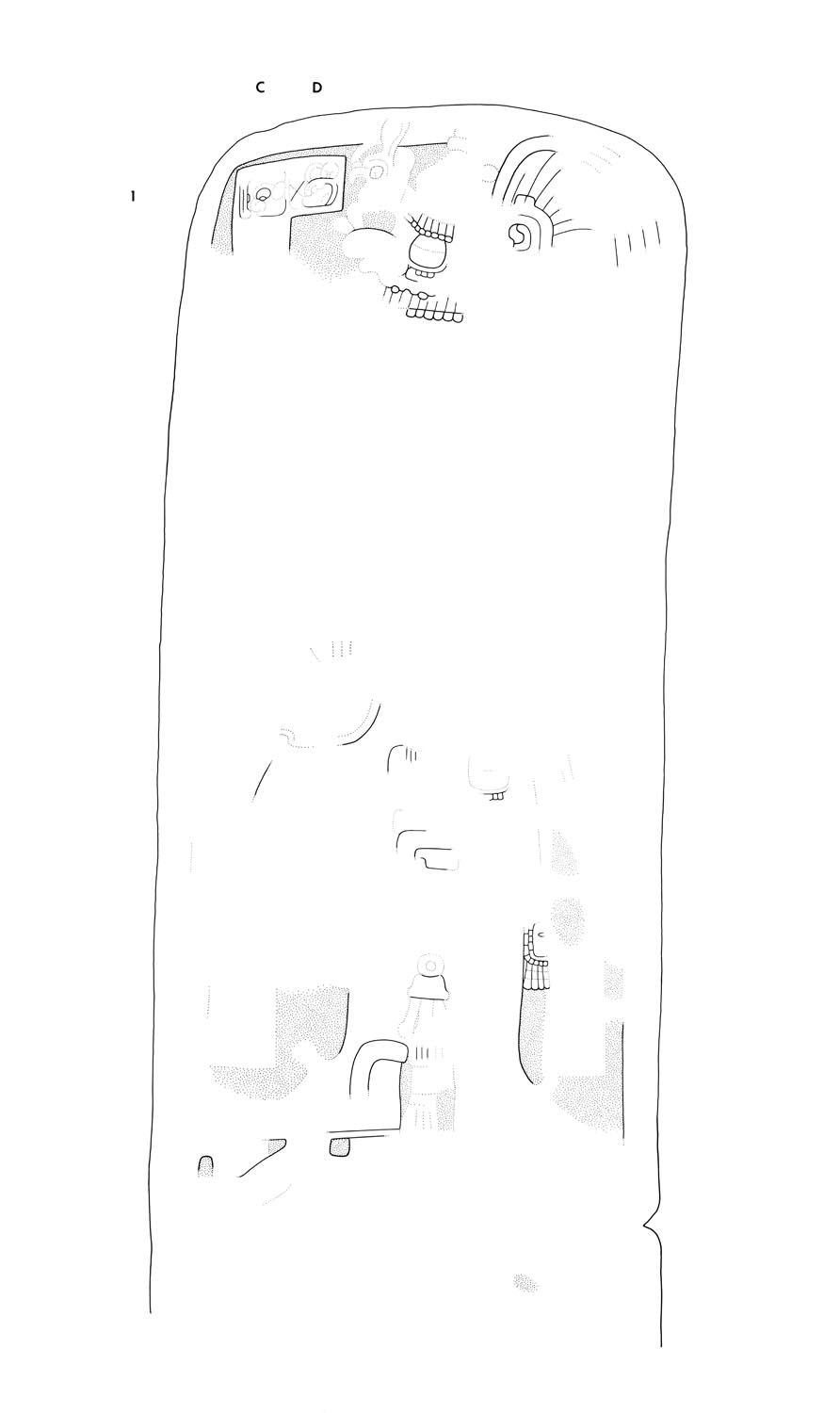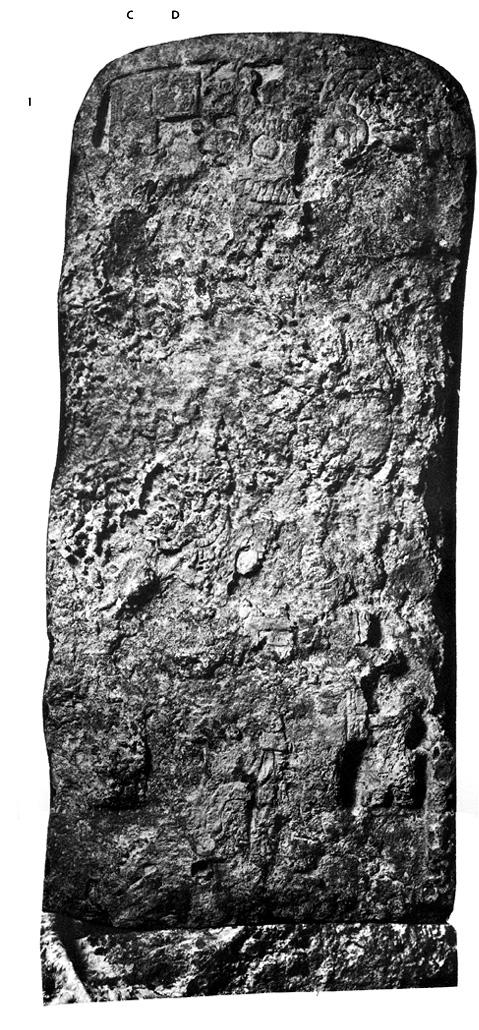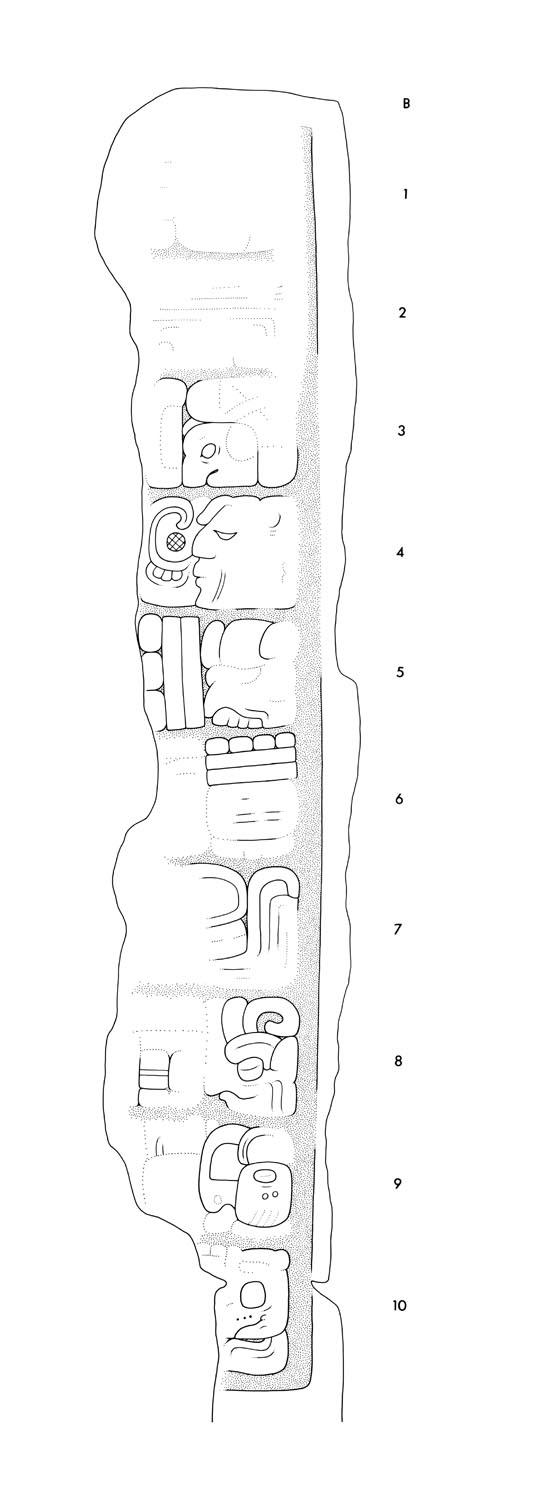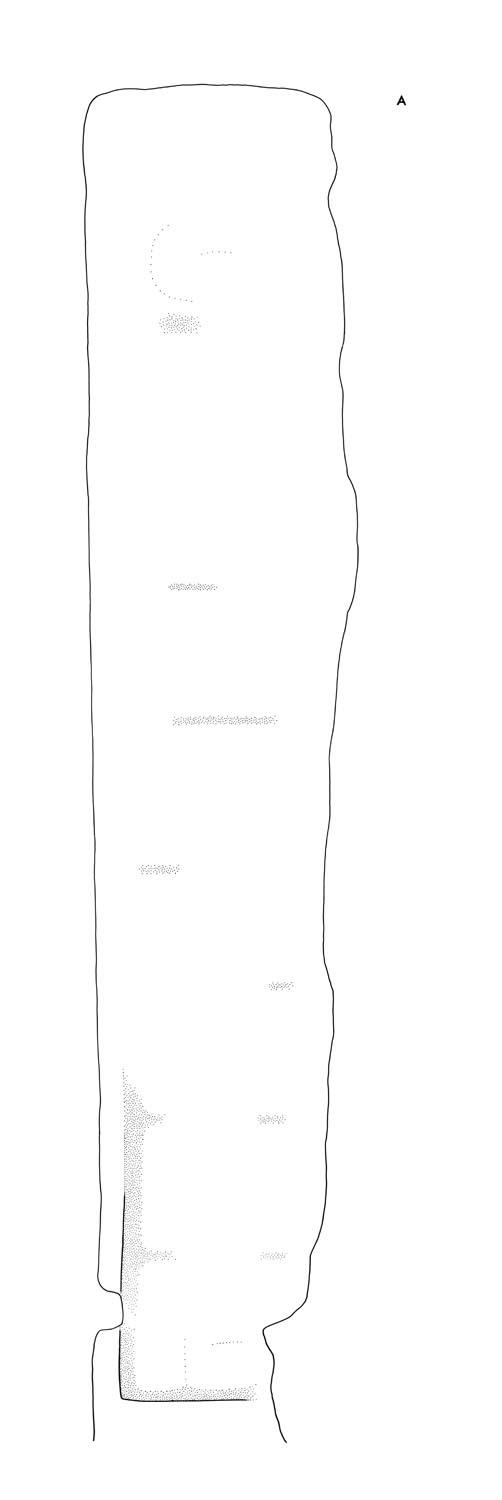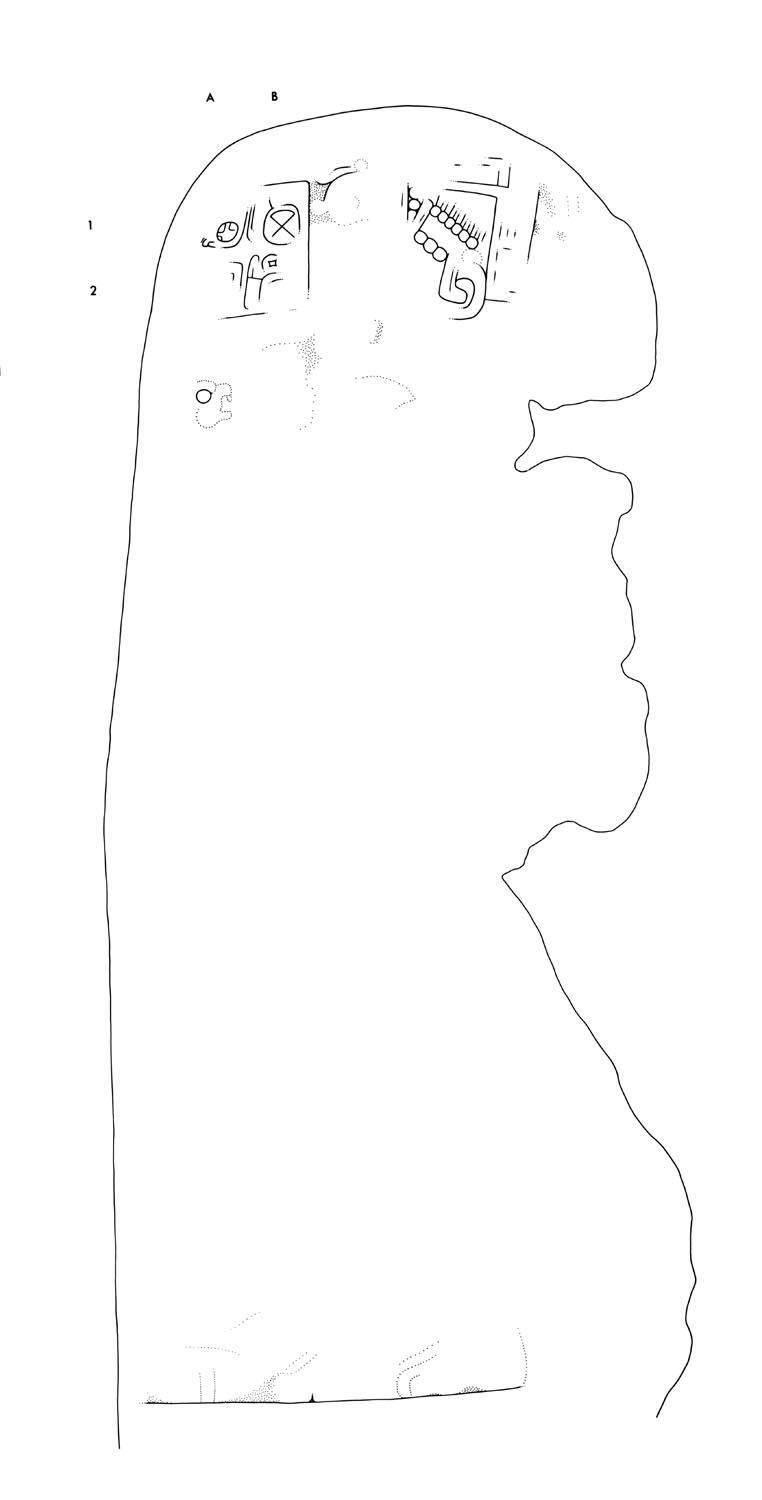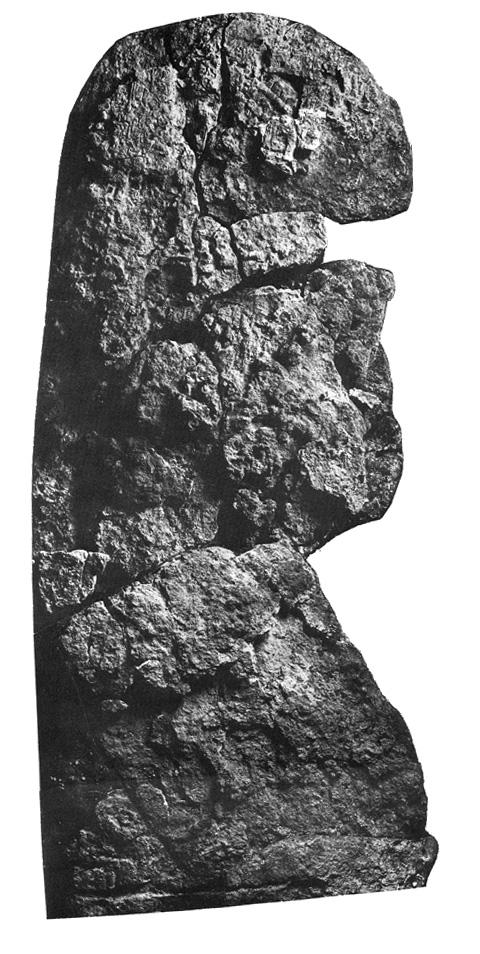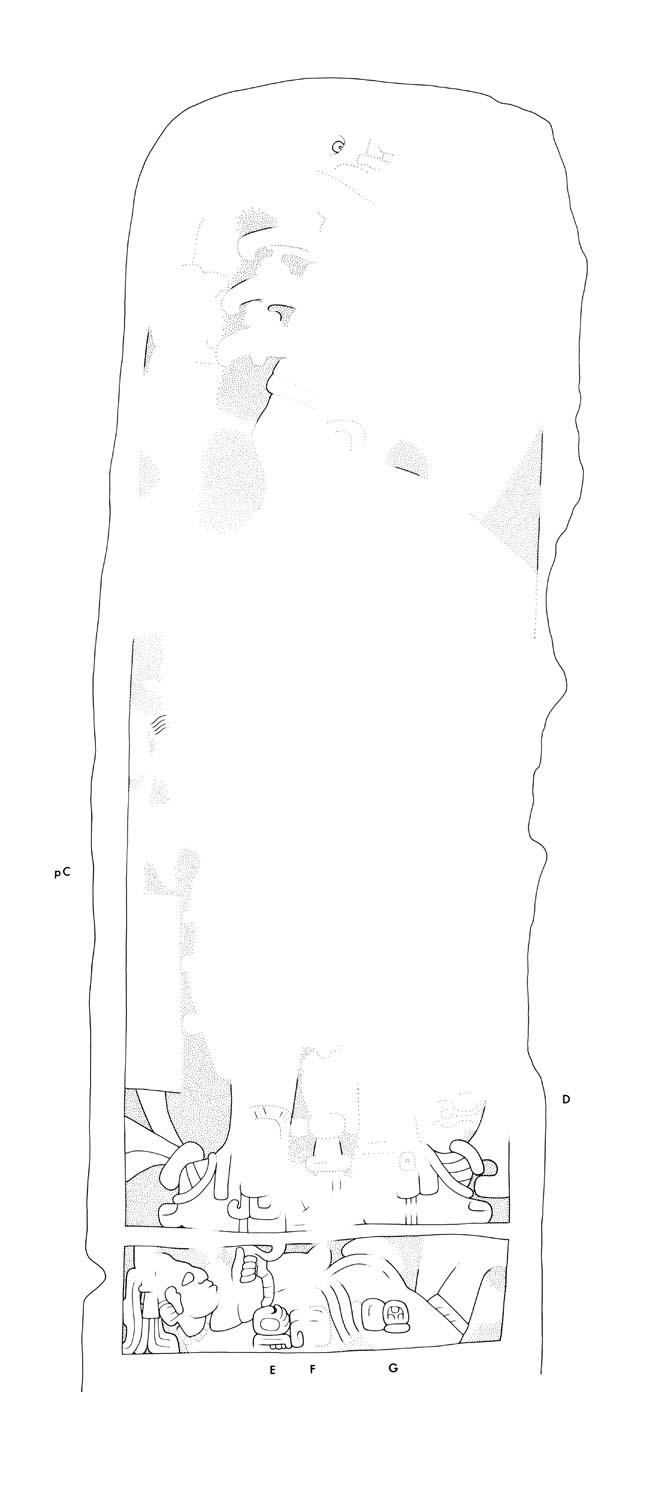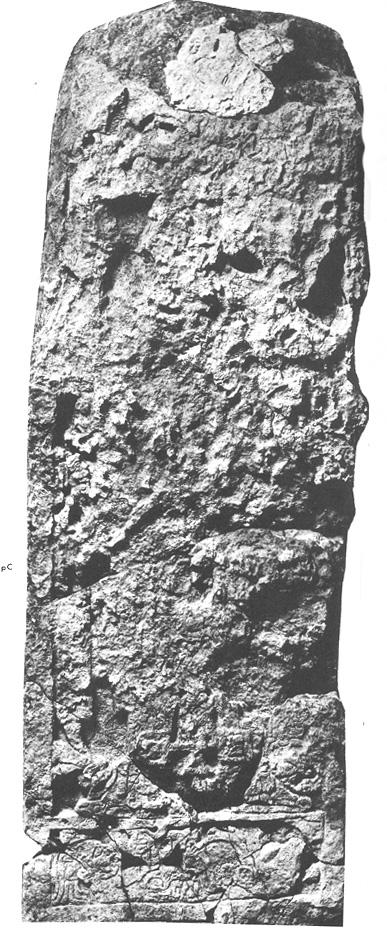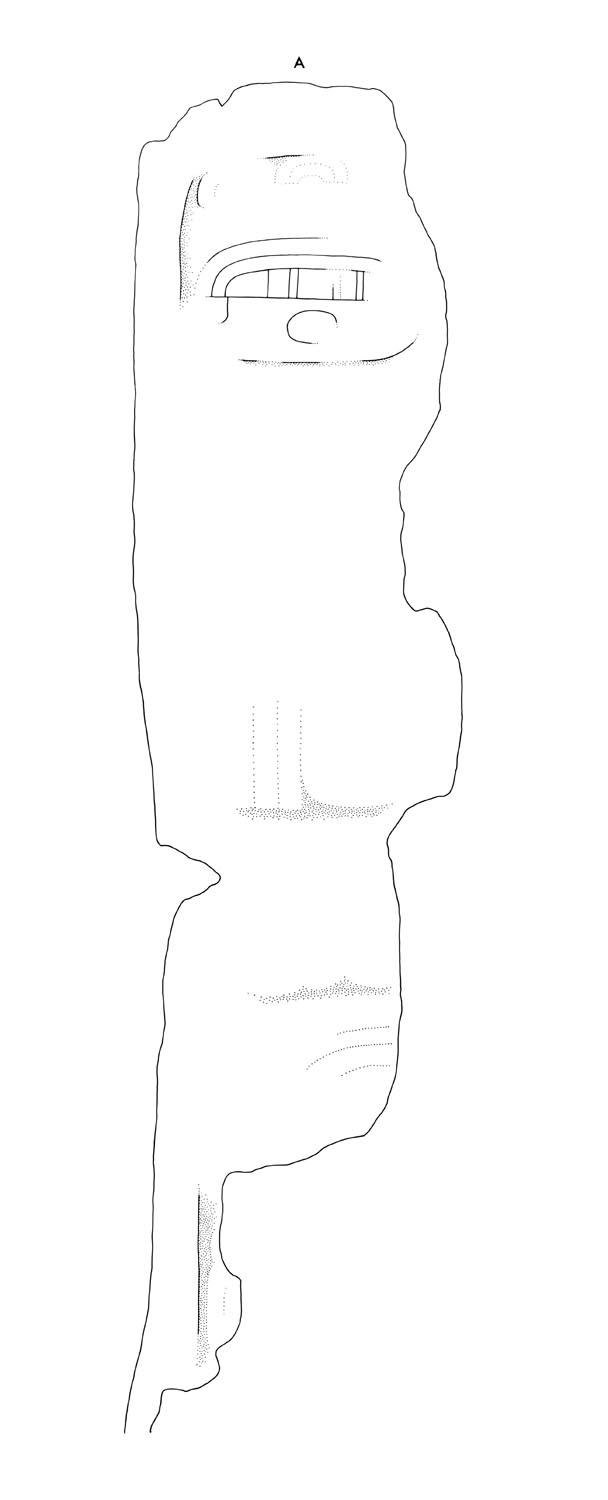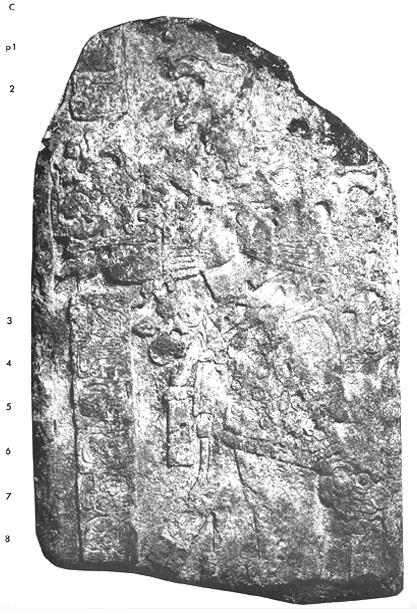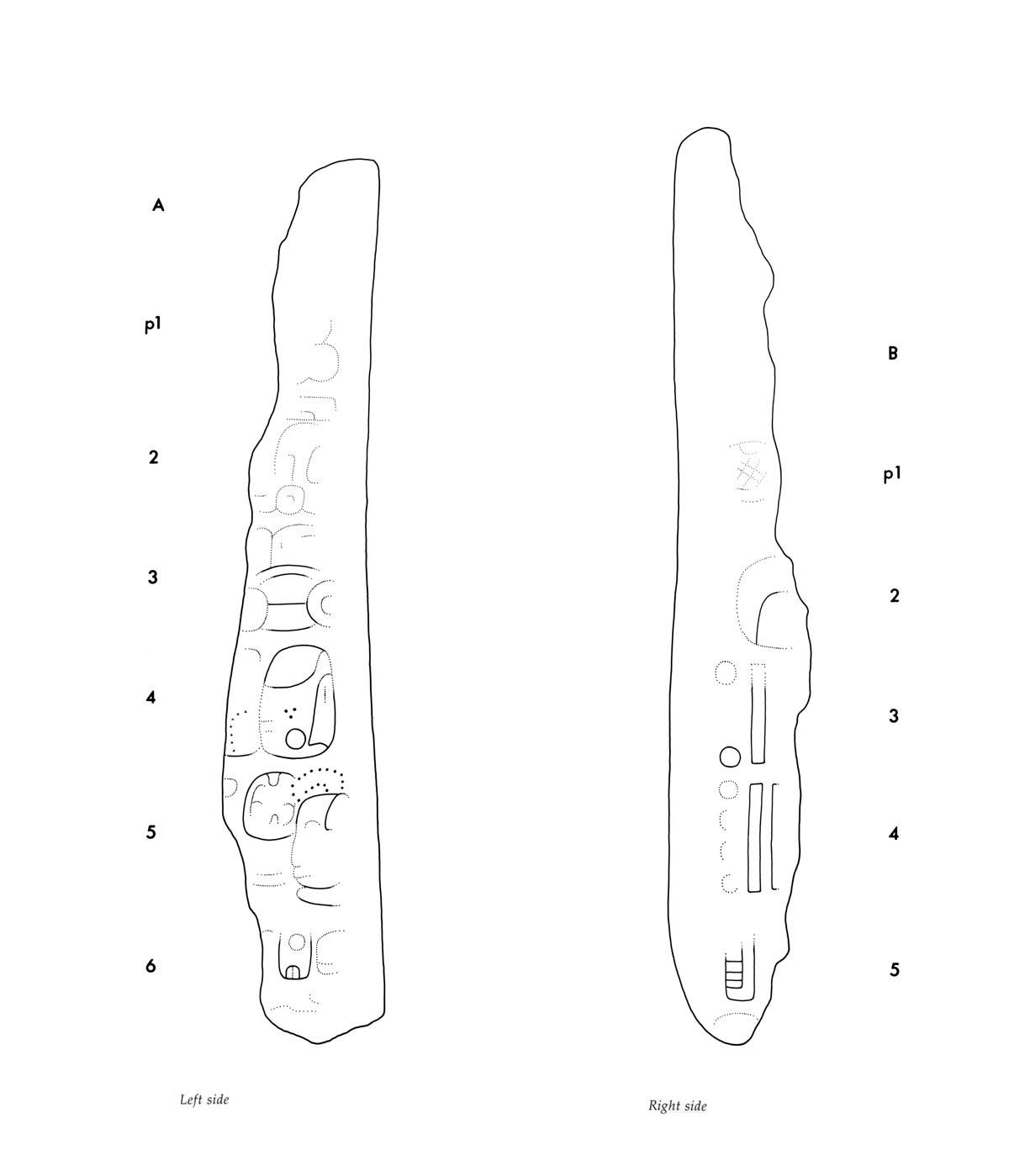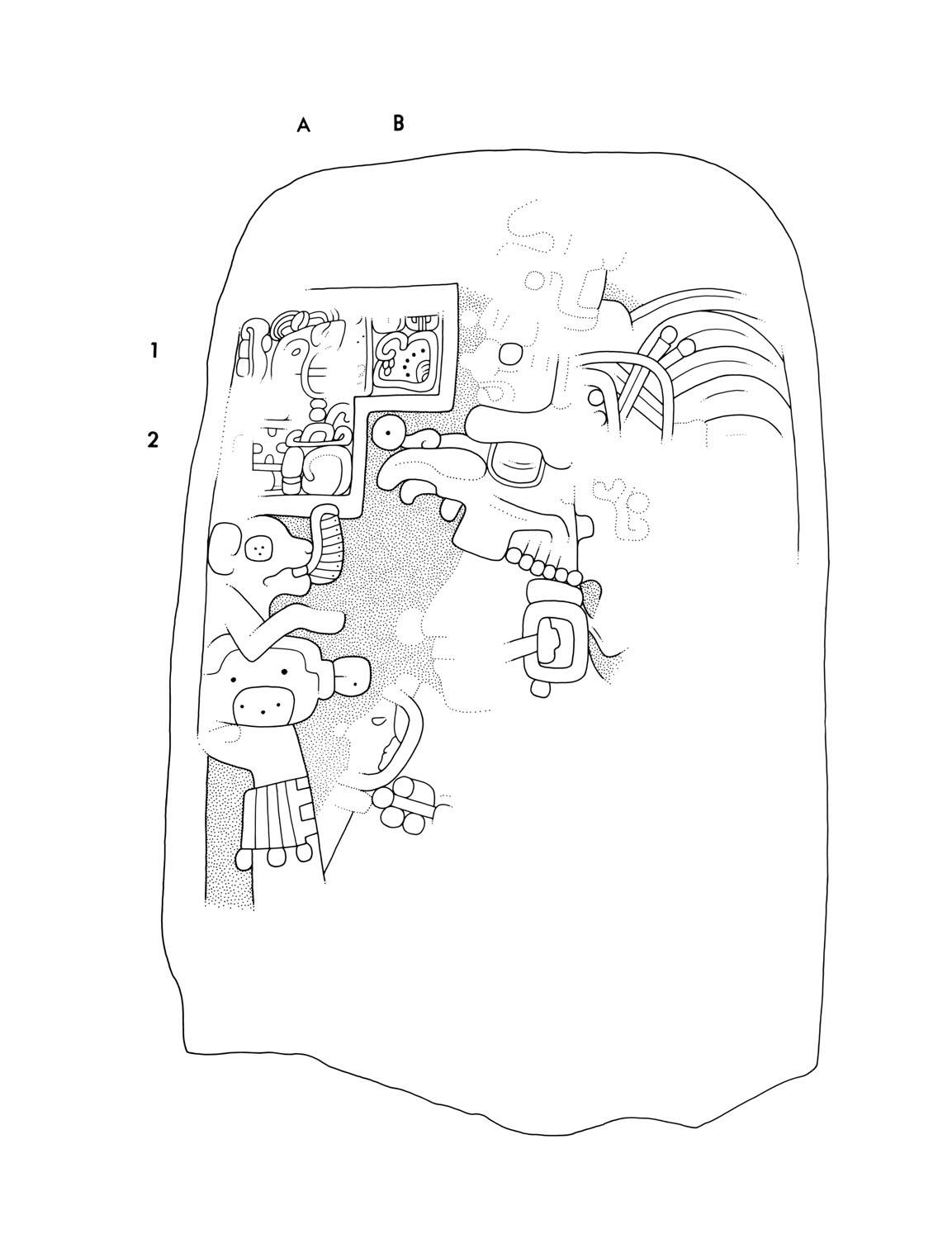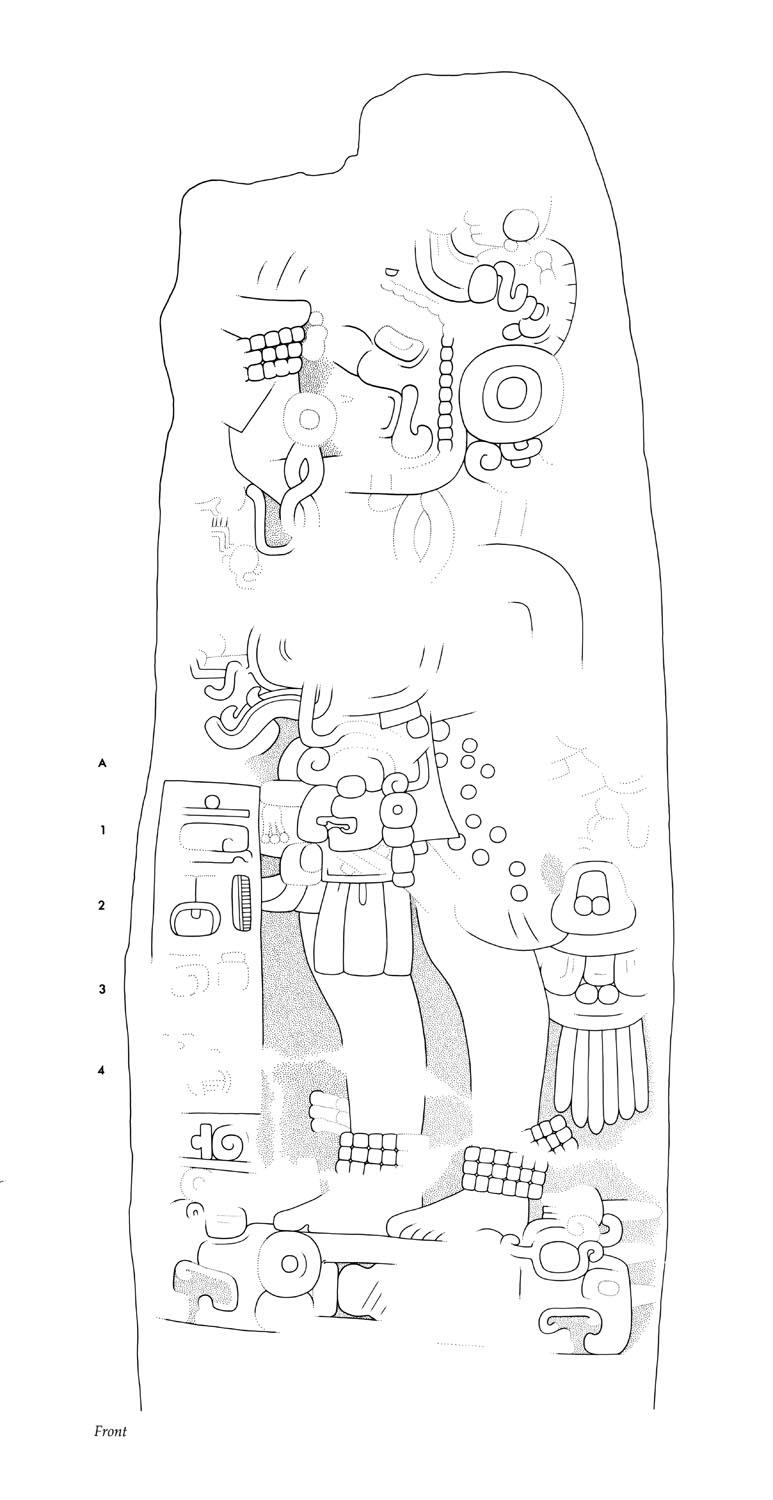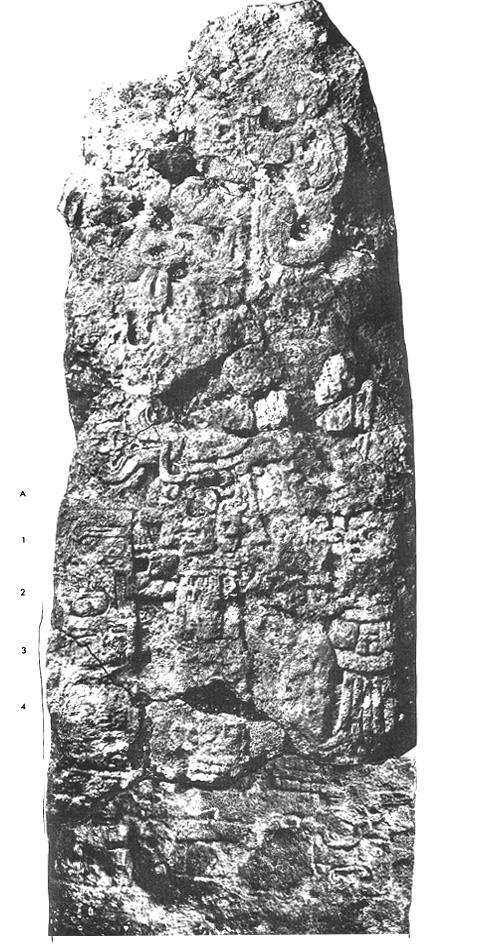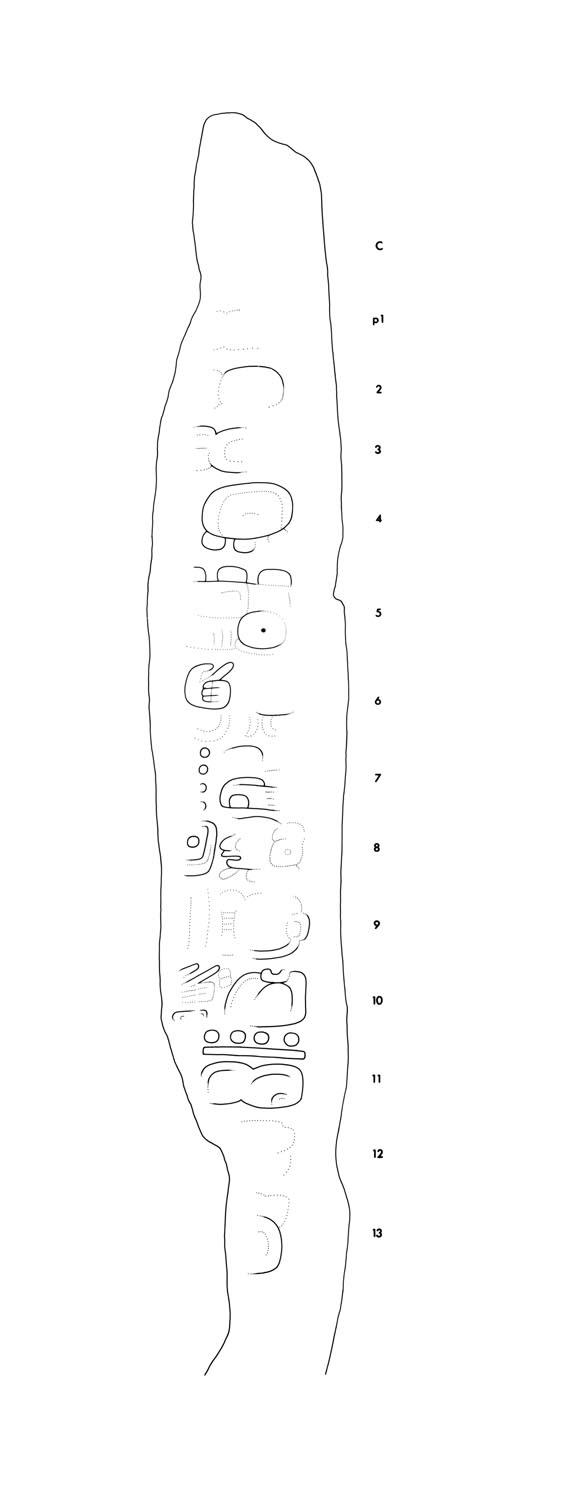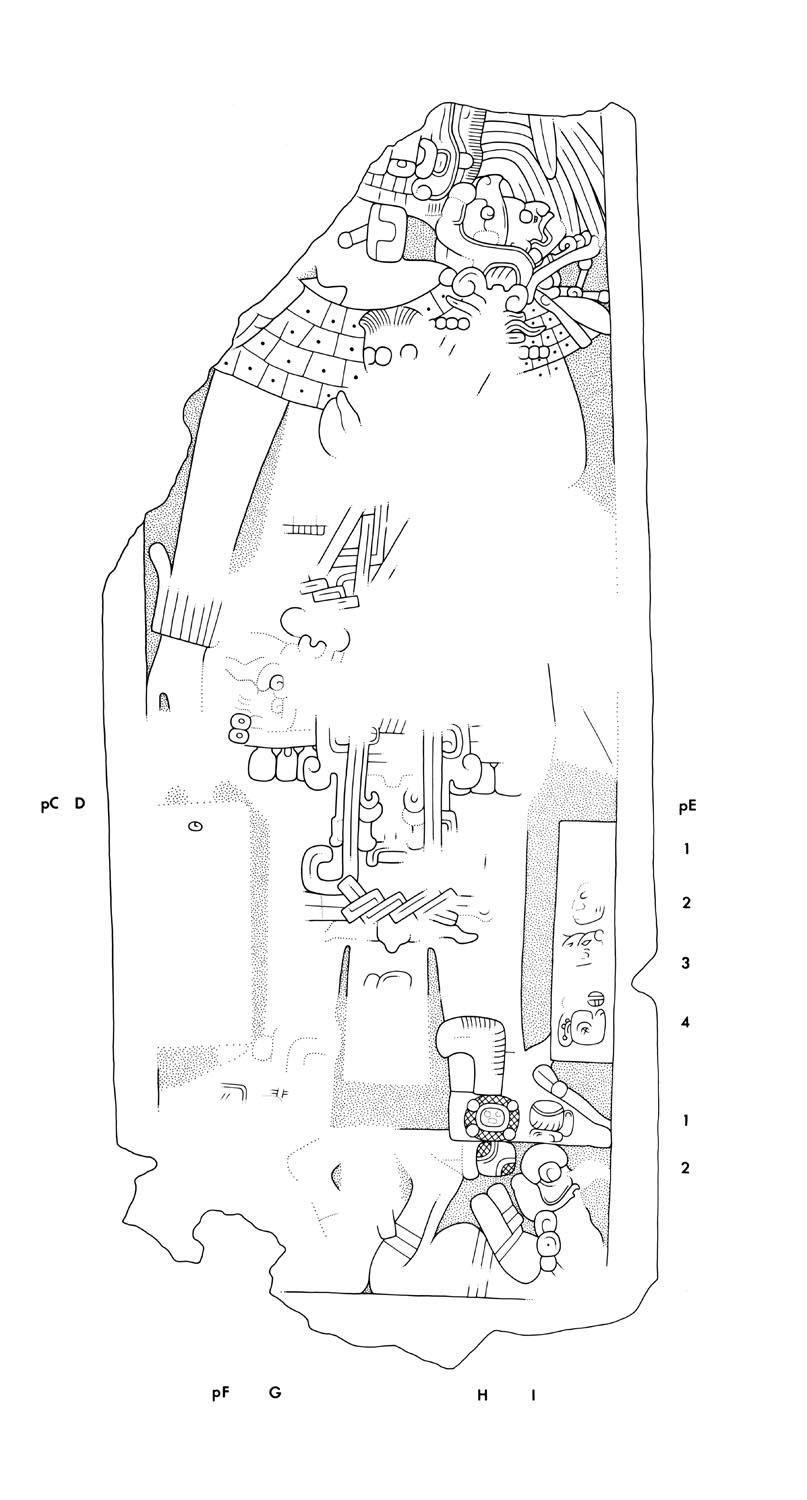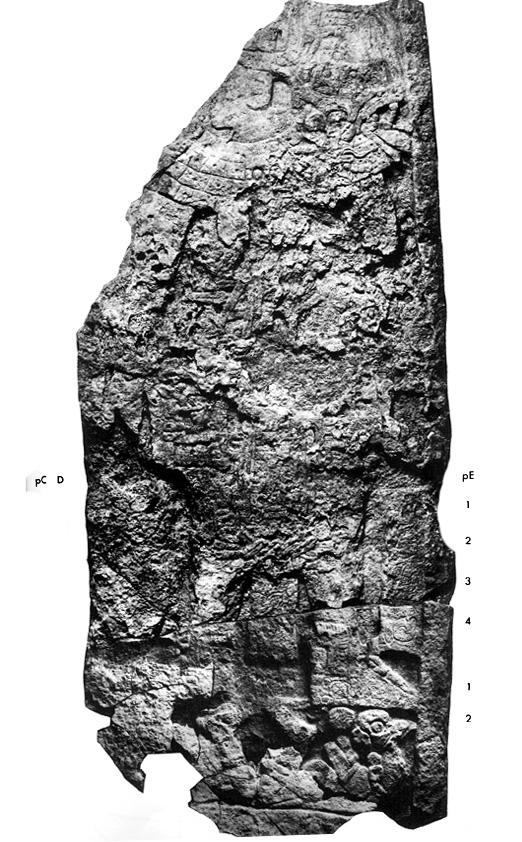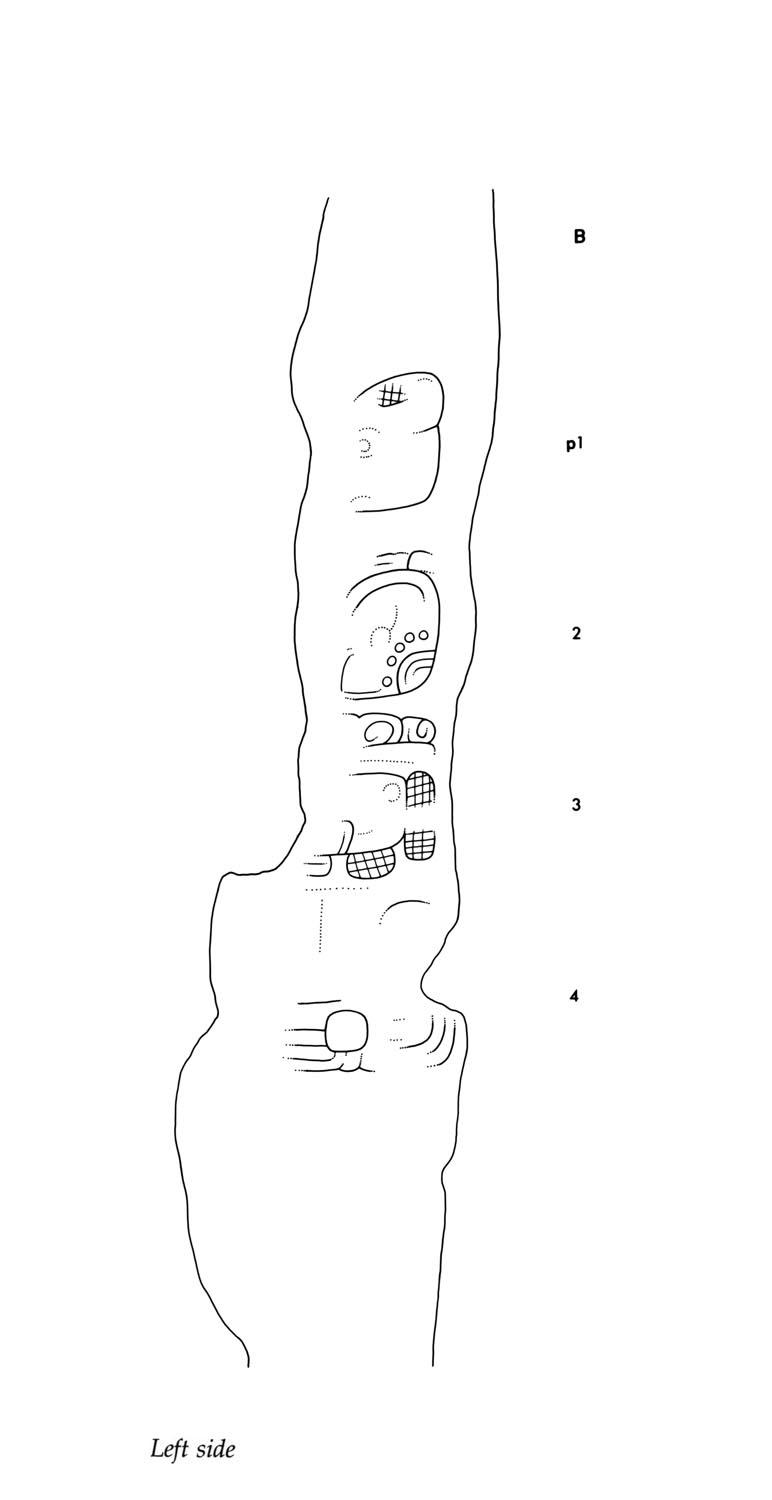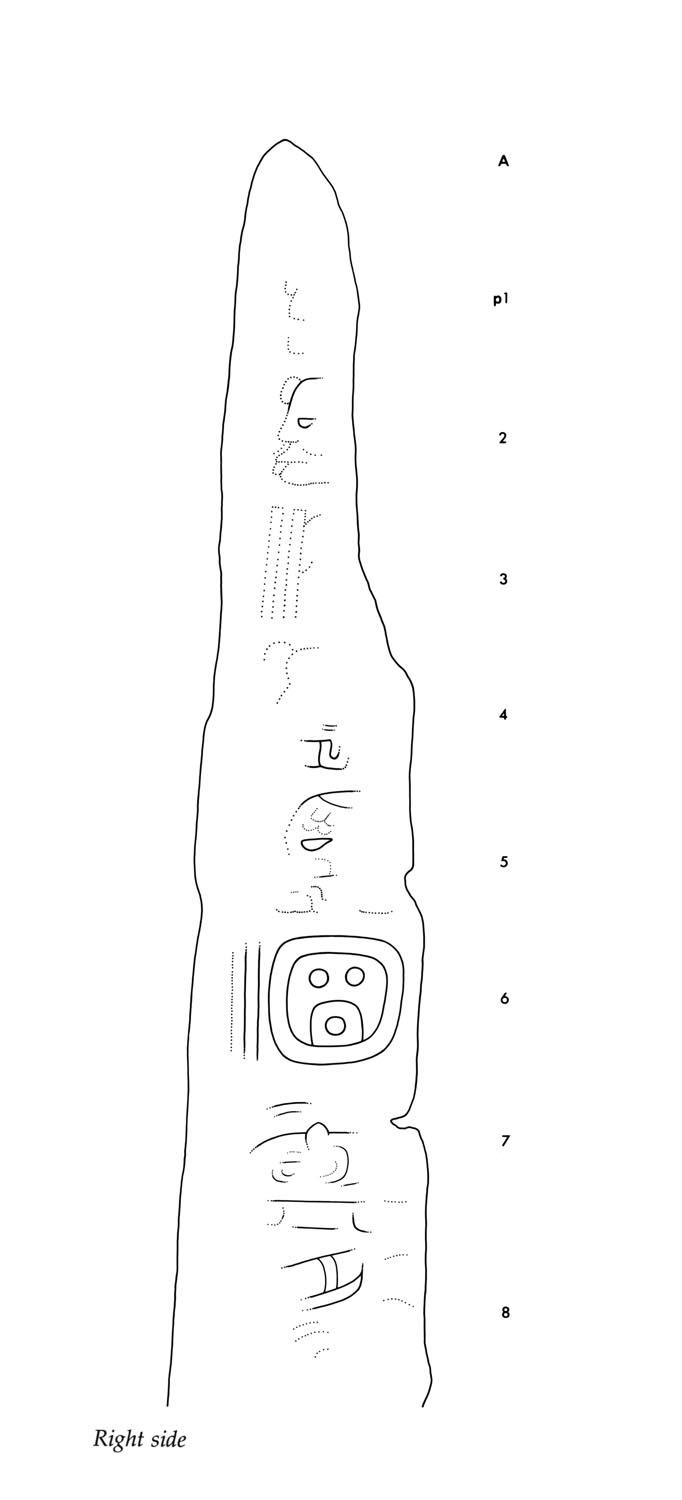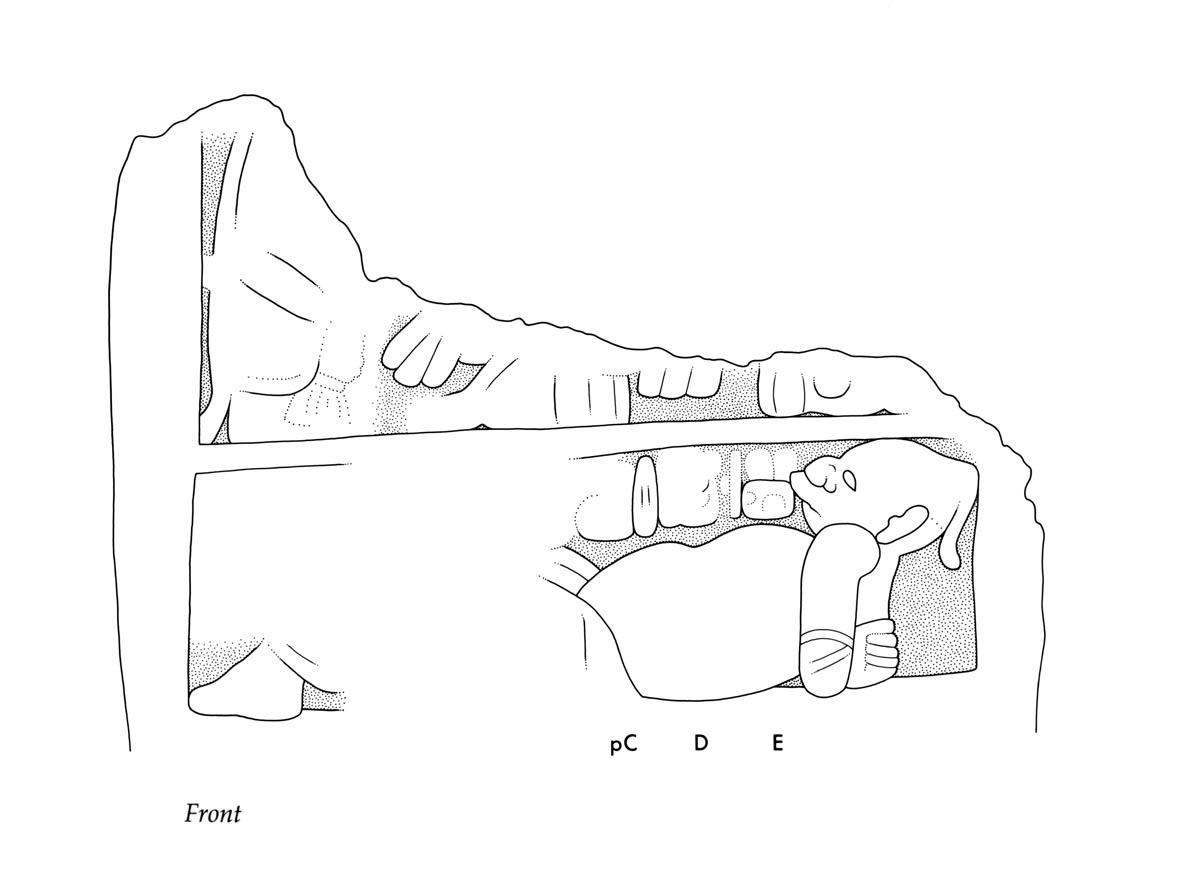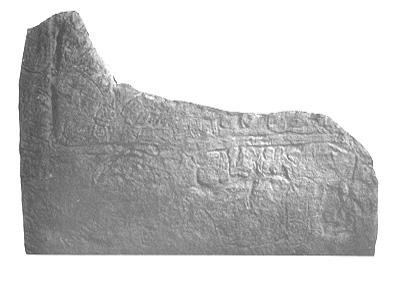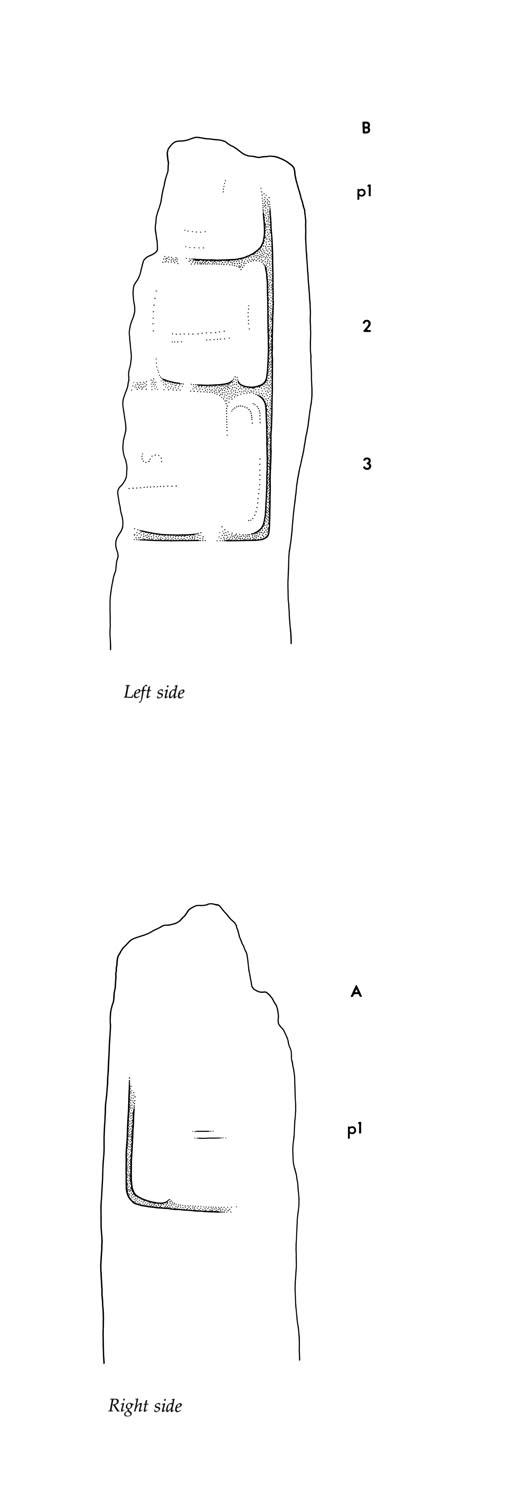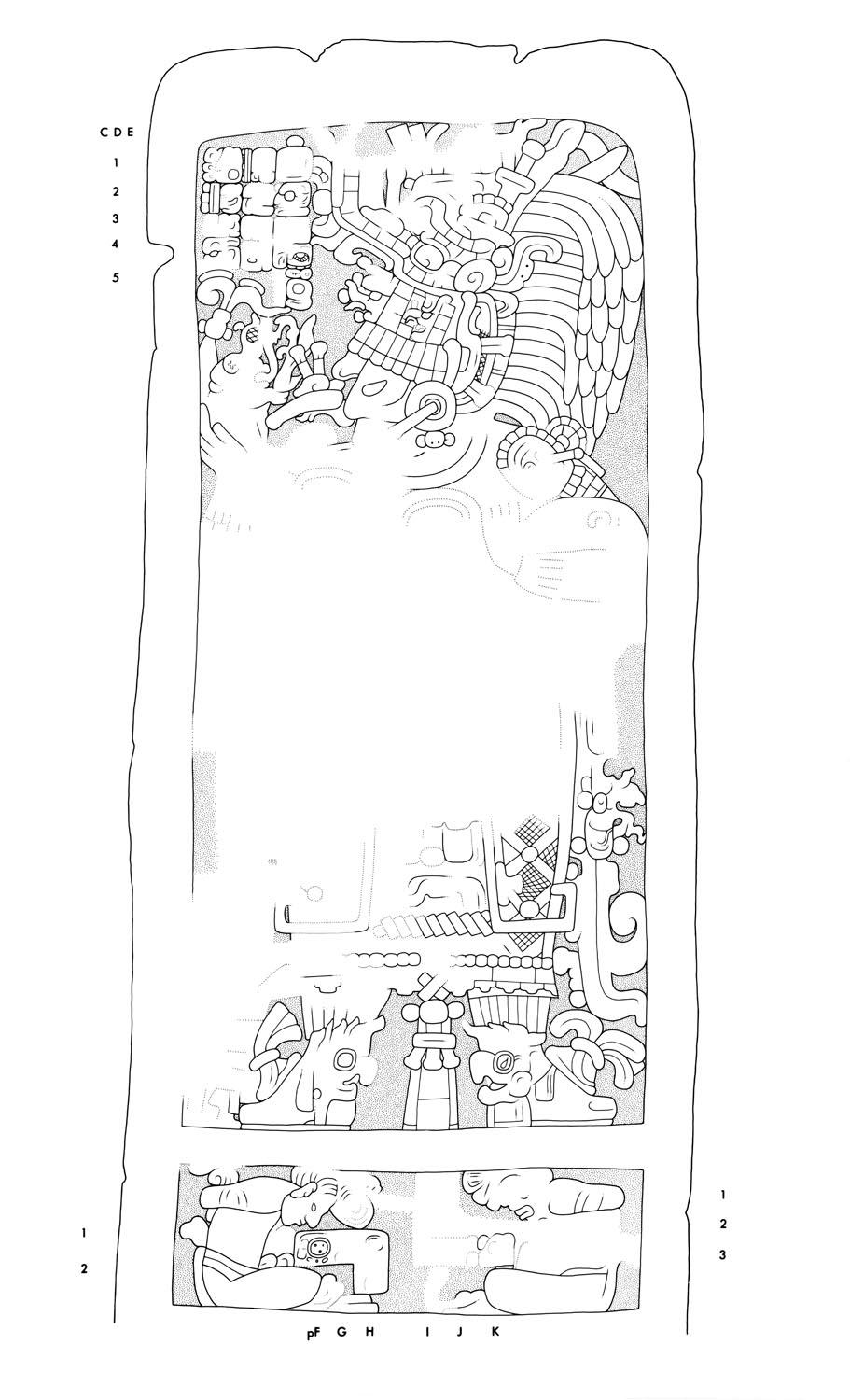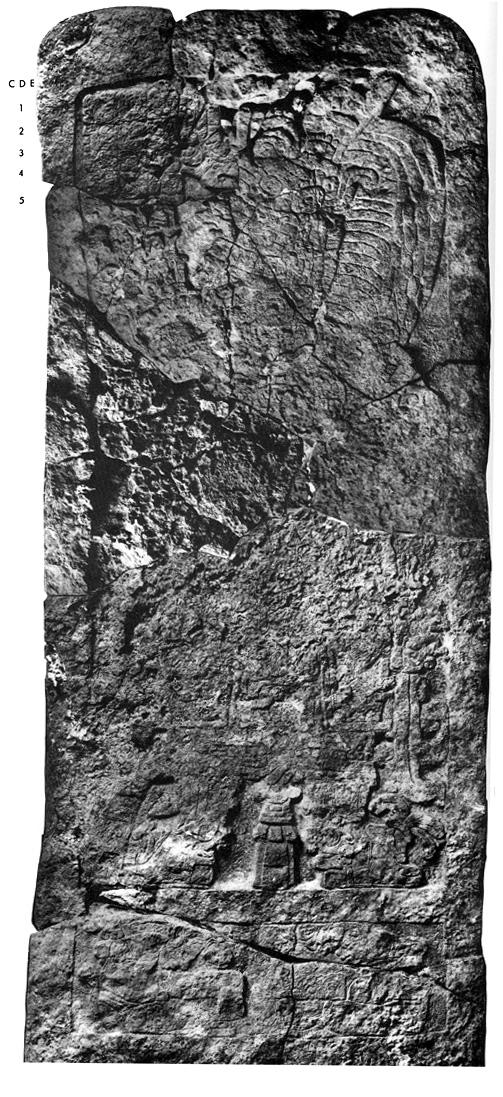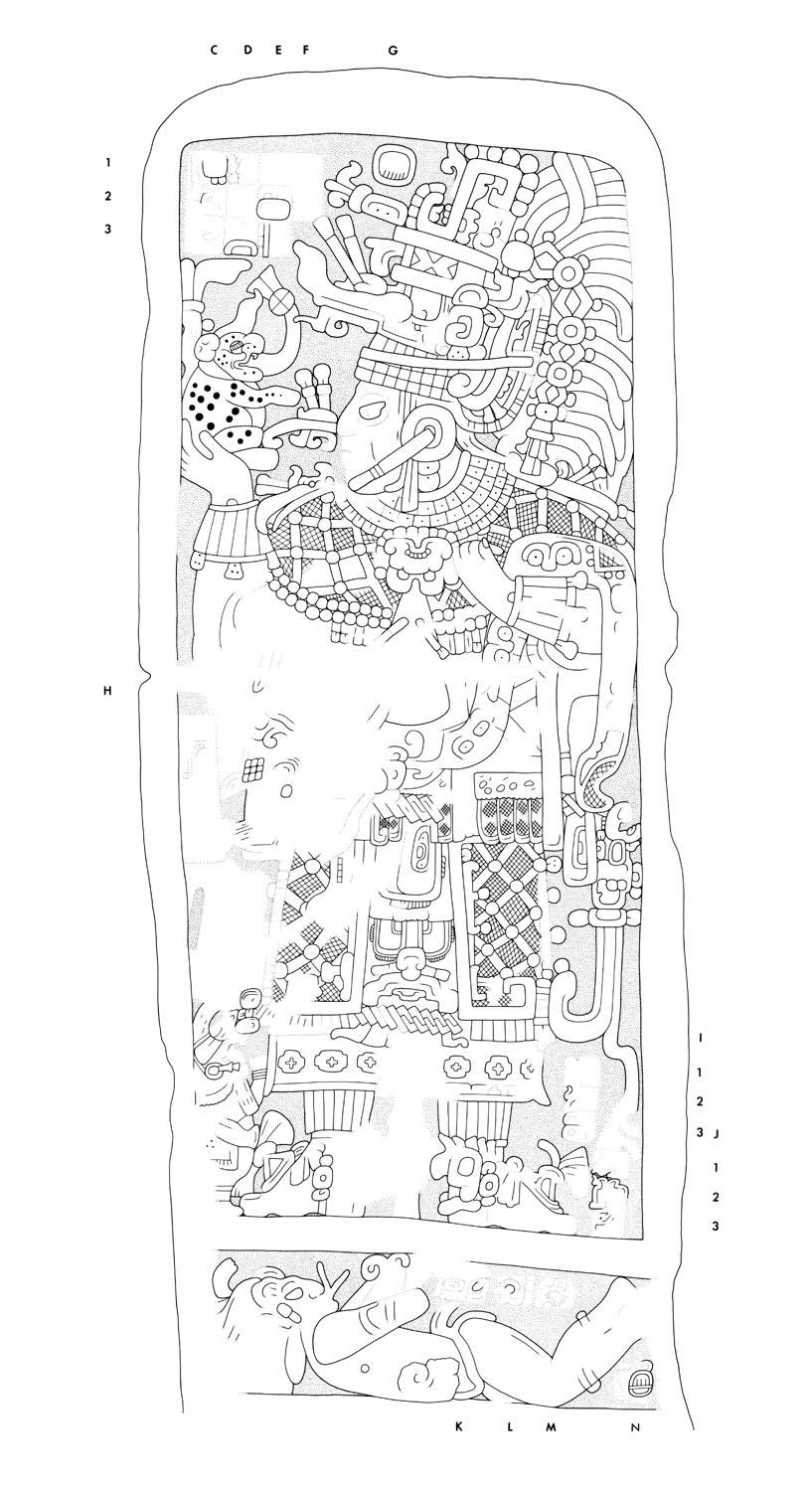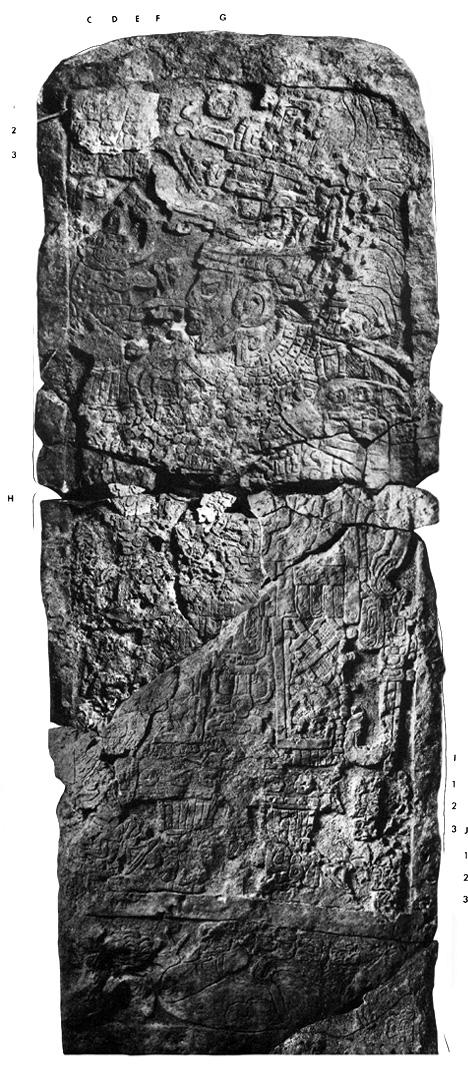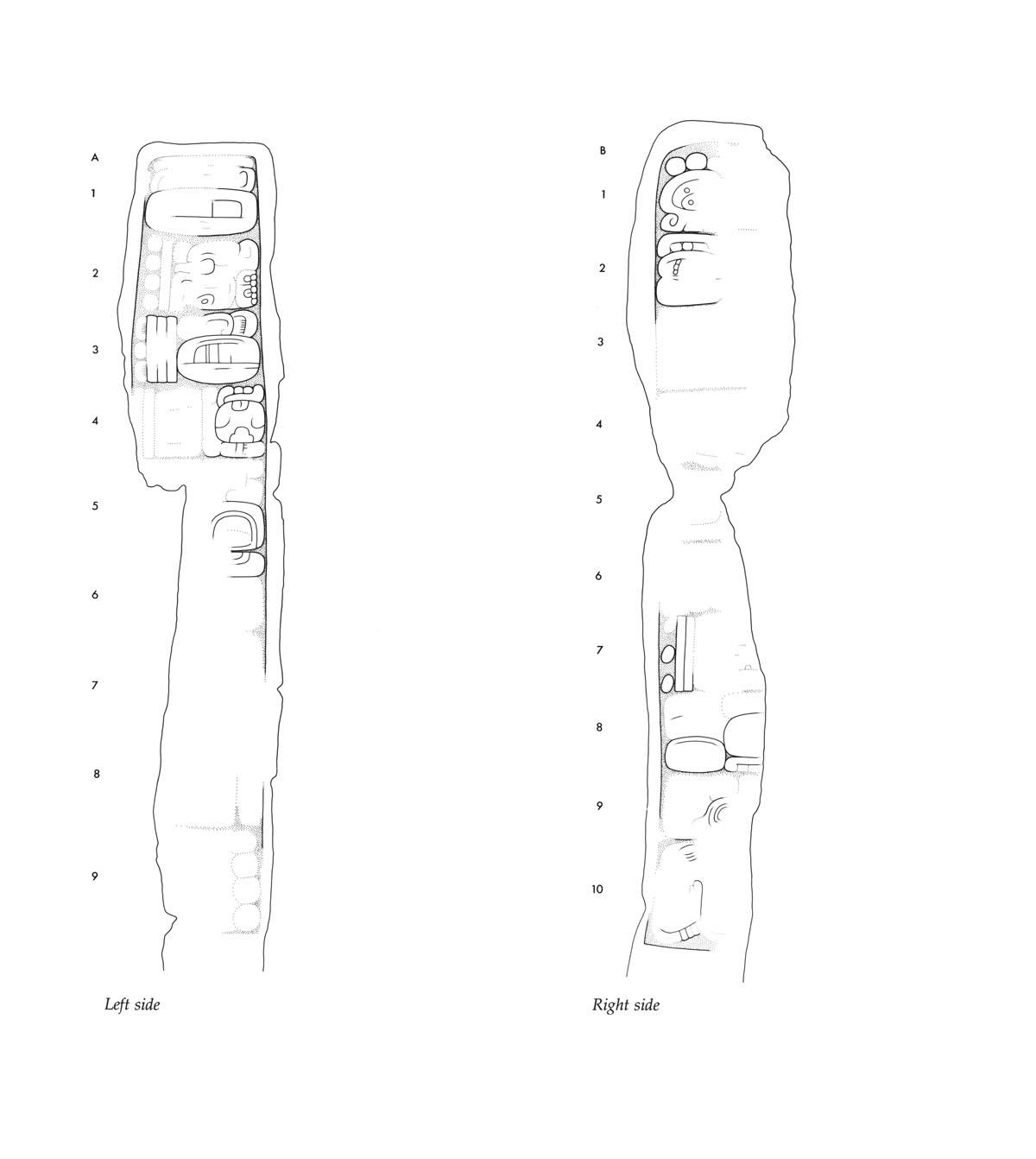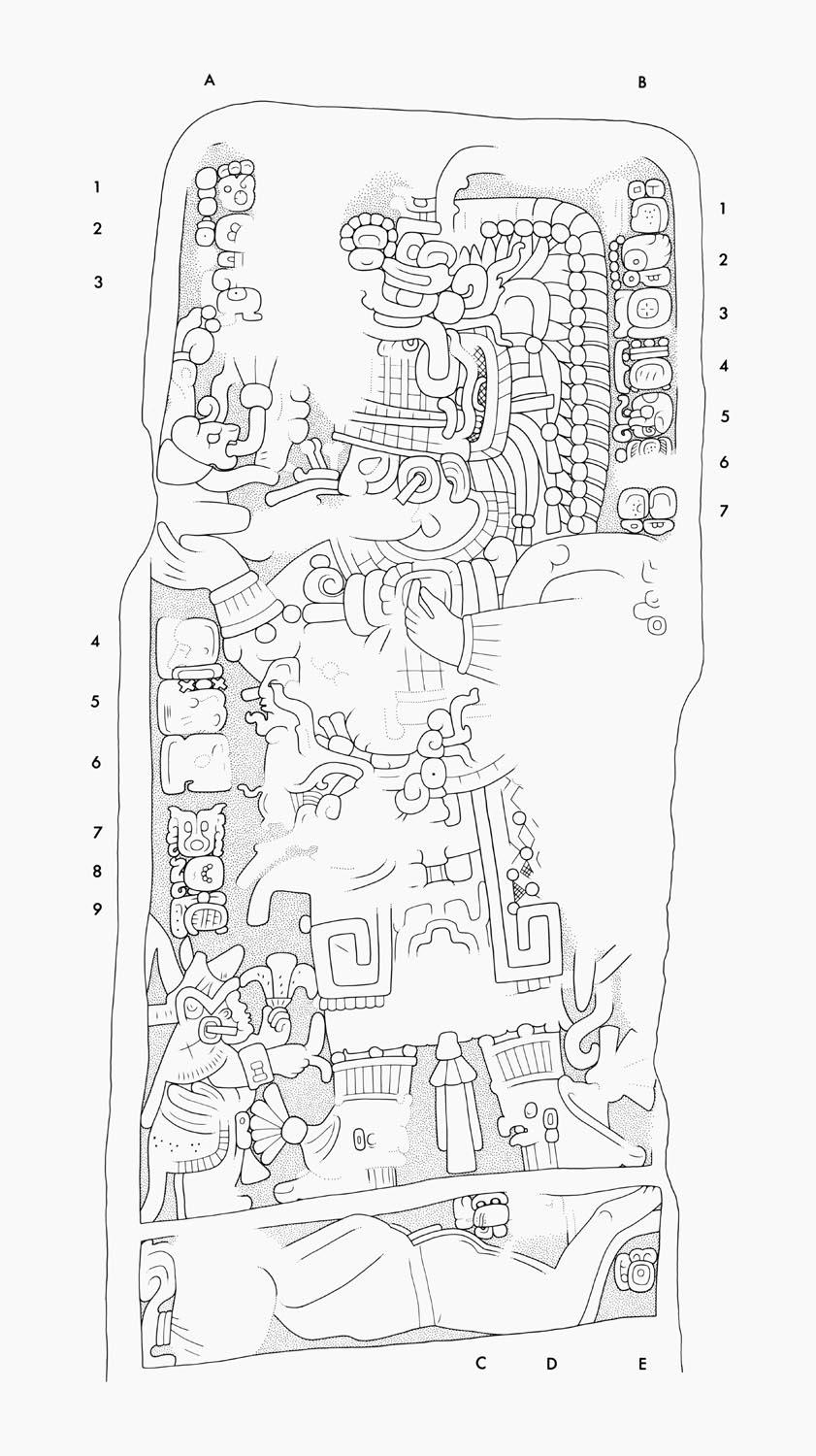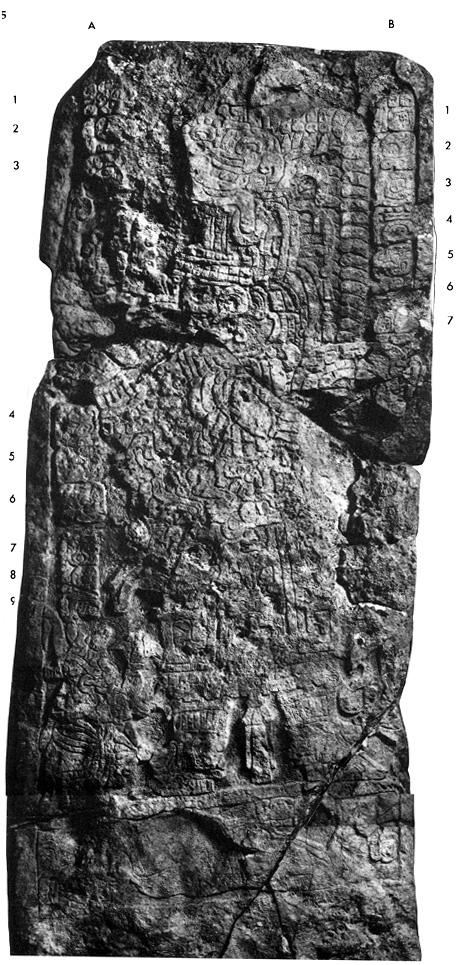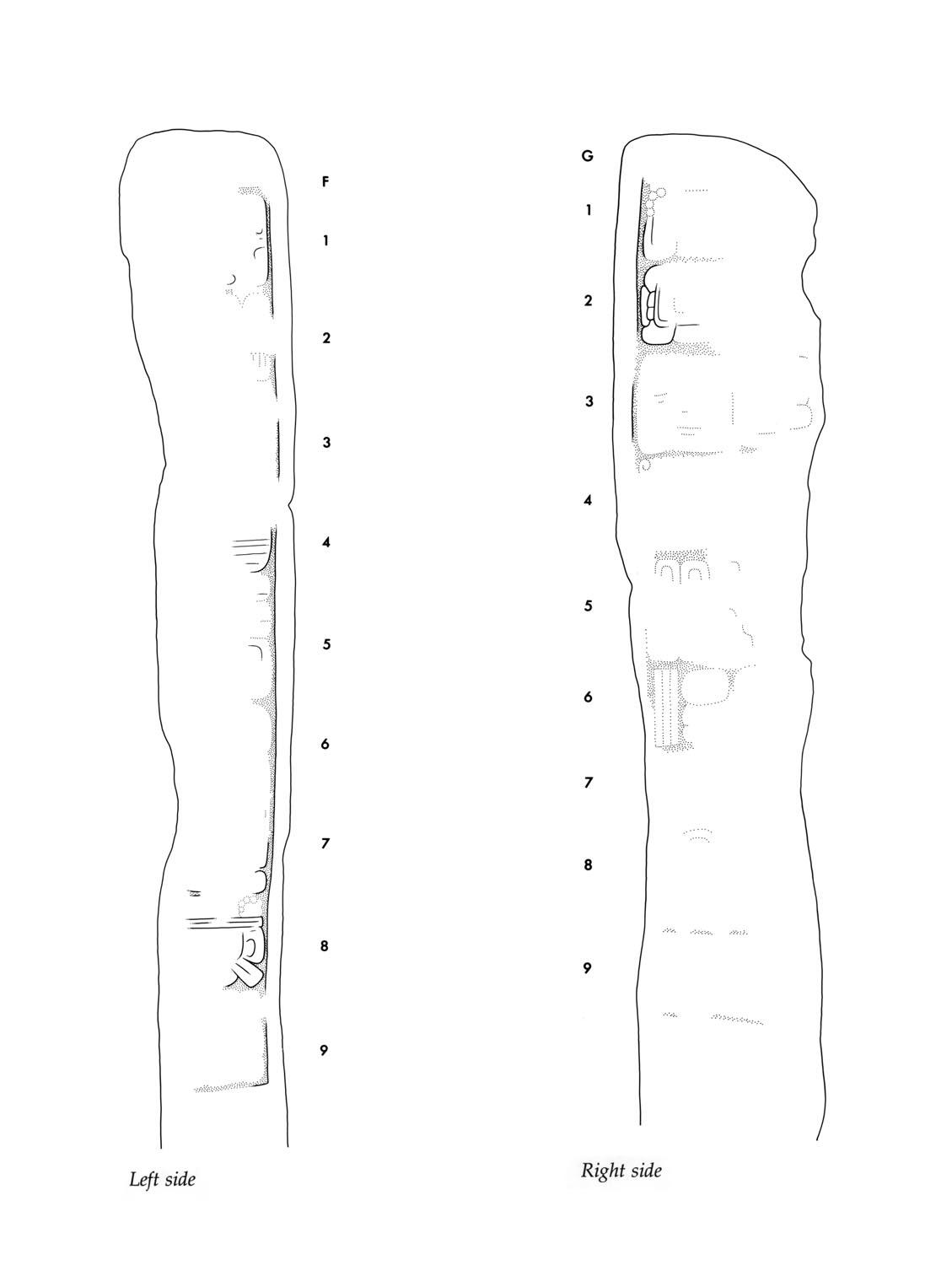Xultun
Location and Access
Xultun is located on high ground west of the Ixcan River (Rio Azul), approximately 28 km east-northeast of Uaxactun. Several aguadas are within easy reach of the site. Three of these are fairly constant sources of water: EI Delirio (2 km north), Los Tambos (2 km south), and Petipet (3.5 km west-southwest). Two other small aguadas (one 1.5 km south and the other 2 km southwest) are less reliable. Both of my journeys to the site began at Uaxactun, which is accessible year-round by plane and during the dry months by road from Tikal. I used the road in 1974 and traveled by plane in 1975. The route taken during my first visit to XuItun is indicated on the map.
Starting from Uaxactun in a northeasterly direction along the airstrip, one enters the Baja de la Juventud and continues along the trail in the monte baja for two hours (except for a few minutes in serrania) in a generally east-northeast direction. The path then turns eastward for approximately 2 km in changing terrain, before heading north for 4 kIn to the camp and aguada (dry in 1974) of La Palma (one crosses a dry riverbed a half hour before reaching La Palma).
From La Palma one continues east-southeast for a little less than 2 km (crossing mounds on two occasions) before heading generally northeast for 3 km, where, after crossing a baja, more ruins can be noted. Traveling 2 km in an easterly direction, one traverses a group of structures (some of which have been looted), and, after an additional hour of east-northeast travel, comes to the camp and aguada of Santa Marfa (actually a corriente or, here, a series of connected pools). Continuing slightly north of east for 8 km, one reaches the aguada of Hormiguero (dry in 1974). A "trocopas" (an old lumber road or "truck pass") from Yaloche to Dos Lagunas (now overgrown) is passed less than 2 km after leaving Santa Maria, and ruins and chultunes are seen often after crossing this old road.
From Hormiguero one follows a path south, passing several clusters of mounds before reaching the aguada of Petipet. Although the water at Petipet is the color of coffee, it is drinkable and fairly abundant. Fortunately this strangely named chicle camp retained its original name throughout the fifty years following the expeditions of the Carnegie Institution of Washington, as Xultun's approximate location was known in relation to that of Petipet. (Morley places Xultun about 3.5 km east of Petipet; it is actually slightly north of east.)
The path I took from Petipet to Xultun in 1974 was considerably longer than the actual distance separating the two sites (3.5 km). Following a roundabout set of trails, I traveled east-southeast for about one hour, then turned north near the abundant water source of Los Tambos, and continued in this direction for 3 km before reaching the center of Xultun. Another aguada, which was dry in 1974 but which supplied me with water the next season, is about halfway between Los Tambos and XuItun. Mounds are very much in evidence along this route, especially on the section closest to Xultun.
In 1975 I used a different route, shorter by 3 km (also indicated on the map), to leave the site. This path had been opened by a band of looters during the rainy season of 1974 in order to reach an aguada and camp southwest of the ruins. I also took a shorter, and unmapped, route in a westward direction from Petipet through the camps and aguadas of Arroyon and Caldera to reach Uaxactun.
The route taken by the expeditions from the Carnegie Institution of Washington in the 1920s (traveling northwest from Laguna Yaloche) is considerably longer than the paths I took.
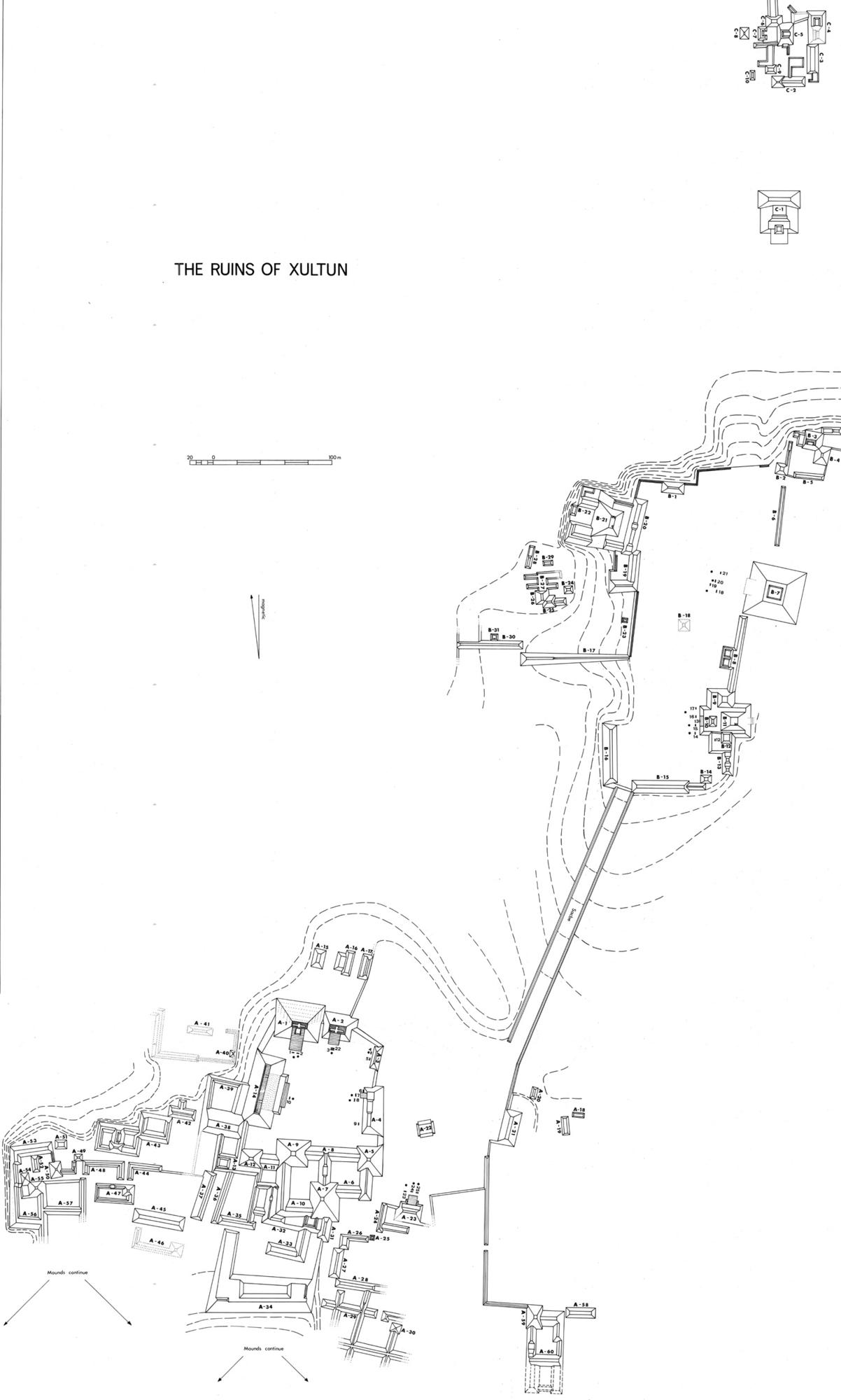
Principal Investigations at the Site
In March 1920, about four and a half years after the site was discovered by a chiclero named Aurelio Aguayo, the Carnegie Institution of Washington (CIW) organized the first of three visits to Xultun with its Fourth Central American Expedition. At that time S.C. Morley and C.E. Cuthe gave the site its name, which may be translated as "end stone" or "closing stone" a reference to the late date recorded in Stela 10 (10.3.0.0.01 Ahau 3 Yaxkin). During the three-day exploration, Stelae 1 to 17 were found (although the numeration was changed slightly later on) and a partial plan of Group A was made (Morley 1920, pp. 322-324). Less than a year later Morley, togetherwith a.c. Ricketson, Jr. and A.K. Rutherford, spent a week at Xultun with the Fifth Central American Expedition. At this time Stelae 18 to 22 were found and additional notes and photographs were secured (Morley 1921, pp. 359-362). The last visit was made in April 1923, when the Seventh Central American Expedition stopped in Xultun, and W.A. Love and Ricketson determined the coordinates for the site. All the information known about this site up until the time of my explorations was the result of these three visits and was subsequently published in The Inscriptions of Petell (Morley 1937-38, vol. 1, pp. 383-422).
My work at the site was carried out during two visits: the first from March 23 to April 15, 1974, and the second from February 15 to March 18, 1975.
Notes on the Ruins
Considering the short time Morley and his colleagues spent at Xultun, it is remarkable how much information they were able to retrieve from the site. Although their visits totaled only ten days, they managed to find all but three of the stelae, photograph the majority of them, and produce a reasonable plan of most of Group B and the central area of Group A, plus a good description of the site (Morley 1937-38, pp. 385, 386). Morley was obviously well aware that the site had been inadequately surveyed and that it extended over a considerably larger area than he was able to include in his map.
In 1975 I spent approximately ten days mapping the site. It soon became apparent that C too, would be unable to cover the entire area, but would have to concentrate on the central groups alone, as the site continued in many directions, especially to the south and west. Although for the most part the structures become smaller and less densely spaced as they spread out, they extend for at least 1 to 1.5 km to the south, 2 km to the southwest, and clusters are found all the way to El Deliria, 2 km north, and may continue beyond. The ruins do not seem to extend east of Group B, however. In general. Morley's designations for the structures have not been followed, because the several new features that were incorporated into my plan made changes in numeration desirable.
Some new discoveries were made during my explorations: three stelae (23,24,25) and a ball court (Structures A-16, A-17) were found. The large Structure C-1, north of Group B, had apparently been missed by the CIW, as had the sacbe connecting the southwest corner of Group B to a large flat area (on which Stelae 23 to 25 and the building they face are located, as is the ball court some 200 m north of the stelae). Many additional mounds were added to Group A, and the western part of Group B was found to be more complex and extensive than Morley had indicated.
The largest structure at Xultun is Structure B-7. Its base is almost square, each side measuring about 45 m; it rises 24 m to a platform supporting a small structure 1.5 m high. Four stelae (18 to 21) were set in front and approximately 30 m west of this massive structure. At its northern end, 8-7 is connected by a long, low construction to a small group of mounds, and to the south it is connected by another low building to a platform supporting several structures (B-9 to 8-12); five stelae (13 to 17) were set up in front of this platform, and Stela 12 was placed on top of it, west of Structure 8-12. To the north and to the west (and to some extent to the south) of the large plaza of Group B, there is a rather sharp drop in the terrain; construction seems to have been confined generally to the flat raised area. Most ofthe structures demarcating this high terrain are relatively low, except for the northwest group (Structure B-21 rises from the ground level 5.5 m in the east and 12 m in the west). Two long structures (B-17 and B-30) and a cluster of smallish mounds (8-24 to 8-29) complete this group.
About 150 m north of the northernmost structures of Group B is Structure C-l, one of the largest at Xultun: the base is approximately 30 by 35 m, and it reaches a maximum height of 16.5 m (intermediate terraces are at 8,9, and 10 m). Some 80 m north of C-I is a group of medium·sized mounds. I limited my explorations of Group C to C-I and this cluster of mounds.
A number of impressive constructions enclose the main plaza of Group A, which is raised approximately 5 m above the surrounding terrain. The highest and most imposing of these structures is A-I, where the pyramidal substructure rises very steeply to a height of 24.5 m and is surmounted by a vaulted building 5.5 m high. The rear of A-I reaches a height of 35 m above the ground, even though the roofcomb has collapsed. Stelae 1 and 2 were set in front of the stairway leading up to the temple of A-I; and Stelae 3 and 22 (which is directly behind Stela 3) were set facing the stairway of Structure A-2, just east of A-I. Structure A-2 rises 16 m above the plaza floor. Stela 10 was set in front of another impressive mound (A-14) on the west side of the plaza. This building is 60 m long at the base, and where the roofcomb survives, reaches a height of 17 m. Six stelae were placed on the eastern side of the plaza (Stelae 4 and 5 facing A-3; Stelae 6 to 9 facing A-4).
The southern side of the main plaza of Group A is also very impressive with three imposing structures (A-5, A-7, and A-9) which rise steeply to heights of 19,17, and 15.5 m respectively and are connected by buildings 4.5 to 7 m high, forming two small courts, South and west of the main plaza many other structures were built, forming a large number of courts, often with fair-sized mounds in one corner.
The last three stelae (23 to 25) were set facing south (in front of Structure A-23), the only ones so placed at the site.
The ball court (A-16 and A-I7) was built north of Structures A-I and A-2.
The area between the ball court and Group B and west of the sacbe is a large guanal.
Standing on Structure A-54, at the edge of an 8 m drop in the terrain, looking westward, I wrote in my notebook, "many mounds visible, some large." Similar observations were made looking south from Structures A-56, A-46, A-34, andA-30. There was not sufficient time to extend the map further. Other fairly high mounds are A-54 (10.5 m), 6-11 (9 m), and A-12 and A-38 (8 m), and there are many structures higher than 5 m. Three sunken structures (A-2S, B-23, B-31) were noted as well.
Remarks
No evidence was found to support Morley's placement of some of the altars.
As a matter of fact no altars were found for Stelae 5, 9, and 19; the one for Stela 20 was questionable at best, as it consisted of nothing more than rubble. There was an altar approximately equidistant from Stelae 16 and 17, rather than in front of Stela 16, as Morley indicated. Nor was Morley's Altar A-I found, although there is a limestone outcropping at the approximate location indicated by the CIW map.
Latex molds were made of the glyph panels on the fronts of Stelae 4, 5, 9, 14, 15, 16, 18, 19, 20, 21, 23, 24, and 25 and of the front of Stela 22 and of the lowest ("slave") panel of Stela 4.
In the early seventies, Stelae 3 and 12 were looted; in late 1974 Stela 10 disappeared. At the time of my first visit to the site, large trenches had been dug into Structures A-S, A-7, A-9 and many smaller buildings. (The looters were active in the site when we arrived, but left four days later when it became apparent that we planned an extended stay). A year later Structures A-I, A-2, A-3, A-5 (again) and many others had been tunneled through by people who made a camp by a small aguada southwest of the site. Xultun has been savagely looted: more than 50 trenches have been made, representing the illicit activity of a number of men for many weeks in the removal of many tons of stone.
Register of Inscriptions at Xultun
Stelae 1 to 10 and 12 to 25
The top fragment of Stela 13 was incorrectly called Stela 11 by Morley. To avoid confusion, Morley's designations of the other monuments have not been altered, and the recently discovered stelae have been assigned new numbers. As a result, there no longer exists a Stela 11 at Xultun.
References Cited
MORLEY, SYLVANUS G.
1920 "Archaeology," Carnegie Institution Washington Yearbook 19. Washington, D.C.
1921 "Archaeology," Carnegie Institution of Washington Yearbook 20. Washington, D.C.
1937-38 The Inscriptions of Peten. Carnegie Institution of Washington, Publication 437, 5 vols. Washington, D.C.
Site Volume Reference
|
SITE
|
VOL/Part
|
Monument
|
Side
|
Page
|
Pub.year
|
Notes
|
Peabody Number
|
|
XULTUN
|
5.1
|
Map
|
|
5
|
1978
|
|
|
|
XULTUN
|
5.1
|
Map of Ruins
|
|
6
|
1978
|
|
|
|
XULTUN
|
5.1
|
Stela 1
|
front
|
11
|
1978
|
|
2004.15.6.11.1
|
|
XULTUN
|
5.1
|
Stela 2
|
front
|
13
|
1978
|
|
2004.15.6.11.2
|
|
XULTUN
|
5.1
|
Stela 3
|
front
|
15
|
1978
|
|
2004.15.6.11.3
|
|
XULTUN
|
5.1
|
Stela 3
|
left side
|
16
|
1978
|
|
2004.15.6.11.4
|
|
XULTUN
|
5.1
|
Stela 3
|
right side
|
17
|
1978
|
|
2004.15.6.11.5
|
|
XULTUN
|
5.1
|
Stela 4
|
front
|
19
|
1978
|
|
2004.15.6.11.6
|
|
XULTUN
|
5.1
|
Stela 4
|
left side
|
20
|
1978
|
|
2004.15.6.11.7
|
|
XULTUN
|
5.1
|
Stela 4
|
right side
|
21
|
1978
|
|
2004.15.6.11.8
|
|
XULTUN
|
5.1
|
Stela 5
|
front
|
23
|
1978
|
|
2004.15.6.11.9
|
|
XULTUN
|
5.1
|
Stela 5
|
left side
|
24
|
1978
|
|
2004.15.6.11.10
|
|
XULTUN
|
5.1
|
Stela 5
|
right side
|
25
|
1978
|
|
2004.15.6.11.11
|
|
XULTUN
|
5.1
|
Stela 6
|
front
|
27
|
1978
|
|
2004.15.6.11.12
|
|
XULTUN
|
5.1
|
Stela 6
|
left side, right side
|
28
|
1978
|
both on one paper
|
2004.15.6.11.13
|
|
XULTUN
|
5.1
|
Stela 7
|
front
|
29
|
1978
|
|
2004.15.6.11.14
|
|
XULTUN
|
5.1
|
Stela 7
|
left side, right side
|
30
|
1978
|
both on one paper
|
2004.15.6.11.15
|
|
XULTUN
|
5.1
|
Stela 8
|
front
|
31
|
1978
|
|
2004.15.6.11.16
|
|
XULTUN
|
5.1
|
Stela 8
|
left side
|
32
|
1978
|
|
2004.15.6.11.17
|
|
XULTUN
|
5.1
|
Stela 8
|
right side
|
33
|
1978
|
|
2004.15.6.11.18
|
|
XULTUN
|
5.1
|
Stela 9
|
front
|
35
|
1978
|
|
2004.15.6.11.19
|
|
XULTUN
|
5.1
|
Stela 9
|
left side, right side
|
36
|
1978
|
both on one paper
|
2004.15.6.11.20
|
|
XULTUN
|
5.1
|
Stela 10
|
front
|
37
|
1978
|
|
2004.15.6.11.21
|
|
XULTUN
|
5.1
|
Stela 10
|
left side
|
38
|
1978
|
|
2004.15.6.11.22
|
|
XULTUN
|
5.1
|
Stela 10
|
right side
|
38
|
1978
|
|
2004.15.6.11.23
|
|
XULTUN
|
5.1
|
Stela 12
|
front
|
39
|
1978
|
|
2004.15.6.11.24
|
|
XULTUN
|
5.1
|
Stela 11
|
front
|
41
|
1978
|
|
2004.15.6.11.25
|
|
XULTUN
|
5.1
|
Stela 11
|
left side, right side
|
42
|
1978
|
1 piece
|
2004.15.6.11.26
|
|
XULTUN
|
5.1
|
Stela 14
|
front
|
46
|
1978
|
|
2004.15.6.11.27
|
|
XULTUN
|
5.1
|
Stela 14
|
left side
|
47
|
1978
|
|
2004.15.6.11.28
|
|
XULTUN
|
5.1
|
Stela 15
|
front
|
50
|
1978
|
|
2004.15.6.11.29
|
|
XULTUN
|
5.1
|
Stela 15
|
left side, right side
|
51
|
1978
|
1 piece
|
2004.15.6.11.30
|
|
XULTUN
|
5.1
|
Stela 16
|
front
|
53
|
1978
|
|
2004.15.6.11.31
|
|
XULTUN
|
5.1
|
Stela 17
|
front
|
55
|
1978
|
|
2004.15.6.11.32
|
|
XULTUN
|
5.1
|
Stela 17
|
left side, right side
|
56
|
1978
|
1 piece
|
2004.15.6.11.33
|
|
XULTUN
|
5.1
|
Stela 18
|
front
|
59
|
1978
|
|
2004.15.6.11.34
|
|
XULTUN
|
5.1
|
Stela 18
|
left side, right side
|
60
|
1978
|
|
2004.15.6.11.35
|
|
XULTUN
|
5.1
|
Stela 19
|
front
|
61
|
1978
|
|
2004.15.6.11.36
|
|
|
|
|
|
|
|
|
|
|
XULTUN
|
5.2
|
Stela 20
|
front
|
69
|
1984
|
|
2004.15.6.12.1
|
|
XULTUN
|
5.2
|
Stela 20
|
left side, right side
|
70,71
|
1984
|
1 piece
|
2004.15.6.12.2
|
|
XULTUN
|
5.2
|
Stela 21
|
front
|
74
|
1984
|
|
2004.15.6.12.3
|
|
XULTUN
|
5.2
|
Stela 21
|
left side, right side
|
75,76
|
1984
|
1 piece
|
2004.15.6.12.4
|
|
XULTUN
|
5.2
|
Stela 22
|
front
|
77
|
1984
|
|
2004.15.6.12.5
|
|
XULTUN
|
5.2
|
Stela 22
|
left side, right side
|
78
|
1984
|
1 piece
|
2004.15.6.12.6
|
|
XULTUN
|
5.2
|
Stela 23
|
front
|
80
|
1984
|
|
2004.15.6.12.7
|
|
XULTUN
|
5.2
|
Stela 23
|
left side, right side
|
81
|
1984
|
1 piece
|
2004.15.6.12.8
|
|
XULTUN
|
5.2
|
Stela 24
|
front
|
84
|
1984
|
|
2004.15.6.12.9
|
|
XULTUN
|
5.2
|
Stela 24
|
left side, right side
|
85
|
1984
|
1 piece
|
2004.15.6.12.10
|
|
XULTUN
|
5.2
|
Stela 25
|
front
|
86
|
1984
|
|
2004.15.6.12.11
|
|
XULTUN
|
5.2
|
Stela 25
|
left side
|
89
|
1984
|
|
2004.15.6.12.12
|
|
XULTUN
|
5.2
|
Stela 25
|
right side
|
89
|
1984
|
|
2004.15.6.12.13
|
Author Reference
|
SITE (by Vol)
|
VOL/Part
|
Author(s)
|
|
XULTUN
|
5.2
|
Eric von Euw and Ian Graham, Vol 5.2, 1984
|
|
XULTUN
|
5.1
|
Eric von Euw, Vol. 5.1, 1978
|
Stela 1
Location
In 1920, the CIW found the main fragment leaning slightly forward on the west side of the stairway leading to Structure A-1. In 1974 the base was found in situ, buried in debris behind the larger fragment.
Condition
Most of the carved surface had flaked off, leaving only small areas of the main fragment and of the bottom piece with sculptural detail. The sides and back have also suffered from flaking and weathering, but as they most likely had been left uncarved, the damage is rather unimportant. An intermediate fragment probably no longer exists.
Material
Poor quality limestone.
Shape
Parallel sides. Shape of top unknown.
Carved Areas
Front only.
Photographs
von Euw.
Drawings
von Euw; based on field drawings corrected by artificial light.
Remarks
Because of the difference in width between the two fragments, they may actually be parts of two stelae. However, in antiquity the larger fragment may simply have broken, and then was shaved down and reset. (The rather flat lower edge may not, in fact, be a natural break) If this were the case, then the sides may have been carved at one time.
Dimensions
| Main fragment: | |
| Ht | 2.20 m |
| MW | 1.06 In |
| MTh | 0.57 m |
| Rel | 8.0 cm |
| Bottom fragment | |
| HLC | 0.40 m |
| PB | 0.50 m plus |
| WBC | 1.24 m |
| MW | 1.24 m |
| MTh | 0.60 m |
| Rel | 2.0 cm |
Stela 2
Location
The stela was found in situ and erect in 1920 by the CIW on the east side of the stairway leading up to Structure A-I.
Condition
Considerable weathering has obliterated much of the detail.
Material
Limestone with many inclusions
Shape
Tapering gradually to a rounded top. The cross section is in the approximate shape of a semi-ellipse, with the carved surface representing the large axis.
Carved Areas
Front only.
Photograph
von Euw.
Drawing
von Euw; based on field drawing corrected by artificial light.
Dimensions
| HLC | 1.84 m |
| PB | unknown |
| MW | 1.11 m |
| WBC | 1.11 m |
| MTh | 0.45 m |
| Rel | 0.3 cm |
Stela 3
Location
The stela was found by the CIW with the front half lying face down and the back half standing in situ in front of the stairway leading to Structure A-2. Stela 3 was set directly in front of the similarly oriented Stela 22. By 1974 the carved face of the stela had been looted (it had probably been taken out about three years before).
Condition
When Morley first examined this monument, the front half was broken into two fairly well preserved pieces. The sides, however, had eroded considerably, and large portions had flaked off.
Material
Poor quality limestone.
Shape
Generally rectangular.
Carved Areas
Front and sides.
Photographs
Front and right side: ClW. Left side: von Euw.
Drawings
von Euw; the left side and the lower portion of the right side are based on field drawings corrected by artificial light. The remaining drawings are based only on CIW photographs.
Dimensions
| HLC | 2.42 m |
| PB | unknown |
| MW | 1.03 m |
| MTh | 0.74 m |
| Rel | 2.5 cm (sides) |
Stela 4
Location
Northernmost of the two standing stelae facing Structure A-3; discovered in 1920 by the CIW.
Carved Areas
Front and sides.
Condition
The front of the stela (which is in onc piece) has weathered irregularly: the top section has lost almost all detail to flaking and erosion, while the bottom remains in relatively good condition. The sides are poorly preserved.
Photographs
von Euw; bottom panel printed from a ClW negative and rectified using the photograph of a plaster cast of the panel.
Drawings
von Euw; based on field drawings corrected by artificial light.
Material
Poor quality limestone.
Shape
Parallel sides, with a slightly rounded top.
Remarks
In late 1974, Structure A-3 was looted, and most of Stela 4 was buried under stones extracted from the structure during tunneling. A latex mold of the bottom panel was taken in 1974, because the position of the stela's altar made it impossible to photograph the stela.
Dimensions
| HLC | 2.70 m |
| PB | 0.20 m plus |
| MW | 1.19 m |
| WBC | 1.17 m |
| MTh | 0.83 m |
| Rel | 3.2 cm |
Stela 5
Location
Next to (and south of) Stela 4, facing Structure A-3.
Condition
When first discovered by the CIW in 1920, Stela 5 was broken into two pieces, the top fragment having fallen in front of the standing lower half. By 1974 a large fragment of the bottom portion had split off. The upper right-hand corner, consisting of three pieces, was found in 1974 buried under the top half of the stela. The front is reasonably well preserved, but the sides have lost considerable detail to erosion and flaking.
Material
Poor quality limestone.
Shape
Parallel sides, with a slightly rounded top.
Carved Areas
Front and sides.
Photographs
von Euw.
Drawings
von Euw; based on field drawings corrected by artificial light.
Remarks
The recently found fragment almost certainly had split off before the stela broke in two, as it was found lying close to the base of the stela, rather than in its proper position relative to the larger fragment. Morley reads the coefficient at B9 as "almost surely eight," but no evidence was found for more than one dot. No altar was found associated with this monument.
Dimensions
| HLC | 3.34 m |
| PB | unknown |
| MW | 1.28 m |
| WEC | 1.28 m |
| MTh | approximately |
| 0.80 m | |
| Rel | 5.0 cm |
Stela 6
Location
This stela was discovered standing at the northwestern corner of Structure A-4 in 1920 by C. E. Guthe of the CIW.
Condition
The stela is in one piece, although considerable flaking has destroyed much of the sculptured surface. The front has almost no detail left, and much of the sides (especially the left side) has been badly eroded. The stela was left lying on its side.
Material
Poor quality limestone.
Shape
Parallel sides, with flattish top.
Carved Areas
Front and sides.
Photographs
von Euw.
Drawings
von Euw; based on field drawings corrected by artificial light.
Dimensions
| HLC | 1.52 m |
| PB | 0.37 m |
| MW | 0.92 m |
| WBC | 0.88 m |
| MTh | approximately |
| 0.59 m | |
| Rel | 8.0 cm |
Stela 7
Location
In the main plaza of Group A, facing Structure A-4. Stela 7 is slightly north of Stela 8.
Condition
It has broken into three large fragments. It was found lying on its face by the CIW in 1920, and the condition was so ruinous then that Morley did not recognize the lnitial Series on the left side of the monument. Obviously, the stela's condition has deteriorated even further since Morley's time.
Material
Poor quality limestone.
Shape
Parallel sides, with slightly rounded top.
Carved Areas
Front and sides.
Photographs
von Euw.
Drawings
von Euw; based on field drawings corrected by artificial light.
Remarks
The lettering of the glyph columns has been changed from that used by Morley: the pairs A and B and C and D have been reversed.
Dimensions
| HLC | 2.01 m |
| PB | 1.27 m |
| MW | 1.10 m |
| WBC | 1.06 m |
| MTh | approximately |
| 0.63 m | |
| Rel | 2.4 cm |
Stela 8
Photo of Xultun, Stela 8, left (2004.15.5.11.19) and right (2004.15.5.11.20)
Location
The stela was found in 1920 by the ClW facing Structure A4 and lying between Stelae 7 and 9.
Condition
Unbroken, it was found lying on its face under a large tree. Only the lower portion of theslela retains any detail, the rest being severely eroded. The sculptured sides have also lost almost all detail owing to flaking and weathering. The stela was left lying on its face.
Material
Soft limestone.
Shape
Parallel sides, with a slightly rounded top.
Carved Areas
Front and sides.
Photographs
von Euw.
Drawings
von Euw; based on field drawings corrected byartificial light.
Dimensions
| HLC | 2.40 m |
| PB | 0.16 m |
| MW | 0.98 m |
| WBC | 0.94 m |
| MTh | approximately |
| 0.74 m | |
| Rel | 3.5 cm |
Stela 9
Location
Southernmost of the stelae facing Structure A-4.
Condition
In 1920, when the stela was first discovered by the CIW, it was lying face down with a large ramon tree growing on top of it. Assuming that the stela had been completely crushed by the weight of the tree, Morley never turned it over. In 1974 the trec, still growing on the stela, was cut down with considerable effort, and the stela was turned over. The roots of the ramon had encircled the stela, and its weight had cracked and crushed the stone. However, the sculptured surface on the front of the stela (though in several pieces) is well preserved except in some small areas. The lower fragment, including the legs of the personage and the base, has been almost completely destroyed and now amounts to little more than rubble.
Even though a large percentage of the sculptured surface has survived, the condition of the stone can hardly be described as being anything but very poor, since the stone is, for the most part, quite friable and many powder like chips break off except when handled with extreme care. A few small fragments were glued onlo some of the larger pieces. About two-thirds of the inscriptions on the sides have flaked off. The stela was left lying face up and was covered with dirt.
Material
Poor quality limestone.
Shape
Parallel sides, with rounded top.
Carved Areas
Front and sides.
Photographs
von Euw.
Drawings
von EUW based on field drawings corrected by artificial light.
Remarks
Morley mentions a rectangular altar associated with this stela, but no altar of any type was found.
Dimensions
(of illustrated fragments)
| HLC | 2.16 m |
| MW | 1.27 m |
| MTh | approximately |
| 0.55 m | |
| Rel | 7.0 cm |
Stela 10
Location
In 1974 Stela 10 was found lying face down (as it was left by CIW in 1920) in front of the stairway of Structure A-14. When Xultun was revisited in February 1975, the stela had been looted, and its present whereabouts is unknown.
Condition
Although the stela has lost about half of its thickness to erosion and flaking and has broken into three large pieces, the front of the stela is in an excellent state of preservation. One small fragment was glued to the middle piece. The carved surface of the stela is quite irregular.
Material
Porous limestone.
Shape
Generally rectangular.
Carved Areas
Front and sides.
Photographs
von Euw.
Drawings
von Euw; based on field drawings corrected by artificial light.
Dimensions
| HLC | 1.88 m |
| PB | 0.55 m |
| WBC | 0.79 m |
| MW | 0.79 m |
| MTh | approximately |
| 0.38 m | |
| Rel | 2.0 cm |
Stela 12
Location
The stela was found by the CIW in 1920 still in place on the west side of Structure B-12. By 1974 it had disappeared from the site. It had been sawn to reduce its thickness druing the looting some three years before. Its present whereabouts is unknown.
Condition
Because of the rather poor quality of the CIW photograph (the monument apparently had been wet for that purpose), it is difficult to judge the condition of the stela without personal inspection. It undoubtedly had weathered considerably, as details were particularly difficult to make out from the photograph.
Material
Limestone.
Shape
Tapering gradually to a fairly square top.
Carved Areas
Front only.
Photograph
ClW.
Drawing
von Euw; based on the CIW photograph only.
Dimensions
| H | 2.46 m |
| MW | 1.04 m |
| WBC | 1.04 m |
| MTh | 0.56 m |
| Rel | unknown |
Stela 13
Location
The lower fragment of the stela is standing in place at the base of the stairway leading up to Structure B10. The upper portion of the stela was found lying against a tree in the passage east of Structure 8-14.
Common
In 1920 the stela was found in two pieces: Morley called the lower piece Stela 13 and classified the upper fragment as Stela 11. It seems probable that both pieces are in fact parts of the same stela, now known as Stela 13. Both fragments have suffered greatly from erosion, and considerable flaking has destroyed most of the inscriptions on the sides. The upper fragment has broken in two since Morley's visit and has also lost additional detail owing to weathering and flaking.
Material
Poor quality limestone.
Shape
Generally parallel sides gradually tapering to a rounded top.
Carved Areas
Front is carved in relief; the sides are carved in a combination of intaglio bars and dots and intaglio rilevato glyphs (they may almost be considered heavily incised).
Photographs
von Euw.
Drawings
von Euw; based on field drawings corrected by artificial light. Some details were obtained from CIW photographs.
Remarks
Morley erroneously states that the bottom fragment had no inscriptions on its sides; inexplicably he also states that the break in the upper fragment occurred immediately below Glyph A-4, whereas, in fact, three more glyphs are clearly visible.
Dimensions
| HLC | approximately | |
| 3.16 m | ||
| PB | unknown | |
| MW | 1.05 m | |
| WBC | 1.05 m | |
| MTh | approximately | |
| 0.50 m | ||
| Rel | 2.5 | cm |
Stela 14
Location
Southernmost of the five stelae facing Structure B-10.
Condition
It was found lying face down in 1920 by the CIW. Morley tried to turn it over, but "it was found to be so rotten that the stone scaled off and crumbled, and the attempt had to be abandoned." In 1974, Stela 14 was turned over, a process that took approximately four days. The central portion had crumbled and disappeared. At the top of the stela often more than 95 percent of the thickness had disintegrated; bits and pieces were carefully reassembled (a rather tedious enterprise due to the great variability of the thickness in the fragments that remained). Much of the stela has completely disappeared so that numerous gaps remain, and the pieces that have somehow survived have lost much detail to erosion. The carved surface of this stela (similar to many other monuments in Xultun) is quite irregular.
Material
Very porous limestone.
Shape
Parallel sides, with slightly rounded top.
Carved Areas
Front and sides.
Photographs
von Euw.
Drawings
von Euw; based on field drawings corrected by artificial light.
Remarks
Additional fragments were photographed, but since their relative position remains undetermined, they are not included here. The sides of the monument were photographed before it was turned over. Other stelae found lying face down were handled in a similar manner.
Dimensions
| HLC | 3.34 m (estimated) |
| PB | 0.55 m plus |
| MW | 1.32 m |
| WBC | 1.32 m |
| MTh | approximately |
| 0.70 m | |
| Rel | 2.3 cm |
Stela 15
Location
Between Stelae 14 and 16, facing Structure B-10.
Condition
It was found lying face down by the CIW in 1920 and was turned on its right side for inspection. The stela remained in that position unti11975, when it was again placed face down. The butt of the stela is still in place. The right side has been destroyed almost totally by erosion, as has most of the front and large areas of the left side.
Material
Poor quality limestone.
Shape
Parallel sides, with slightly rounded top.
Carved Areas
Front and sides.
Photographs
von Euw.
Drawings
von Euw; based on field drawings corrected by artificial light.
Dimensions
| HLC | 3.30 m | |
| PB | unknown | |
| MW | 1.40m | |
| WEC | 1.40 m | |
| WTh | approximately | |
| 0.78 m | ||
| Rel | 3.0 | cm |
Stela 16
Location
Between Stelae 15 and 17 and facing the stairway leading up to Structure B-10.
Condition
Stela 16 is broken into many pieces. Several fragments have crumbled and disappeared, and the portion surviving has lost almost all of its carving. Very few traces of sculpture remain on the left side of the stela, whereas, that on the right side has completely deteriorated. Stela 16 was left lying face up.
Material
Porous limestone.
Shape
Apparently parallel sides, with rounded top.
Photographs
von Euw.
Carved Areas
Front and sides.
Drawing
von Euw; based on field drawing corrected by artificial light.
Remarks
There is an altar equidistant from this stela and Stela 17, rather than associated with this monument alone, as interpreted by Morley.
Dimensions
| HLC | approximately | |
| 2.94 m | ||
| PB | 0.55 m plus | |
| MW | 1.30 m | |
| MTh | approximately | |
| 0.52 m | ||
| Rel | approximately | |
| 3.5 | cm | |
Stela 17
Location
Northernmost of the five stelae in front of Structure B-10.
Condition
When discovered by the CIW in 1920, the stela had a large ramon tree growing on it, which was crushing and effacing most of its carved surfaces. In 1975 the two large fragments were rurned over and, as they did not include the base, a careful search was made for the lower portion of the monument. The thickness of the lower panel of the stela had been reduced by about 80 percent, and consequently it took substantial digging to expose the fragments. These were carefully reassembled, leaving only a few gaps in an otherwise complete and reasonably well preserved panel. The sides show little more than traces of carving.
Material
Poor quality, porous limestone.
Shape
Parallel sides, with slightly curved top.
Carved Areas
Front and sides.
Photographs
von Euw.
Drawings
von Euw; based on field drawings corrected by artificial light.
Remarks
There are traces of red paint in the background area above the face of the personage. The bottom panel was buried near the base of the stela. Morley did not indicate an altar for this monument, but it is unclear whether the nearest altar was. associated with this stela or with Stela 16, or both.
Dimensions
| HLC | 3.10 m | |
| PB | approximately | |
| 0.50 m | ||
| MW | 1.16 m | |
| WBC | 1.12 m | |
| MTh | approximately | |
| 0.74 m | ||
| Rel | 4.5 | cm |
Stela 18
Location
Southernmost of the four stelae (Stelae 18 to 21) facing Structure B-7.
Condition
The top fragment was discovered lying on its face in 1921 by the CIW. It was left lying on its side and has suffered little deterioration since then, although it has been rather badly stained by lichen. Morley apparently never saw the butt of this stela, which was nearby enveloped by a large ramon tree. The laborious removal of the tree in 1974 unfortunately yielded no new sculptured details, the roots of the tree apparently having obliterated the carved surfaces. The fragment is approximately 1.30 m long. The top of the stela was never found and has probably disintegrated.
Material
Poor quality limestone.
Shape
Parallel sides. Form of top unknown.
Carved Areas
Front and sides.
Photographs
von Euw.
Drawings
von Euw; based on field drawings corrected by artificial light.
Dimensions
(fragment illustrated)
| H | 2.10 m |
| MW | 1.35 m |
| MTh | approximately |
| 0.40 m | |
| Rel | 2.7 cm |
Stela 19
Location
Between Stelae 18 and 20 on the west side of (and facing) Structure B-7.
Condition
Most of the stela has disappeared. The top piece is the only fragment on which the sculpture has survived and here, too, a considerable portion has flaked off or weathered away. It was found lying face down in 1921 by the CIW and was left lying on its side. A groove along the border in the sides is the only indication of previous carving. The other fragment found is so completely eroded that the front cannot be distinguished from the back.
Material
Poor quality limestone.
Shape
Sides gradually tapering to a flattish top.
Carved Areas
Front and sides.
Photographs
von Euw.
Drawing
von Euw; based on field drawing corrected by artificial light.
Remarks
No altar was found associated with this monument, although one appears in Modey's map.
Dimensions
Top fragment
| H | 1.84 m |
| MW | 1.24 m |
| MTh | approximately |
| 0.53 m | |
| Rel | 1.7 cm |
Stela 20
Location
Facing Structure B-7, between Stelae 19 and 21.
Condition
It was discovered lying face up in 1921 by the CIW. The monument is broken into several pieces and has been badly damaged by roots and weathering. A large romon tree was growing at the head of the stela and fell on it in 1974, causing some damage to the upper left-hand portion of the sculpture (the hand of the figure was obliterated, for example).
Material
Poor quality limestone.
Shape
Long shaft tapering to what probably had been a rounded top.
Carved Areas
Front carved in relief; as on Stela 13, the sides are canred in a combination of intaglio bars and dots and intaglio rilevato glyphs.
Photographs
von Euw.
Drawings
von Euw; based on field drawings corrected by artificial light.
Remarks
That which is indicated as an altar for this stela may be nothing more than a pile of rubble.
Dimensions
| HLC | 3.12 m | |
| PB | 0.52 m | |
| MW | 1.31 m | |
| WBC | 1.31 m | |
| MTh | 0.52 m | |
| Rel | 2.5 | cm |
Stela 21
Location
Northernmost of the four stelae set in front of Structure B-7.
Condition
The uppermost portion of the monument has never been found and may simply have disintegrated (owing to trees falling on it, trees growing into it, etc.). The restof the stela is in varying degrees of conservation, from the well preserved top to the almost completely eroded central portion. The sides are badly eroded. The stela was discovered in 1921 by the CIW, and the large main fragment was turned over, photographed, and once again placed on its face. The lower part of the stela had not been exposed by the CIW and when, like the main fragment, it was turned over in 1975, it was in many pieces with portions missing. Before leaving the site the monument was again set face down.
Material
Poor quality limestone.
Shape
Parallel sides. Shape of top unknown.
Carved Areas
Front and sides.
Photographs
von Euw.
Drawings
von Euw; based on field drawings corrected by artificial light.
Remarks
A few small fragments were found which could not be reassembled. They are not included here, but a photographic record of them (as well as drawings) is kept at the Peabody Museum. The glyph designation given by Morley has been slightly changed.
Dimensions
| HLC | 2.90 m | |
| PB | approximately | |
| 1.30 m | ||
| MW | 1.34 m | |
| MTh | approximately | |
| 0.55 m | ||
| Rel | 5.5 | cm |
Stela 22
Location
This stela was discovered in 1920 by the Carnegie Institution of Washington, still in situ directly behind Stela 3 and in front of the stairway leading up to Structure A-2.
Condition
Scarcely more than the bottom panel of the stela has been found, and this is quite eroded. No trace of the rest of the stela has been found.
Material
Poor quality limestone.
Shape
Unknown, although sides were probably parallel.
Carved Areas
Front and sides.
Photographs
von Euw. Because Stela 22 is set too close to Stela 3 to permit photographing, a latex mold of its front surface was made in 1974, and the cast of this was photographed.
Drawings
von Euw, based on field drawings corrected by artificial light.
Remarks
Morley states in The Inscriptions of Peten tha t there are double columns of glyphs on the sides of Stela 22; they are in fact single columns on both sides.
Dimensions
| HLC | 0.86 m |
| MW | 1.29 m |
| WBC | 1.29 m |
| MTh | 0.38 m |
| Rel | 1.0 cm |
Stela 23
Location
This stela is the westernmost of the three stelae set in front of Structure A-23. It was discovered in 1974 lying face down on top of its altar.
Condition
Deterioration began when the stela fell onto the altar and cracked, thus inviting the penetration of tree roots. The central part of the stela was completely destroyed by them and then crushed by the weight of the ramoll that was growing on it when discovered. Although the top of the stela looks reasonably well preserved, disintegration of the stone has reduced its thickness in some areas to no more than 3 cm. The sides are almost completely eroded or destroyed; nowhere has more than a third of the thickness survived.
Material
Very porous limestone.
Shape
Parallel sides with slightly rounded top.
Carved Areas
Front and sides.
Photographs
von Euw.
Drawings
von Euw, based on field drawings corrected by artificial light.
Remarks
The stela could not be turned until much of its back had been removed, the sides suffering in the process. This decayed stone was in too poor a condition to allow reconstruction with epoxy cement. The fragments removed were placed on or near the altar, and several small fragments were buried in a hole marked by chaltecoc posts.
Dimensions
| HLC | 3.58 m | |
| PE | 1.00 m | |
| MW | 1.58 m | |
| WBC | 1.58 m | |
| MTh | 0.73 m approx. | |
| Rel | 2.5 | cm |
Stela 24
Location
This stela was found in 1974, lying face down in front of Structure A-23, between Stelae 23 and 25.
Condition
Most of the stela has survived in fairly good condition, although the stela is broken into three large and many smaller fragments. The areas near the breaks have suffered more than the rest of the monument from damage caused by tree roots. Well-preserved areas of the surface show traces of rcd paint. The carved surface is extremely irregular, with the design following the contours. The sides are more eroded than the front, but most of the damage has been caused by roots growing through the stela, a considerable reduction in thickness having occurred with this crumbling. Several fragments fell off as the monument was being turned and were left on the altar of the stela; they could not be cemented back into place because of their powdery condition.
Material
Porous limestone.
Shape
Parallel sides with slightly rounded top.
Carved Areas
Front and sides.
Photographs
von Euw.
Drawings
von Euw, based on field drawings corrected by artificial light.
Remarks
Eleven small fragments were buried in a small hole in front of the top fragment of the stela, surrounded by chaltecoc posts. The three main fragments, however, were left lying on their sides.
Dimensions
| HLC | 3.44 m | |
| PB | 0.87 m | |
| MW | 1.45 m | |
| WBC | 1.36 m | |
| MTh | 0.68 m approx. | |
| Rel | 2.6 | cm |
Stela 25
Location
This stela is the easternmost of the three stelae set in front of Structure A-23. It was found in 1974 lying on its face.
Condition
A large ramon tree growing on the stela had caused two fragments to break off at the top and had destroyed large areas of carving, especially on the right-hand side of the front surface. When examined, even those parts showing well-preserved sculptural detail were seen to be in a precarious state because of rootlets that had penetrated close to the surface. Much of the thickness of the stela has been lost through flaking and erosion, and few details remain on the sides. As occurred with Stelae 23 and 24, many fragments fell off while the stela was being raised and were left on the altar. They could not be reattached with epoxy cement because of their crumbly condition.
Material
Porous limestone.
Shape
Parallel sides with slightly rounded top.
Carved Areas
Front and sides.
Photographs
von Euw.
Drawings
von Euw, based on field drawings corrected by artificial light.
Remarks
Nineteen small fragments were buried face up in front of the large bottom piece of the stela in a hole marked by chaltecoc posts.
Dimensions
| HLC | 3.25 m | |
| PB | 0.94 m | |
| MW | 1.48 m | |
| WBC | 1.45 m | |
| MTh | 0.75 m | |
| Rel | 3.5 | cm |
